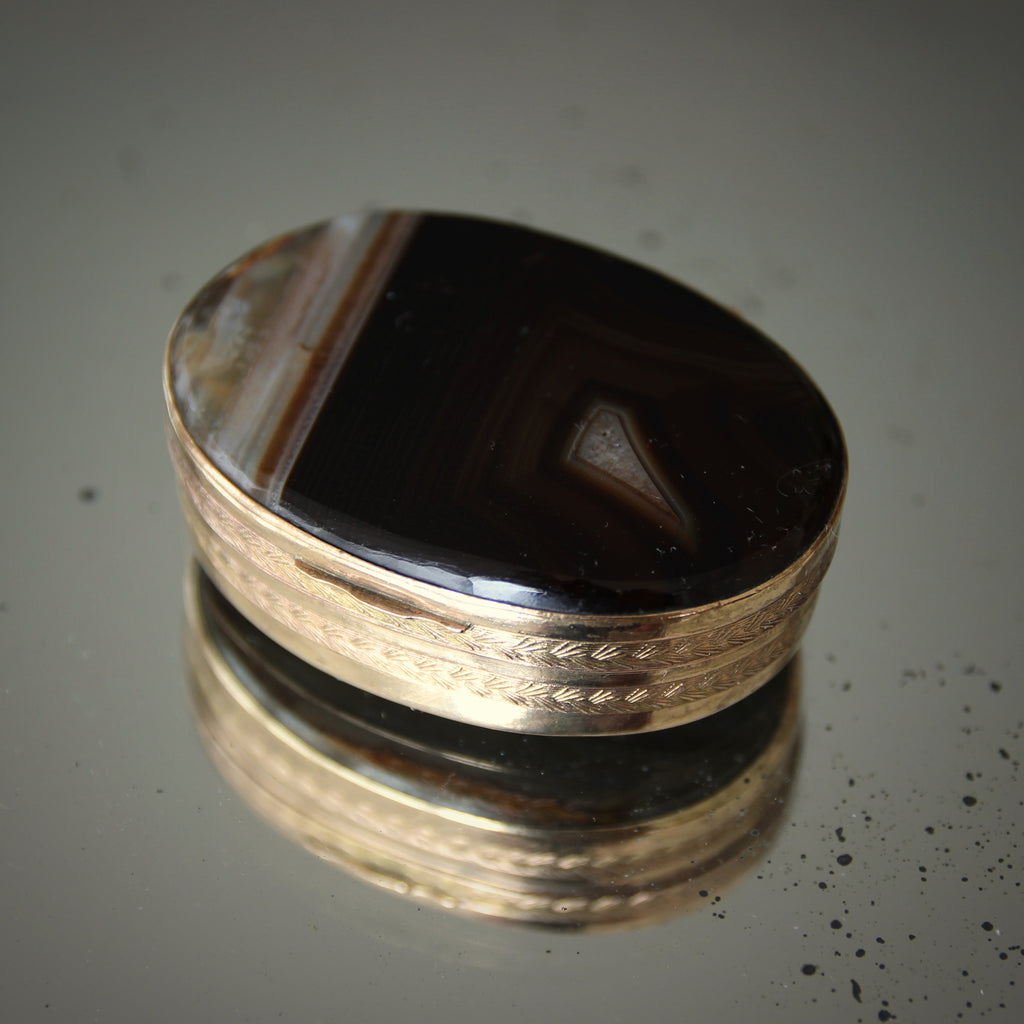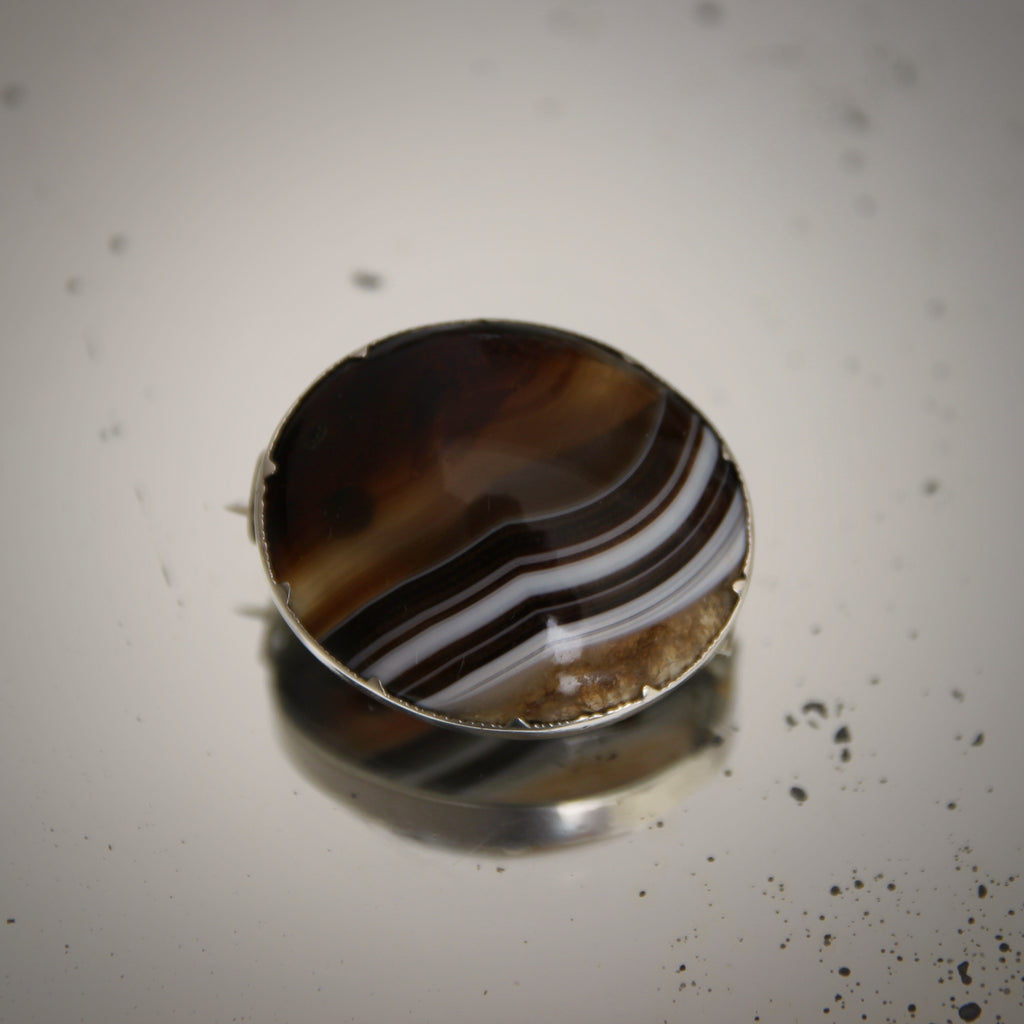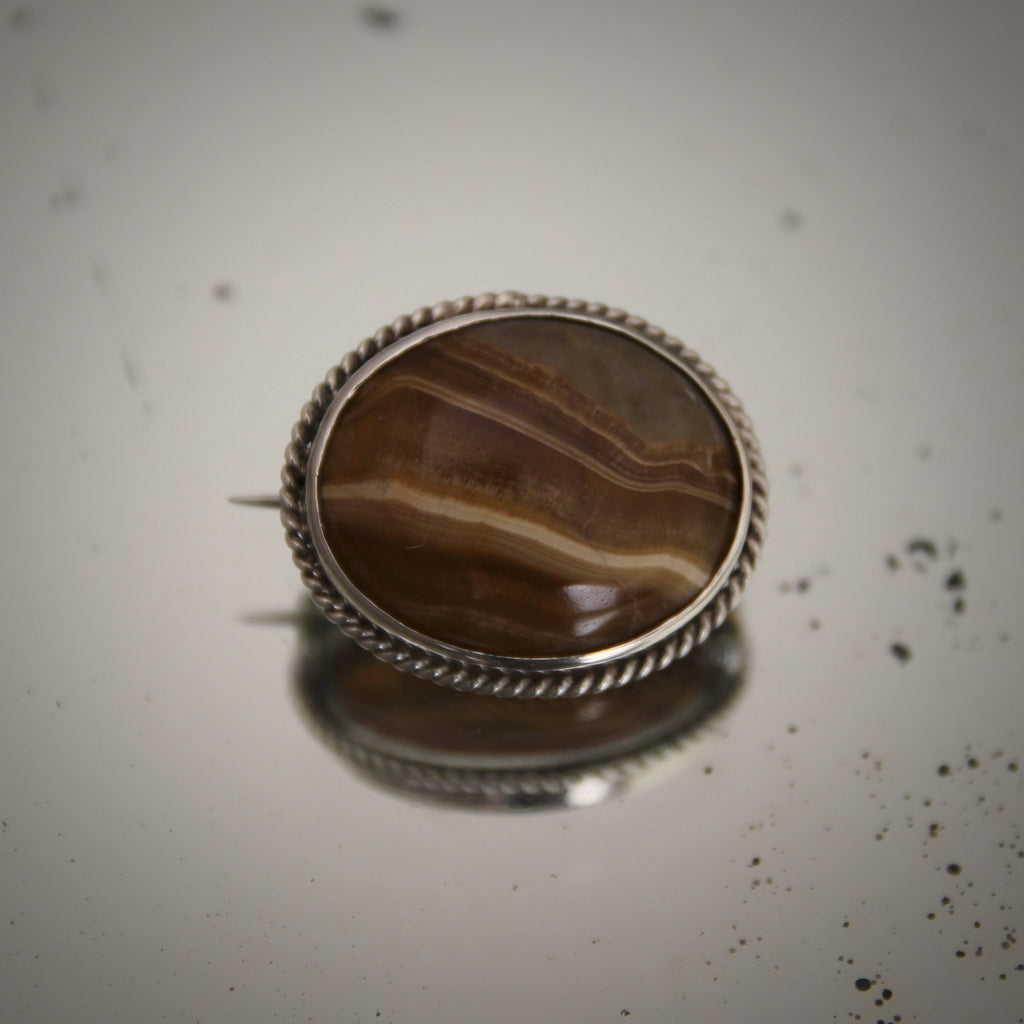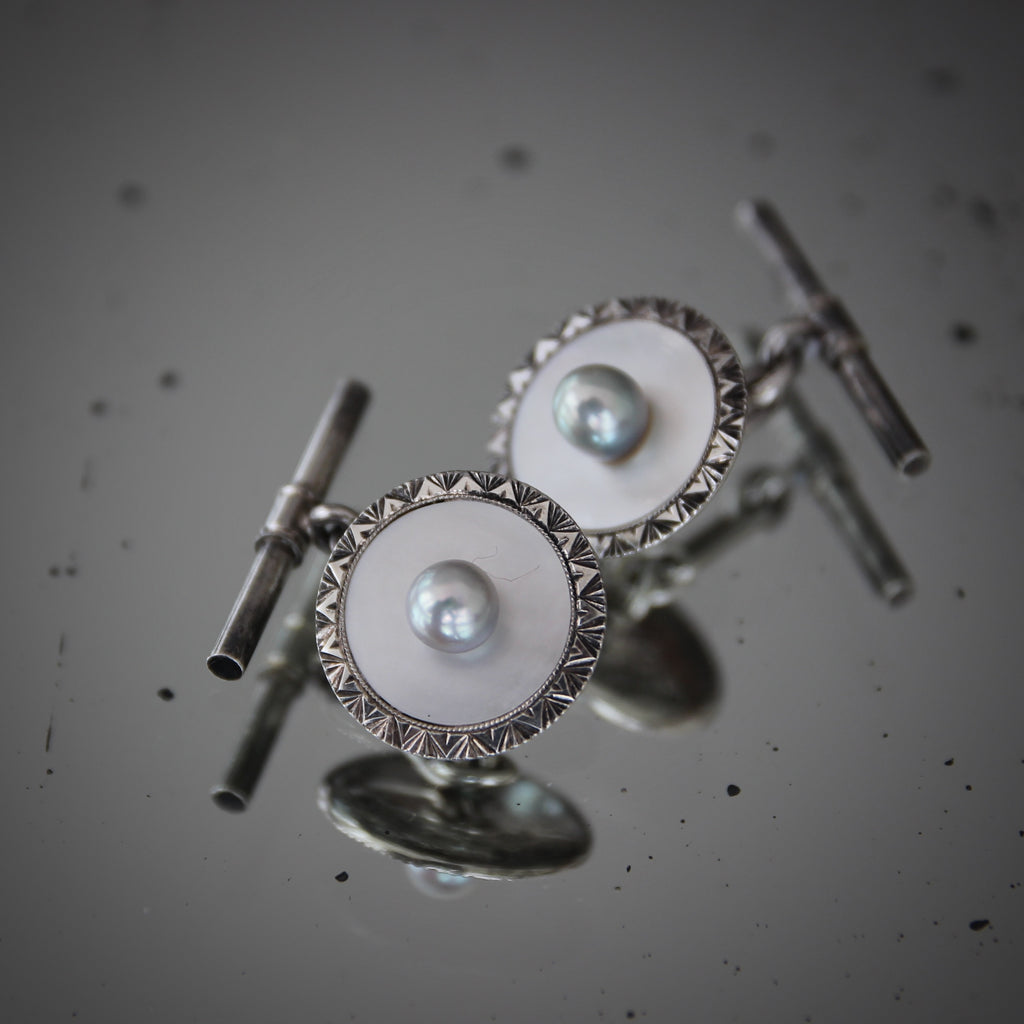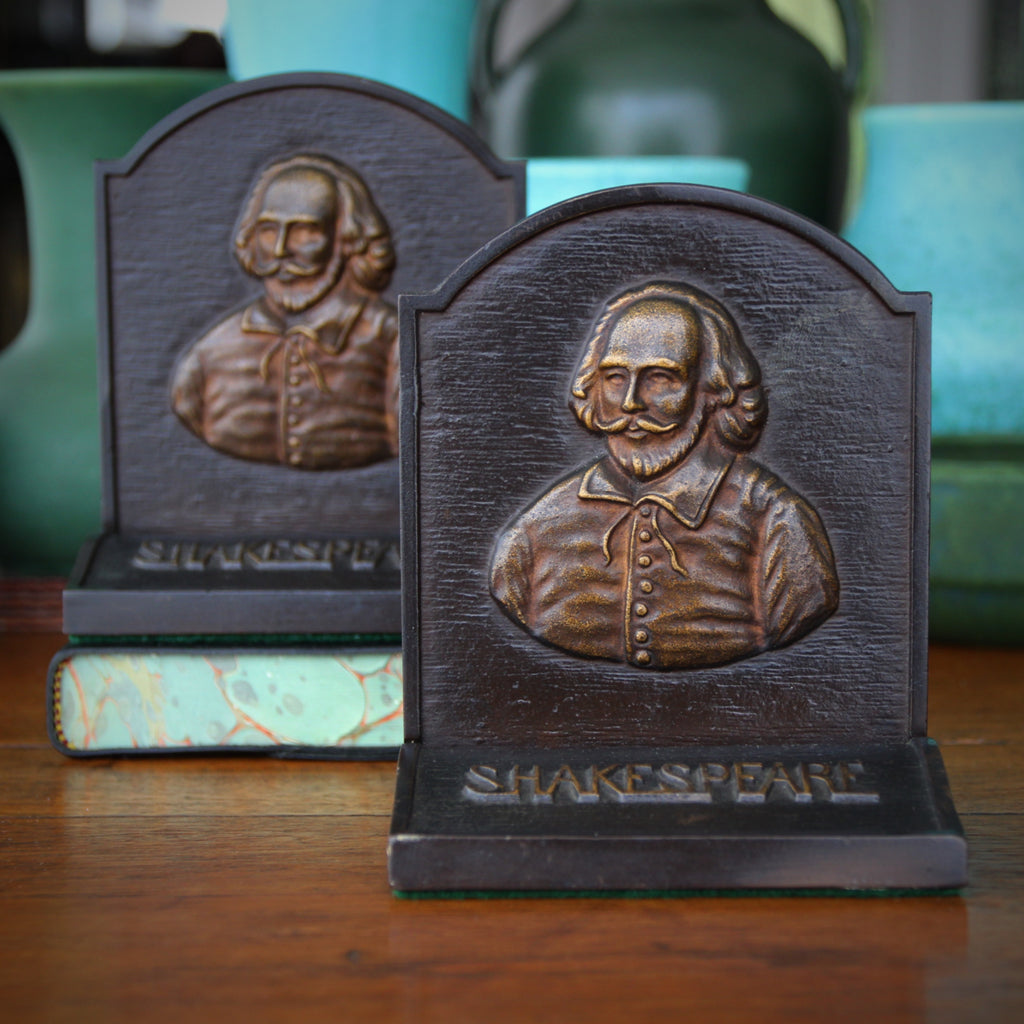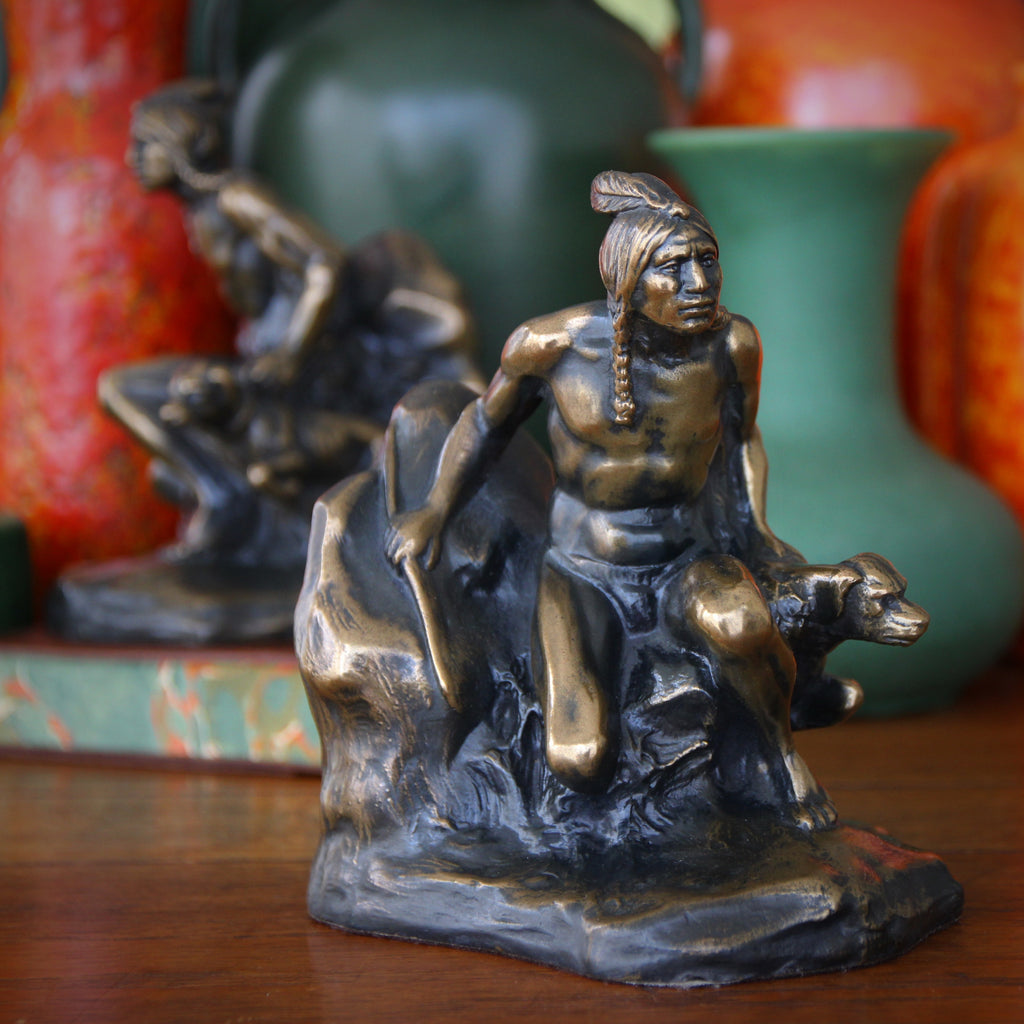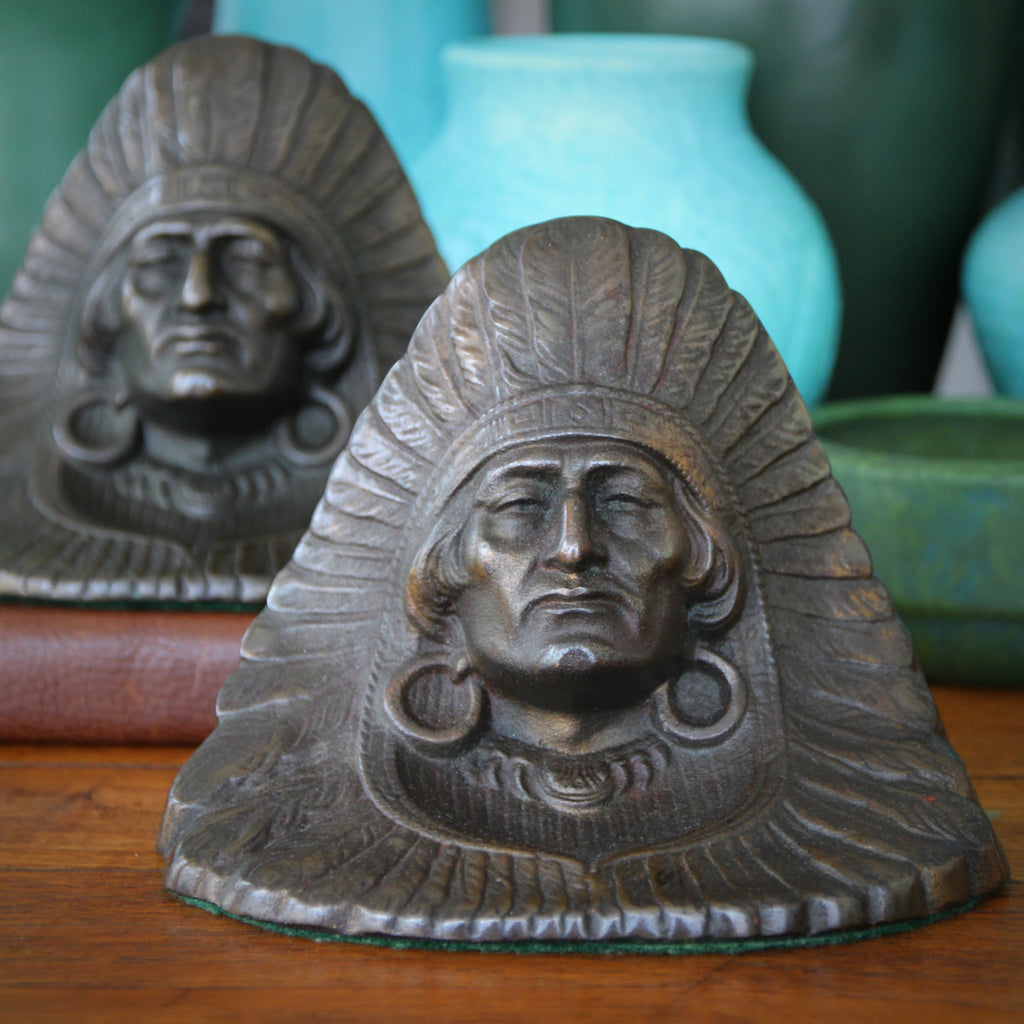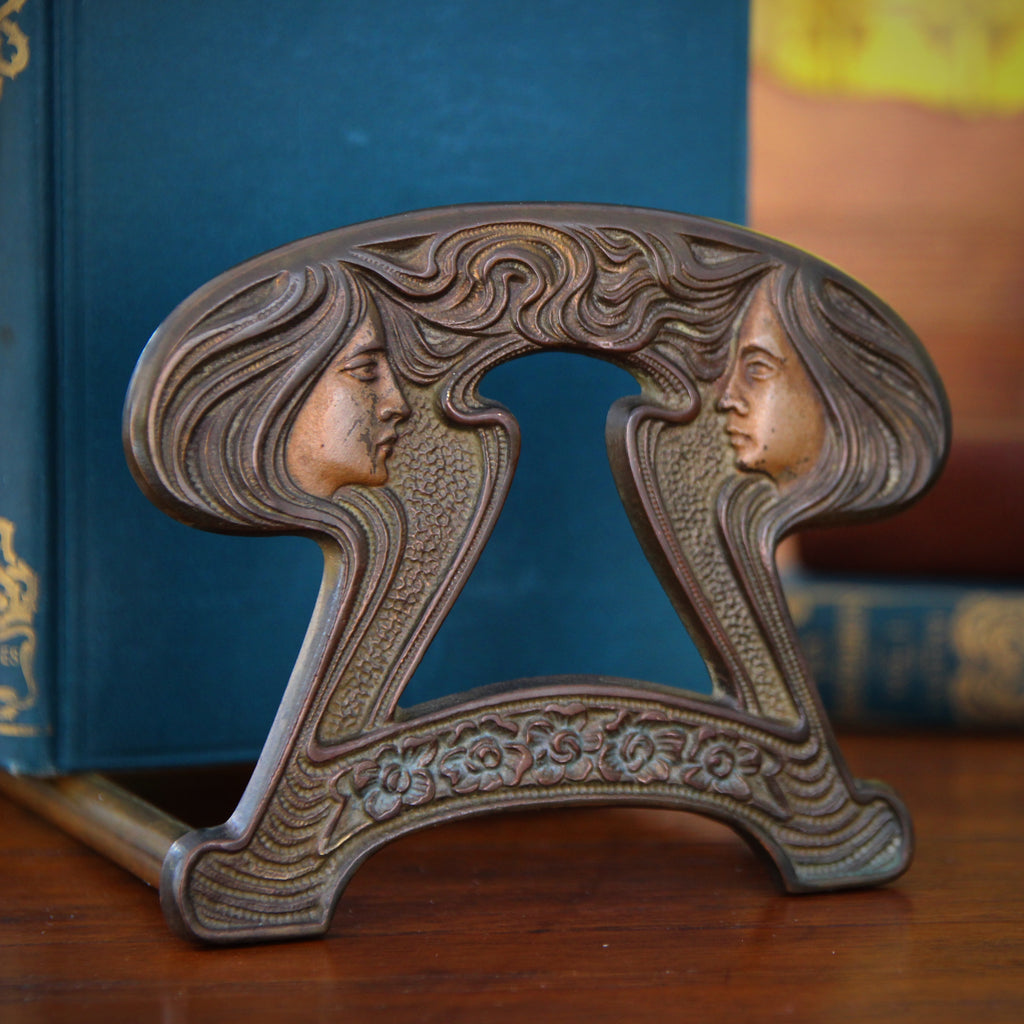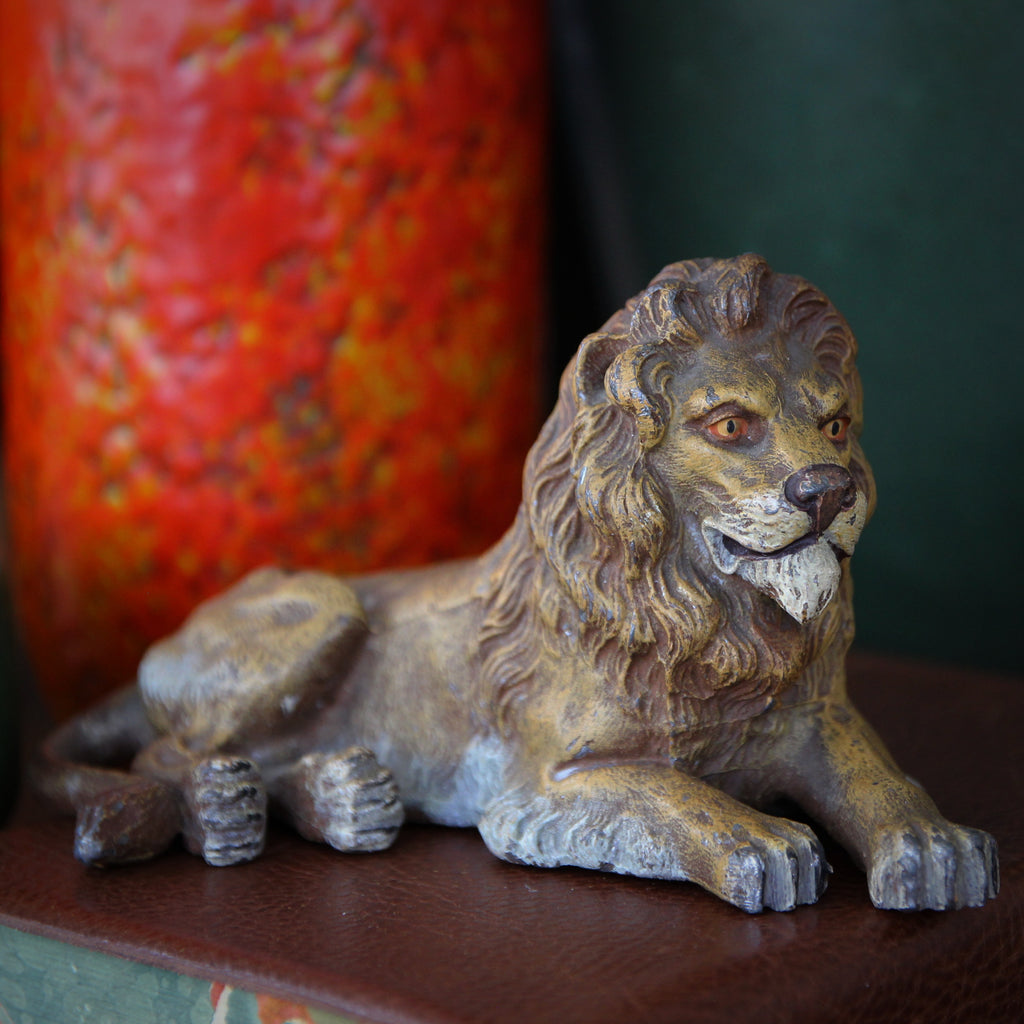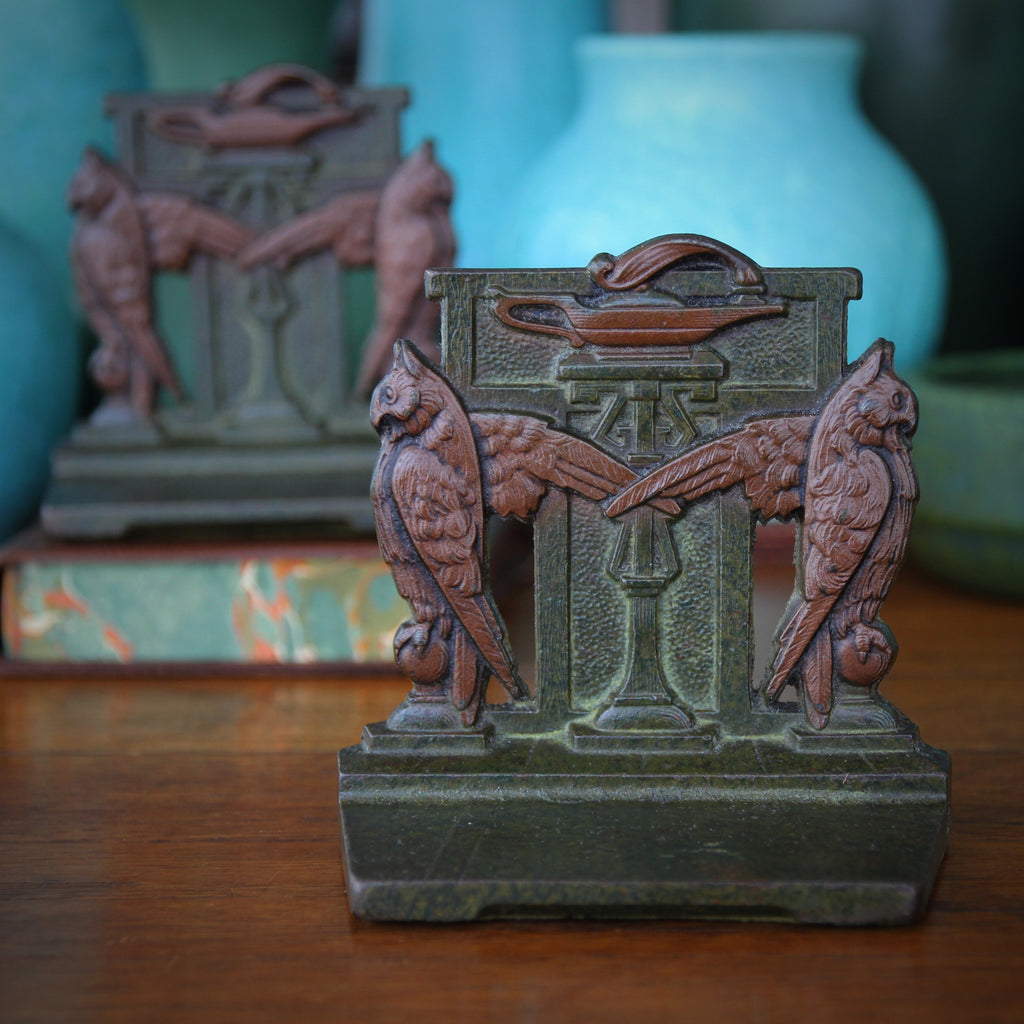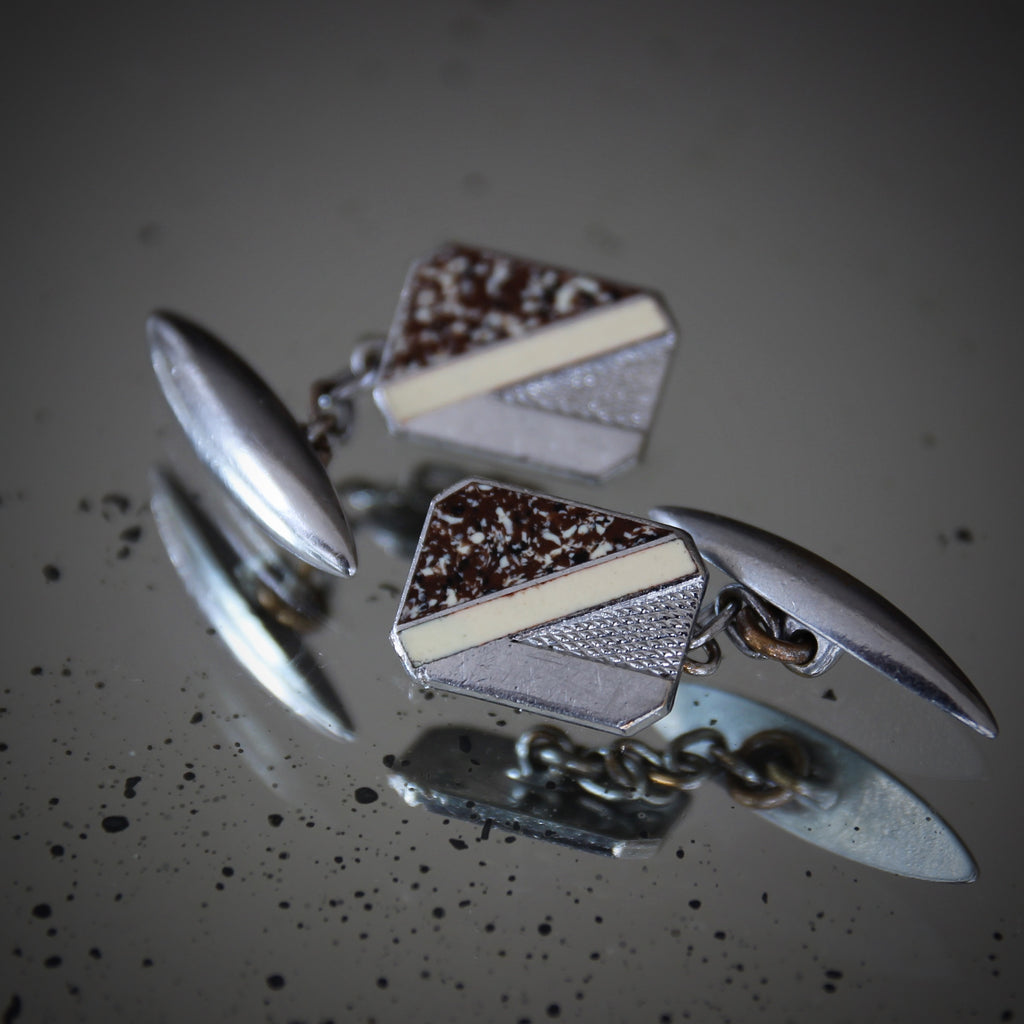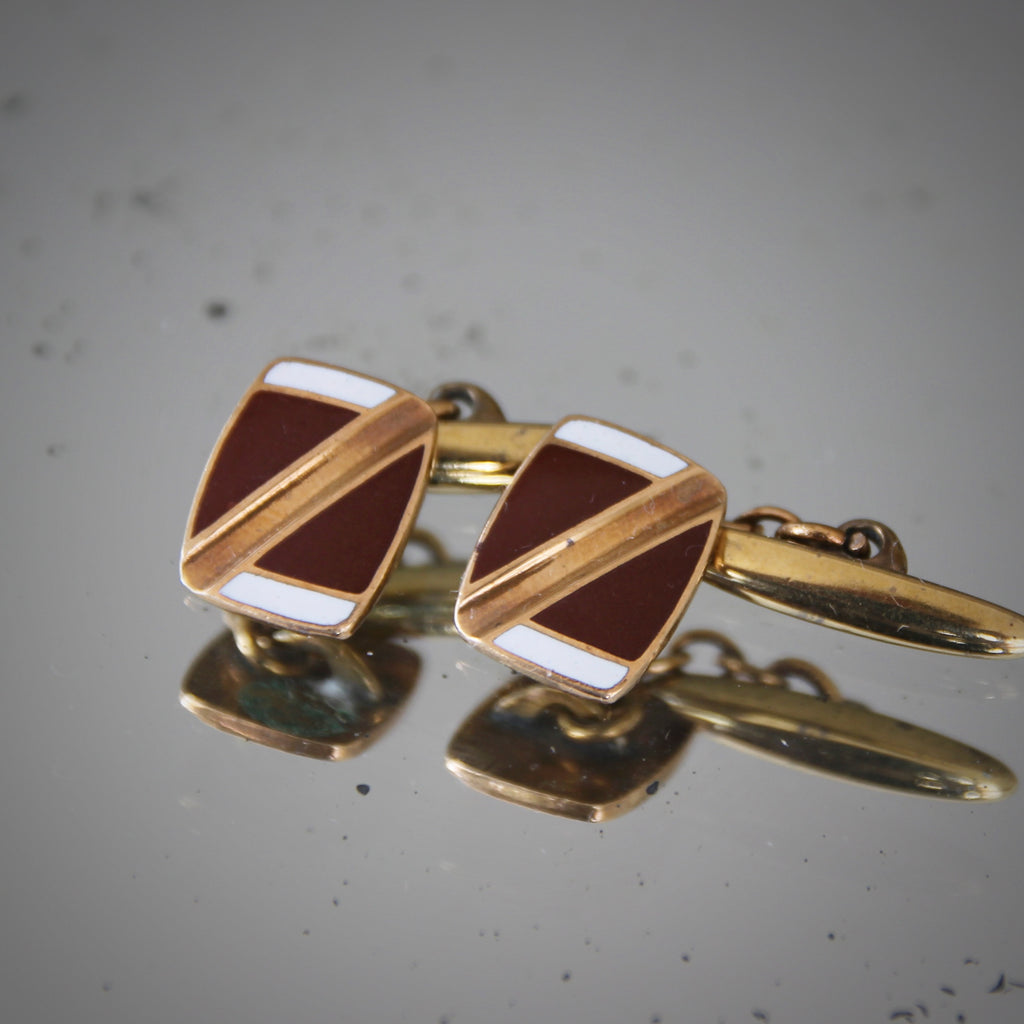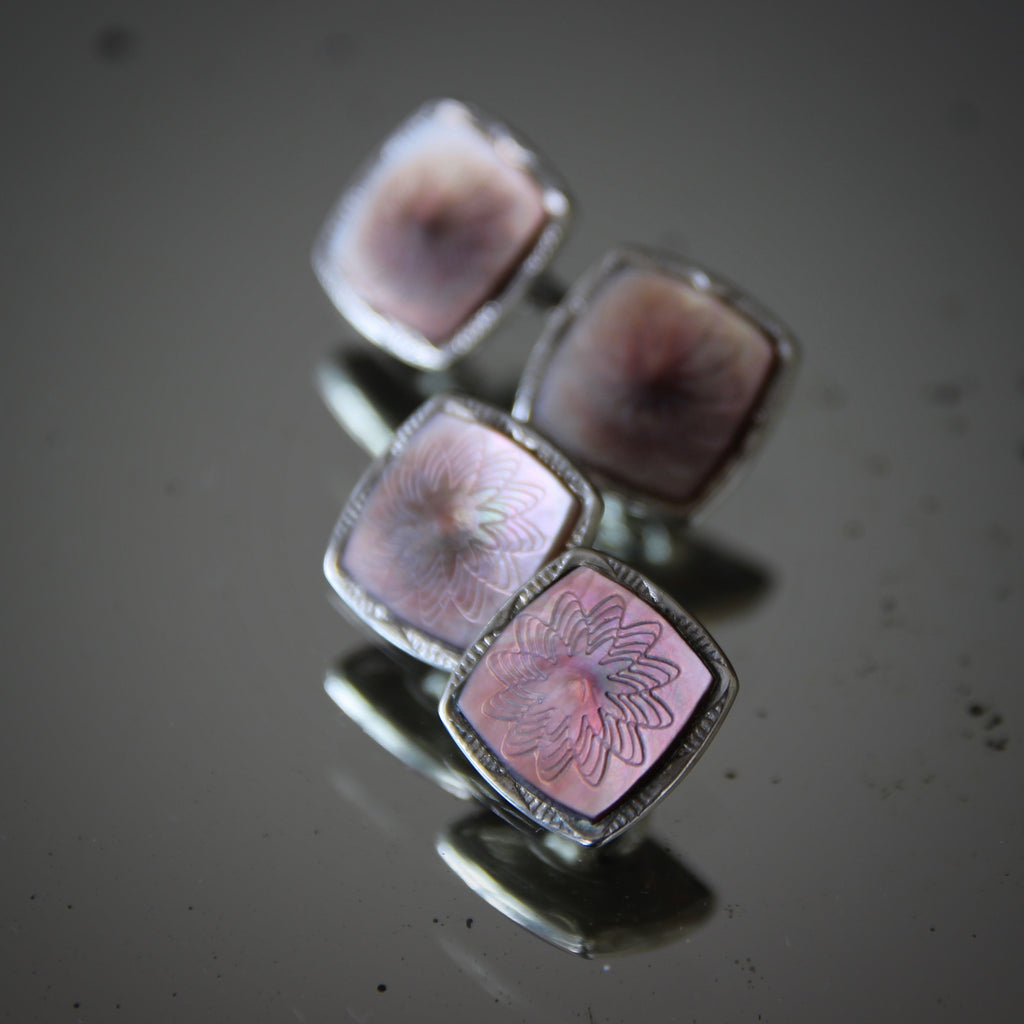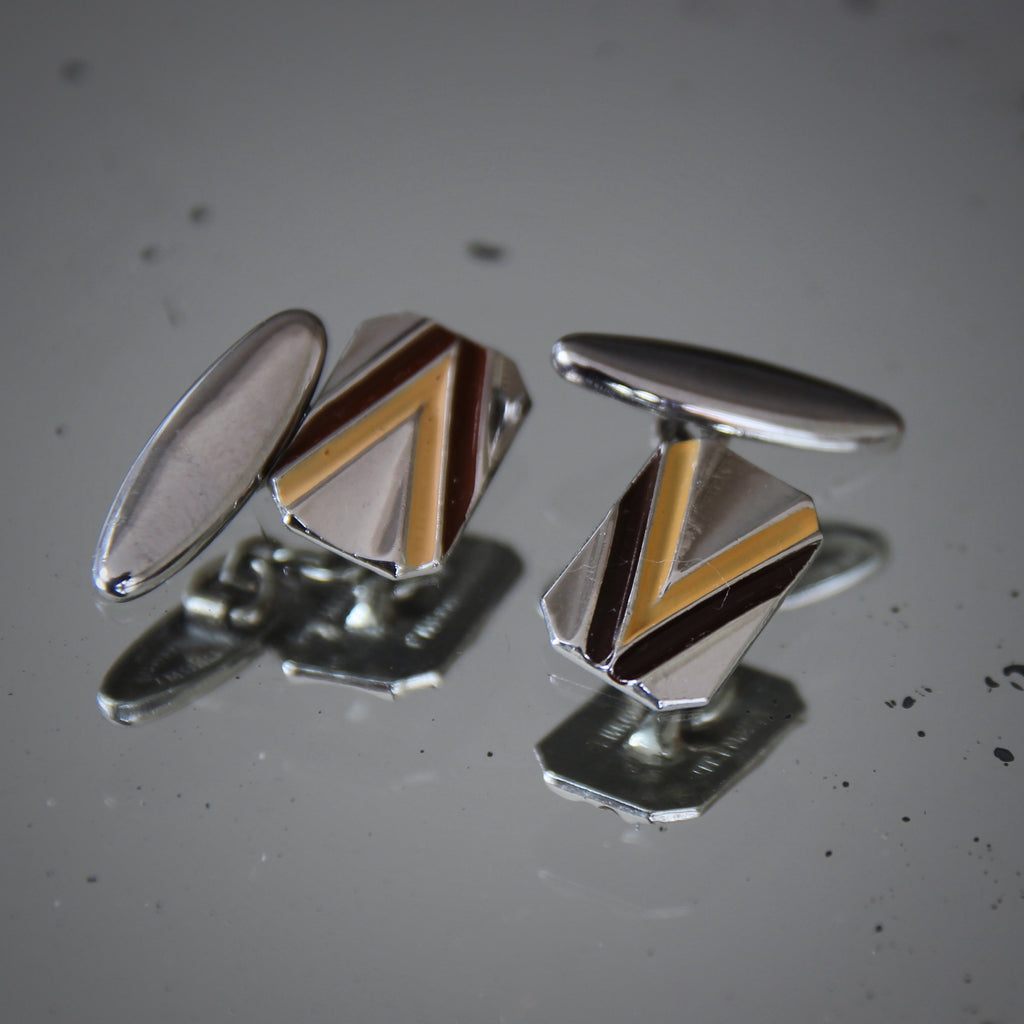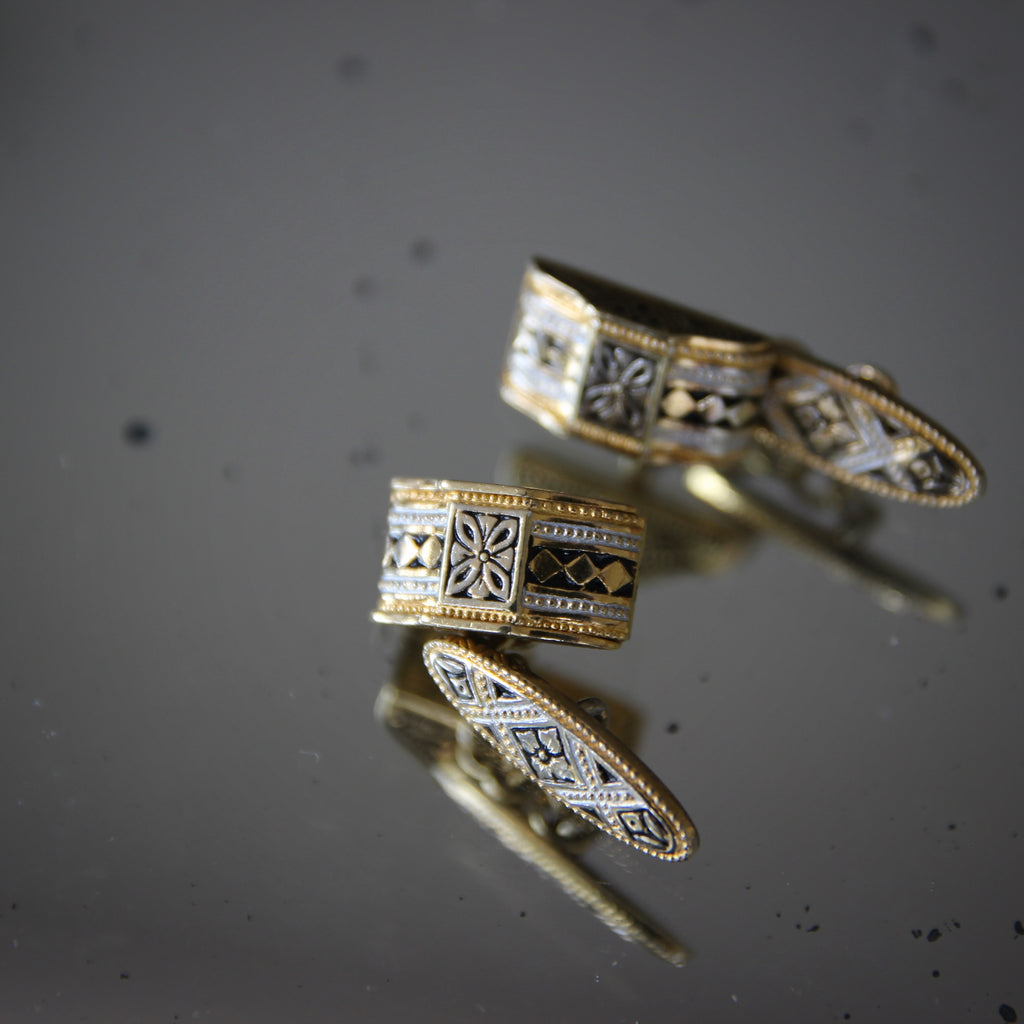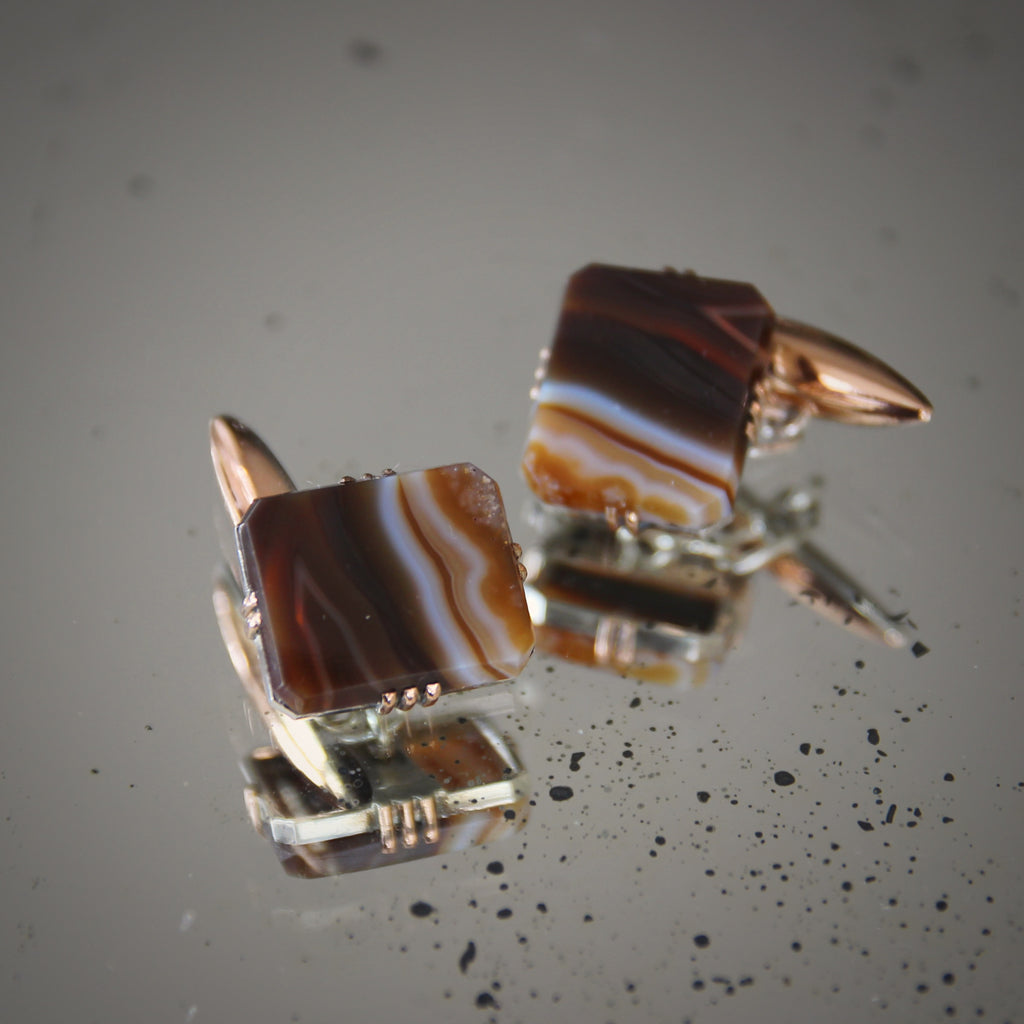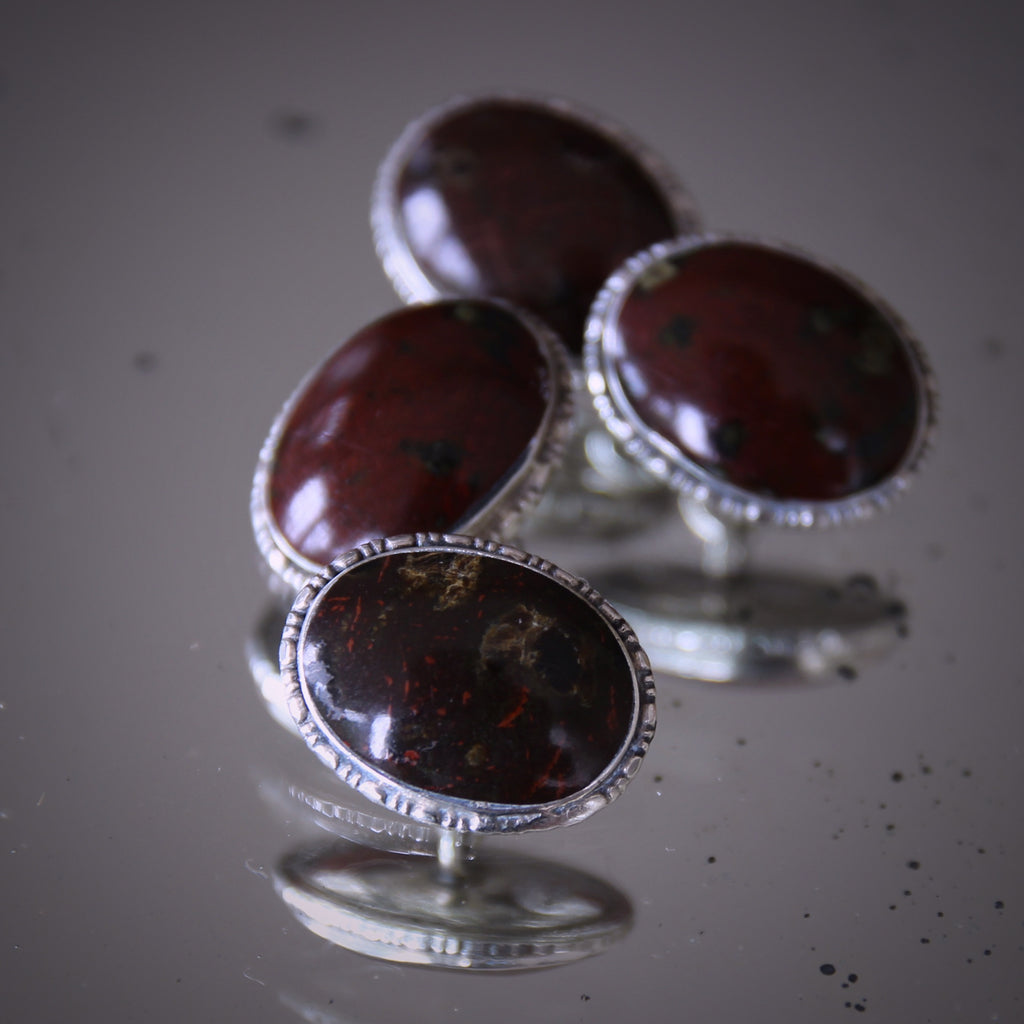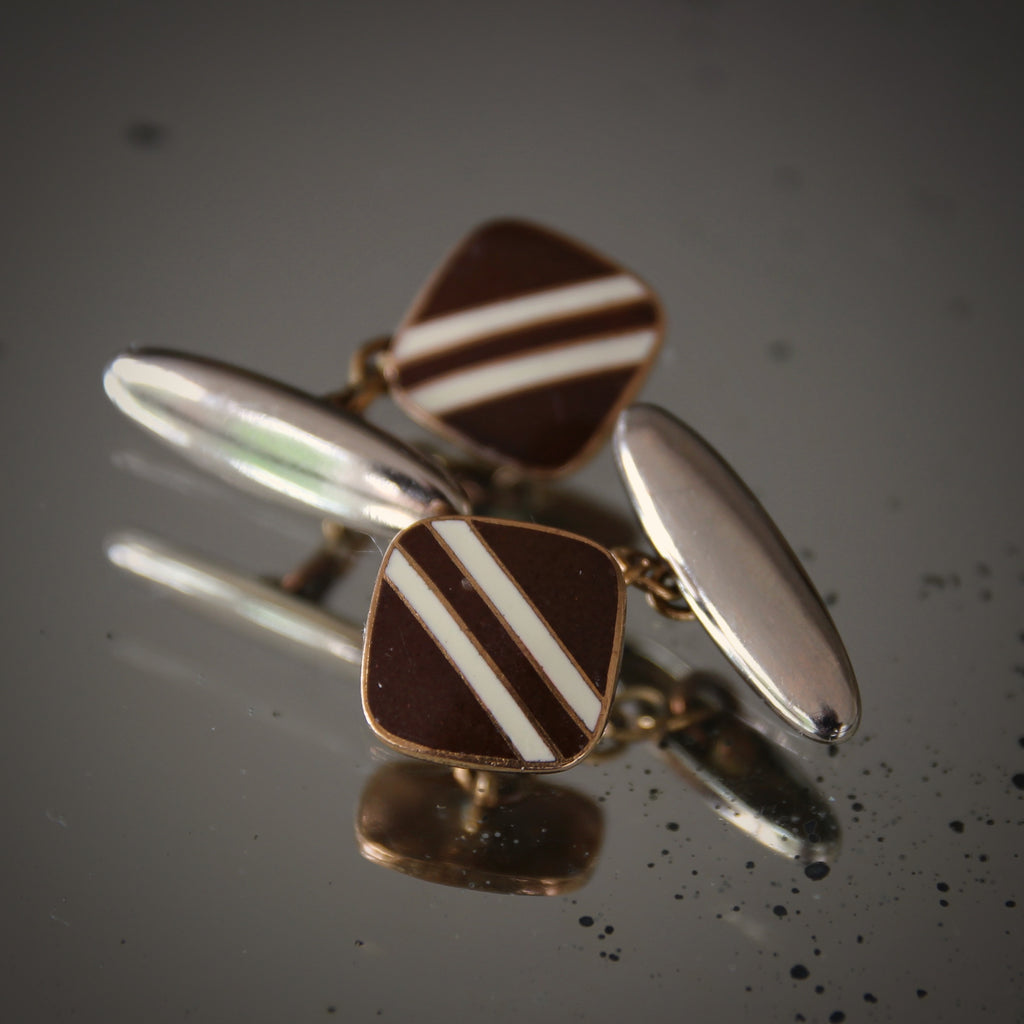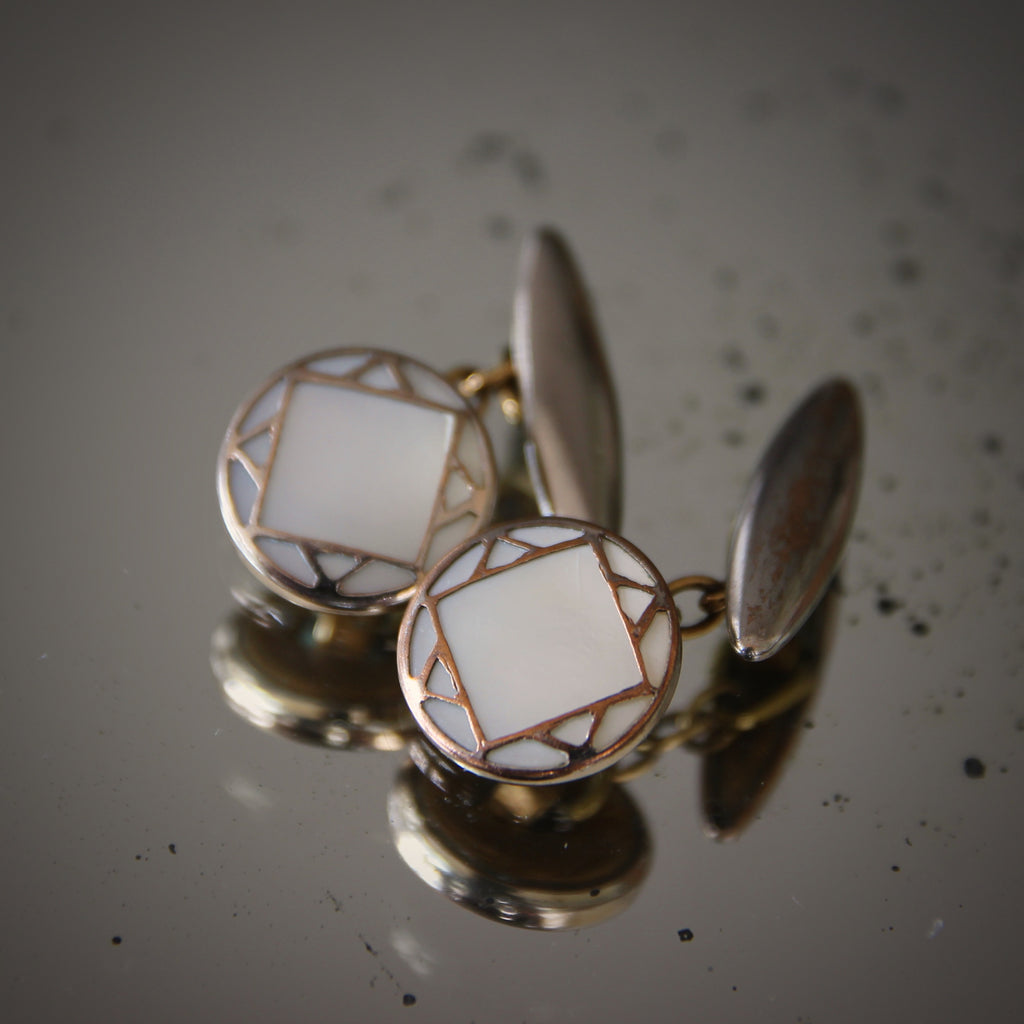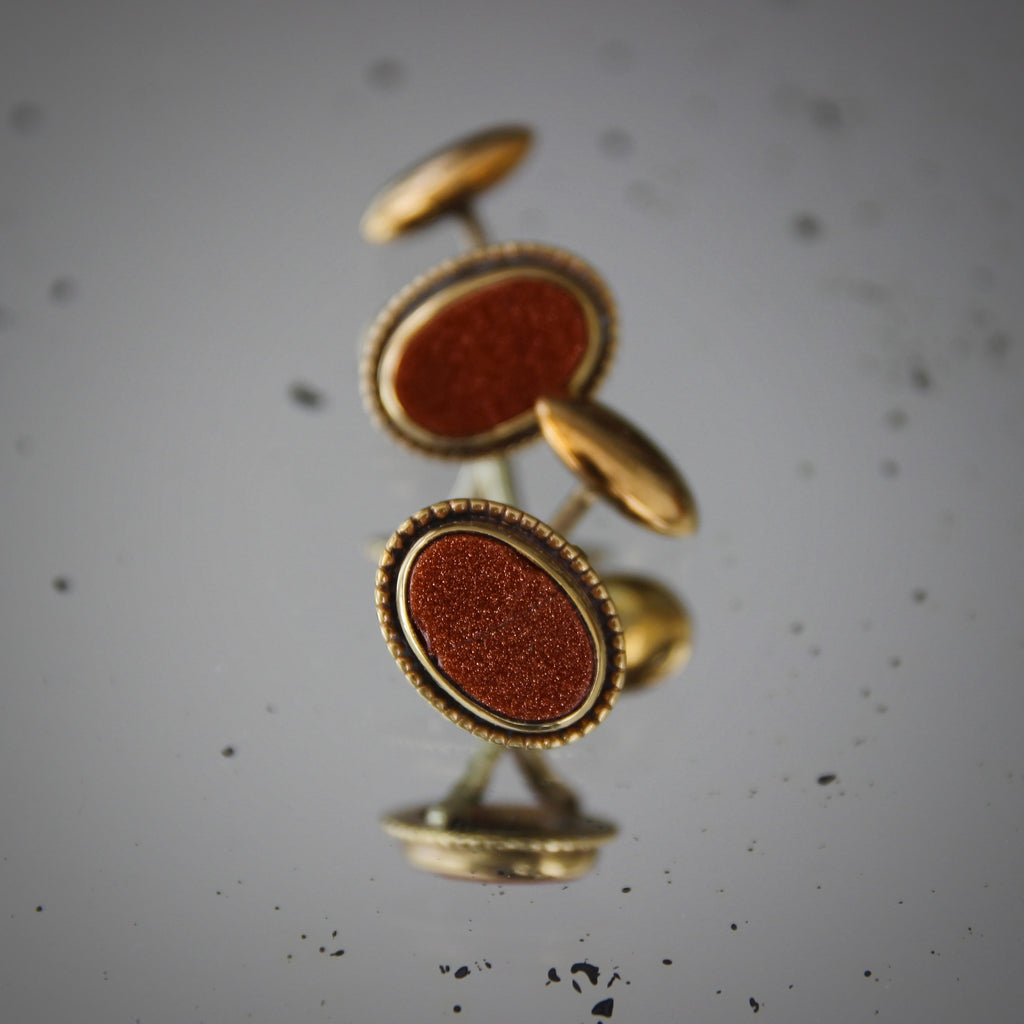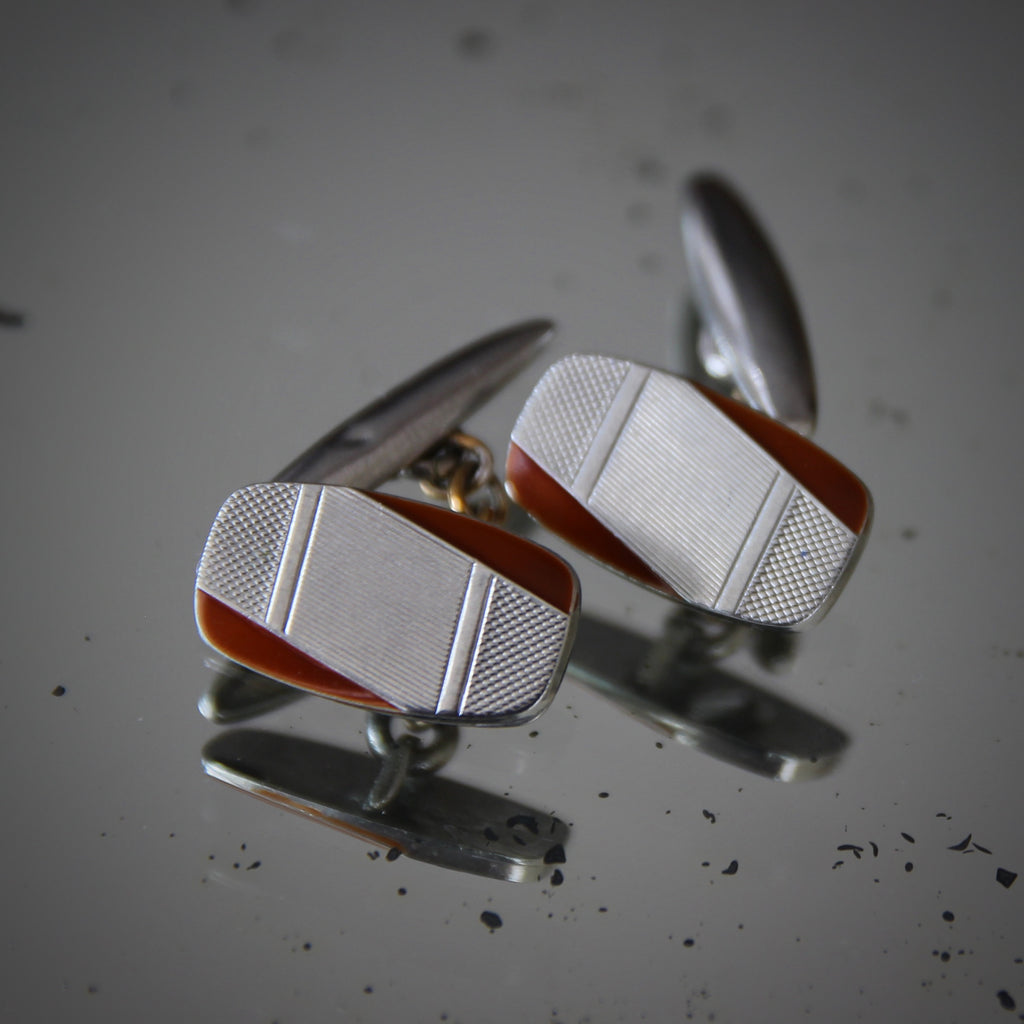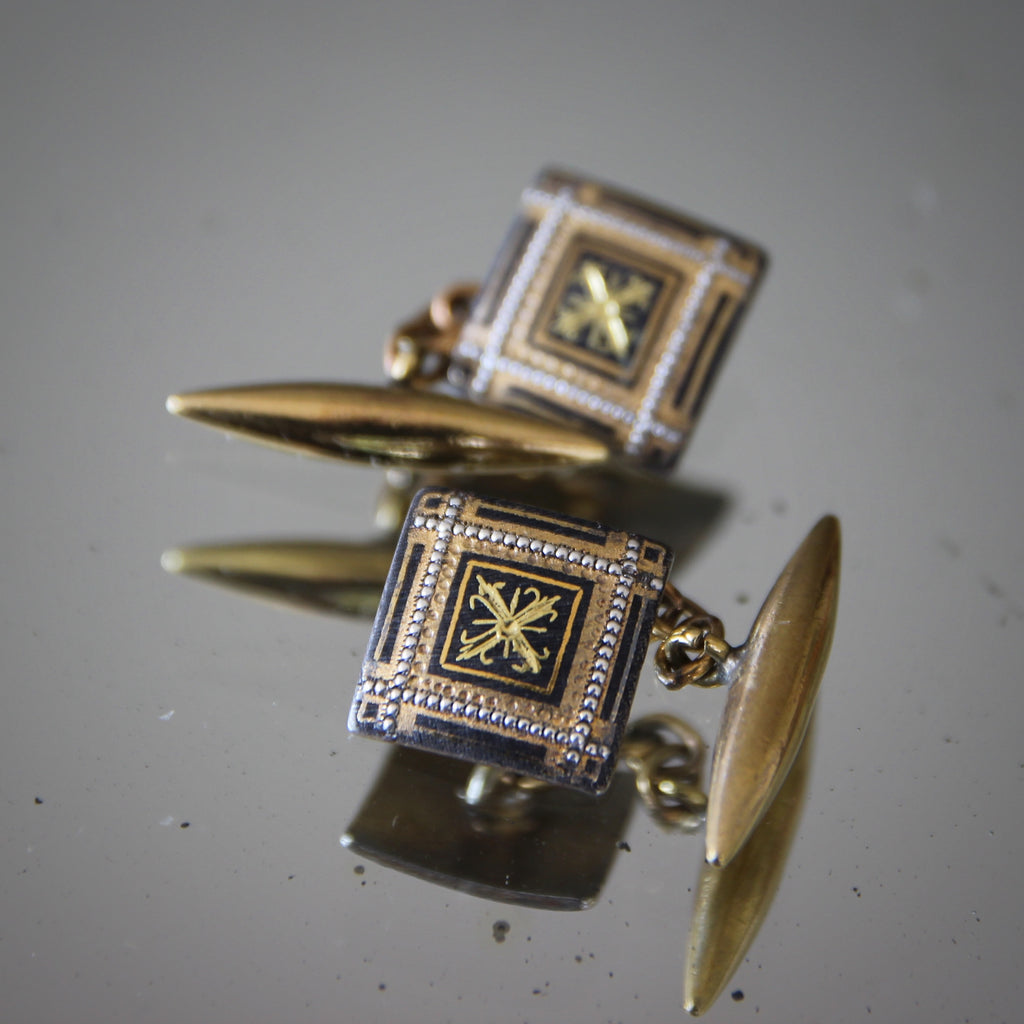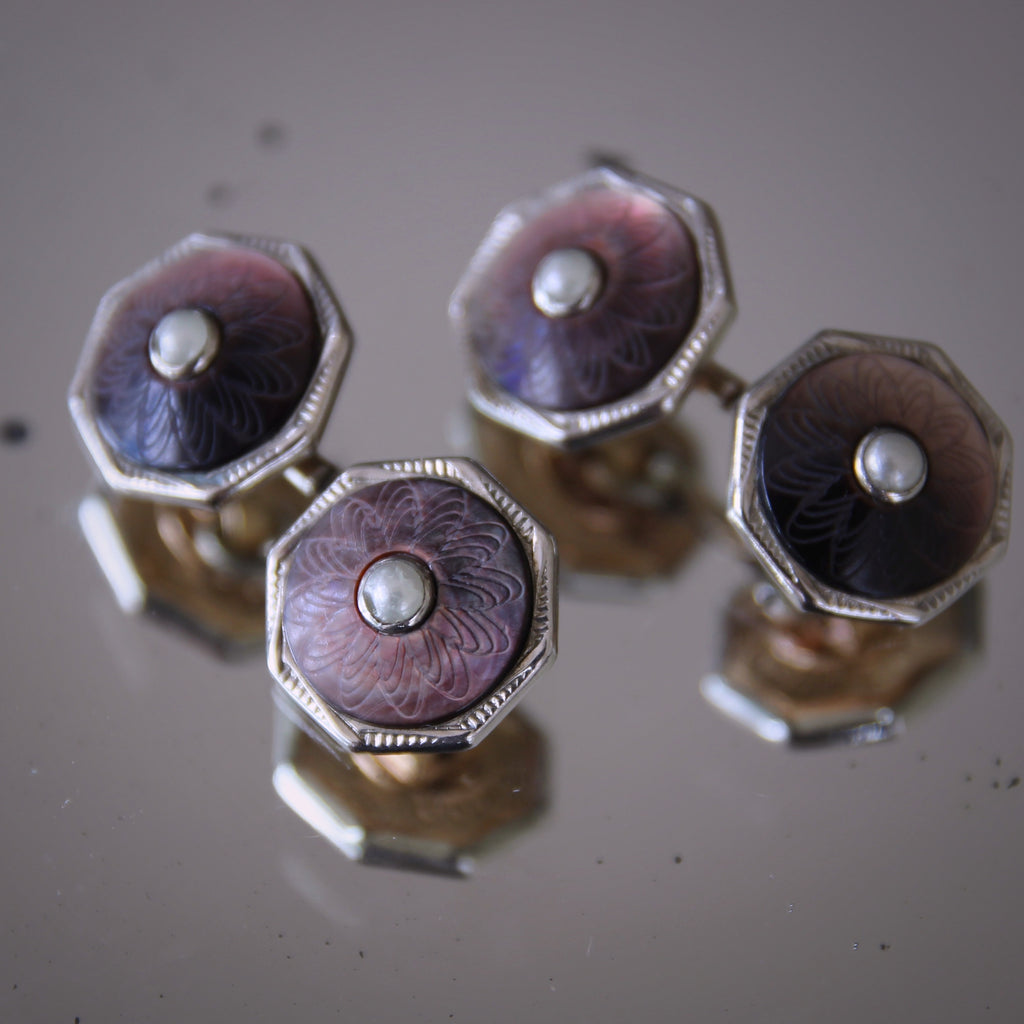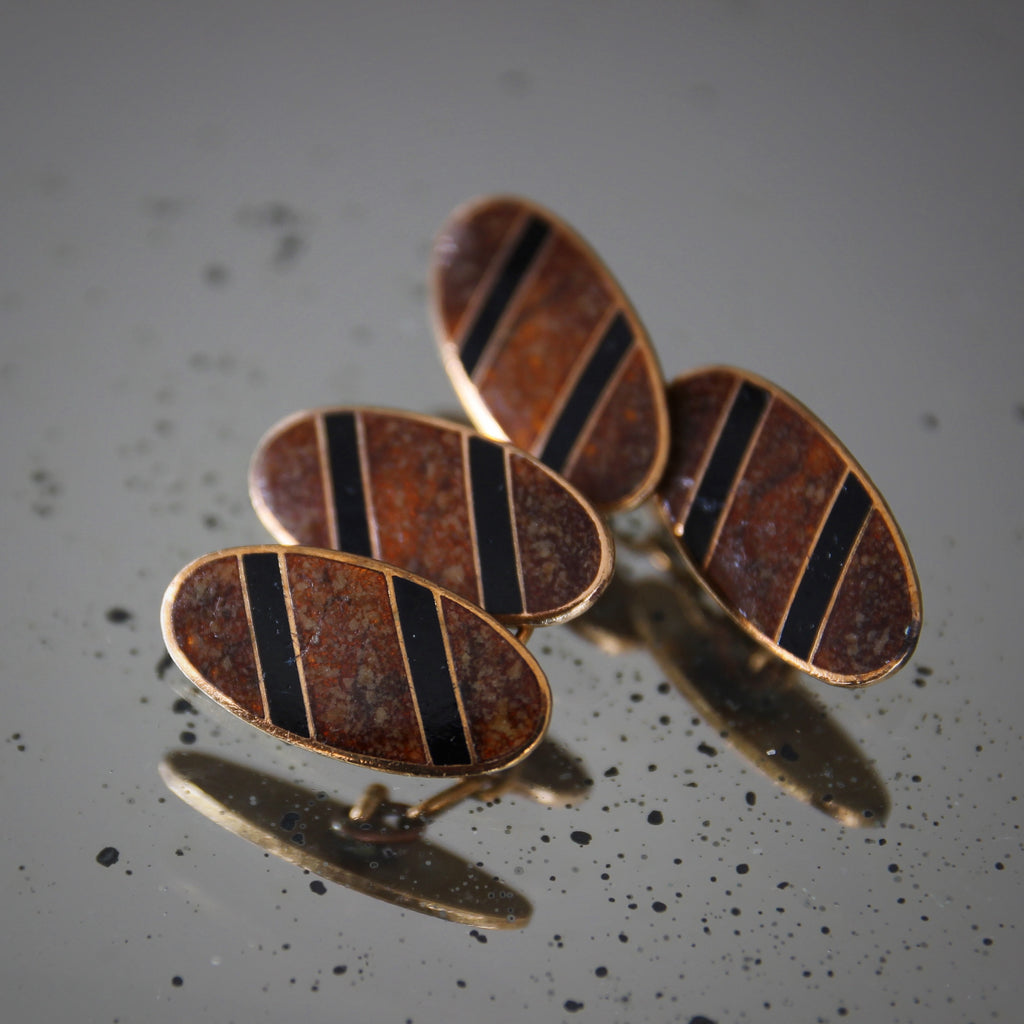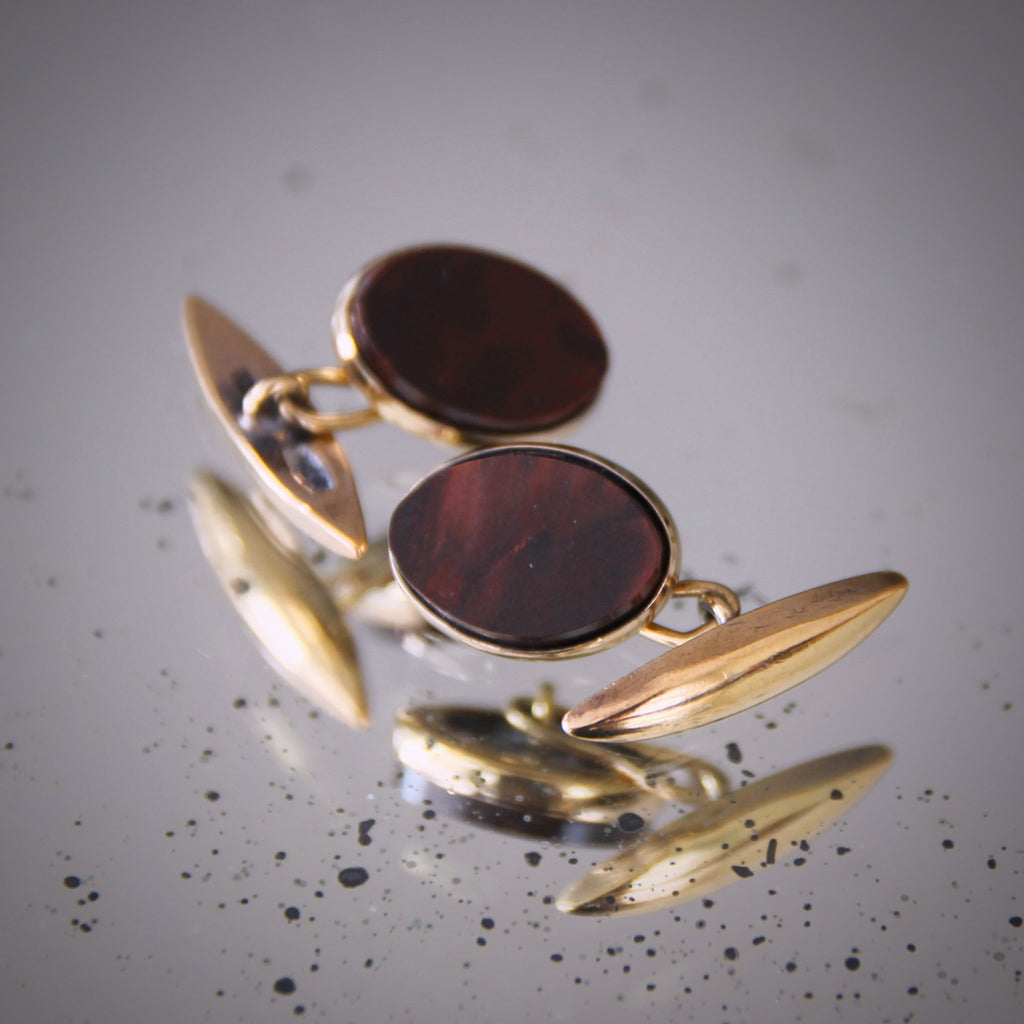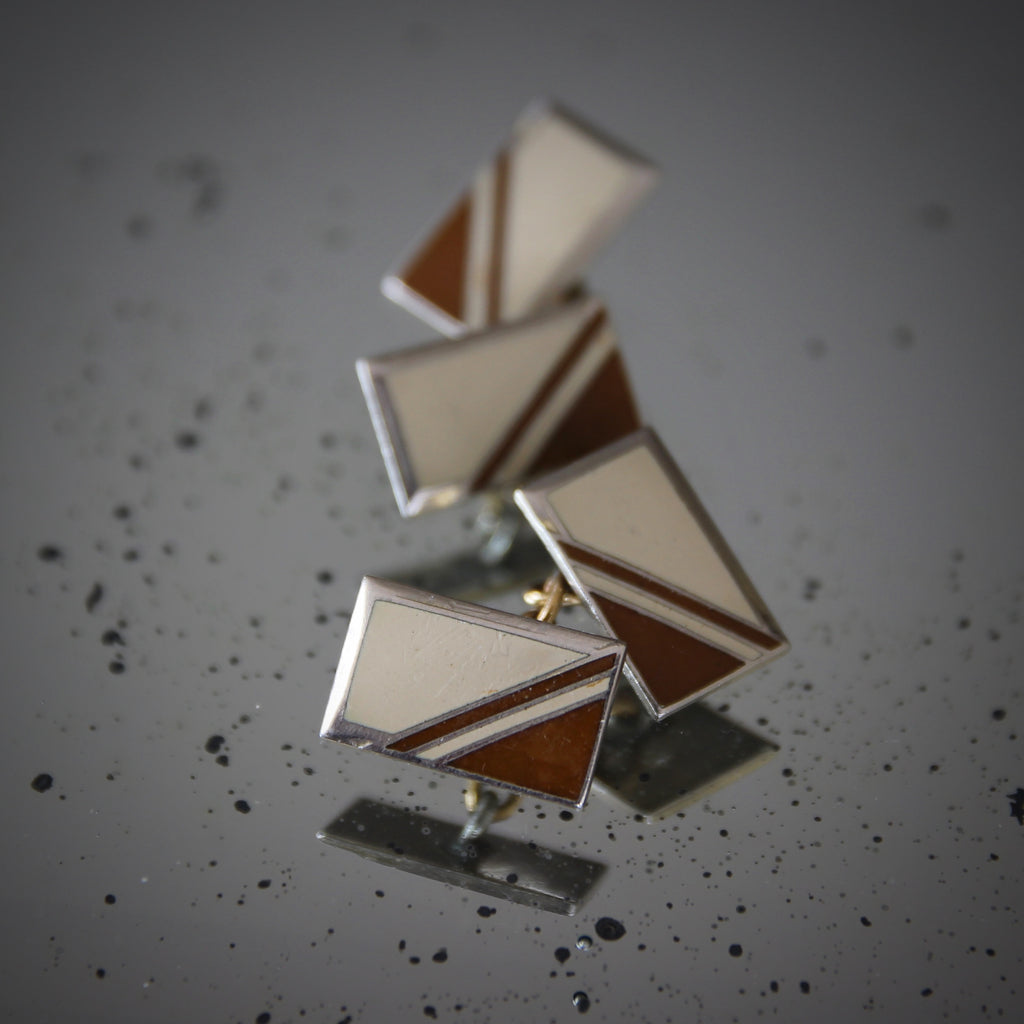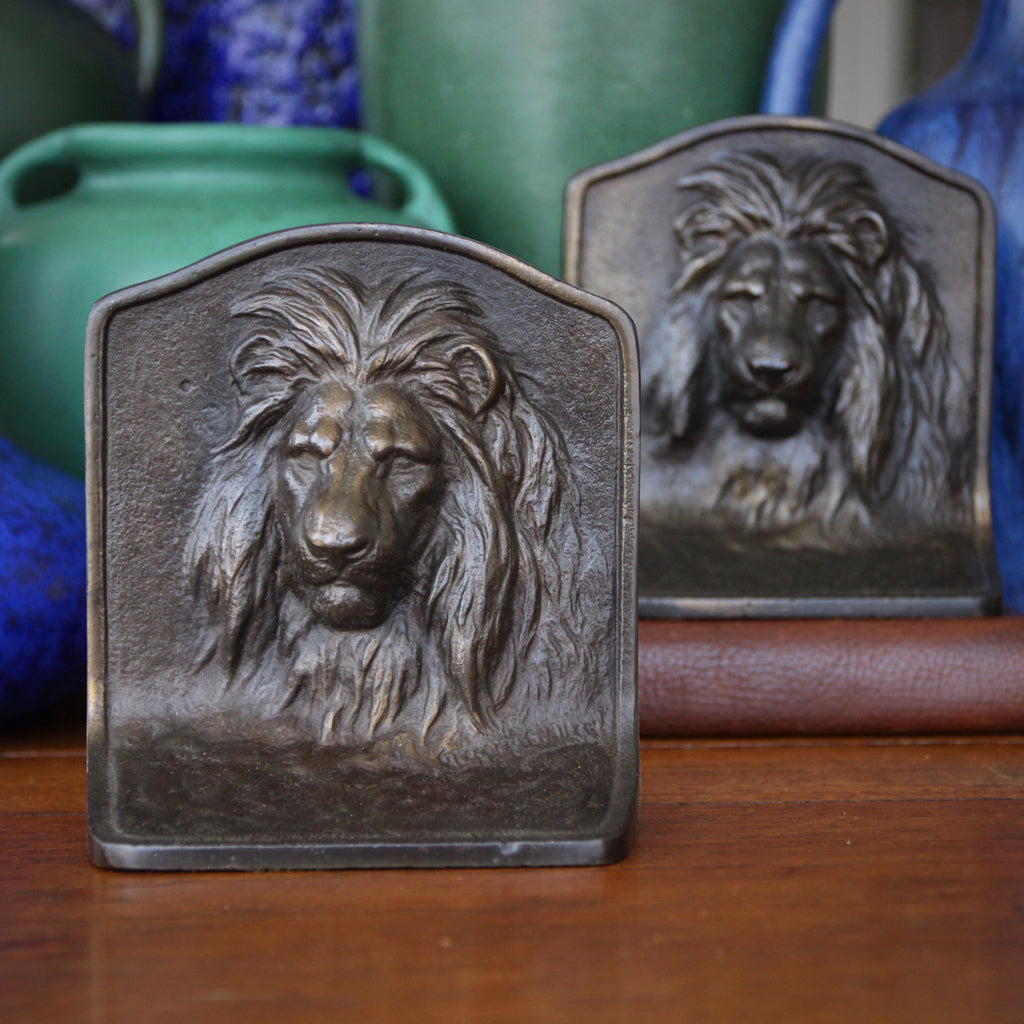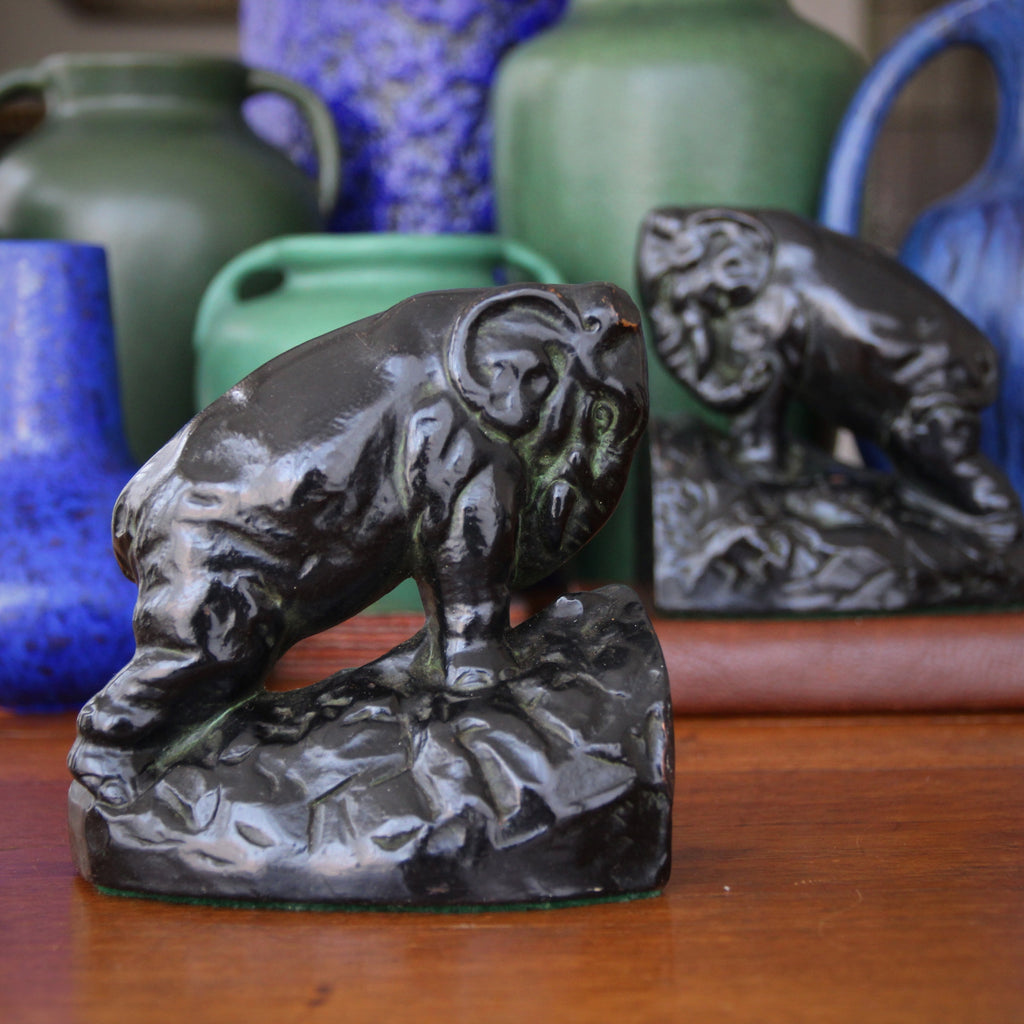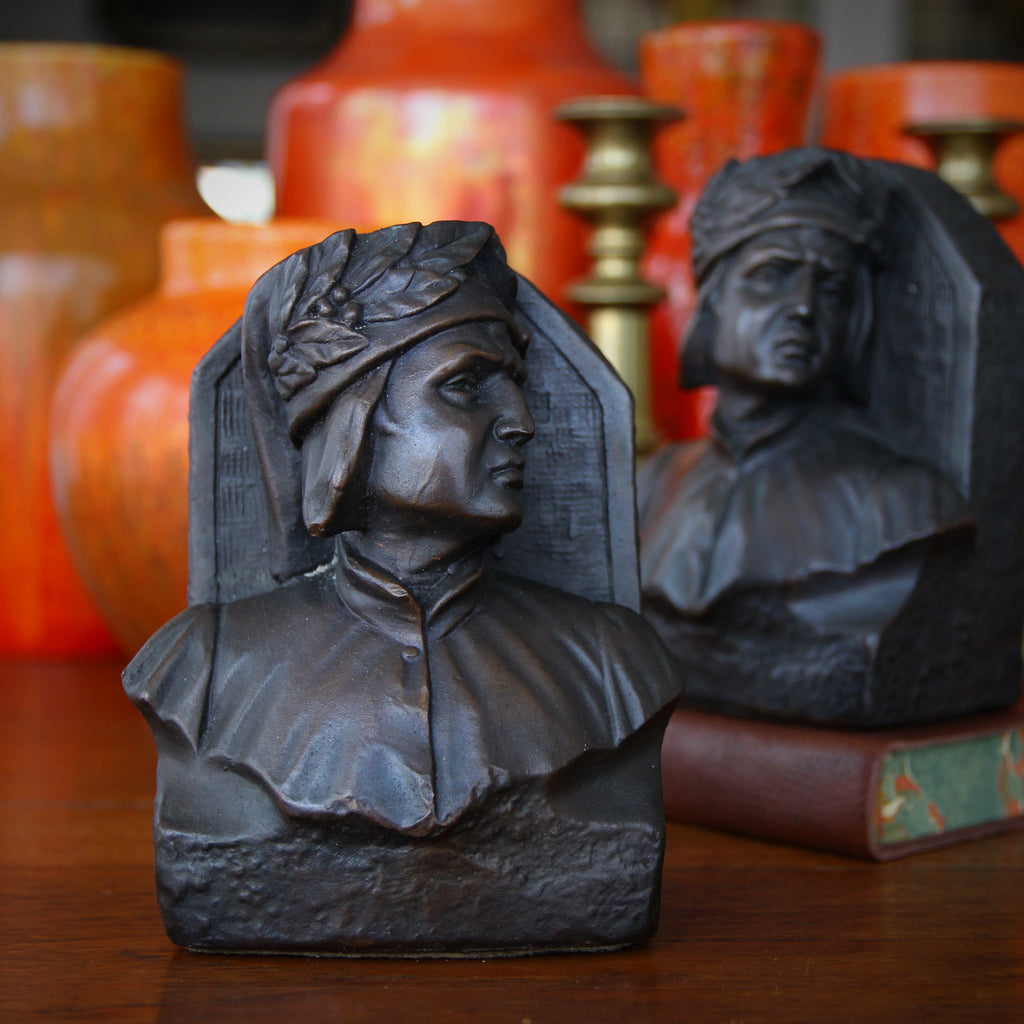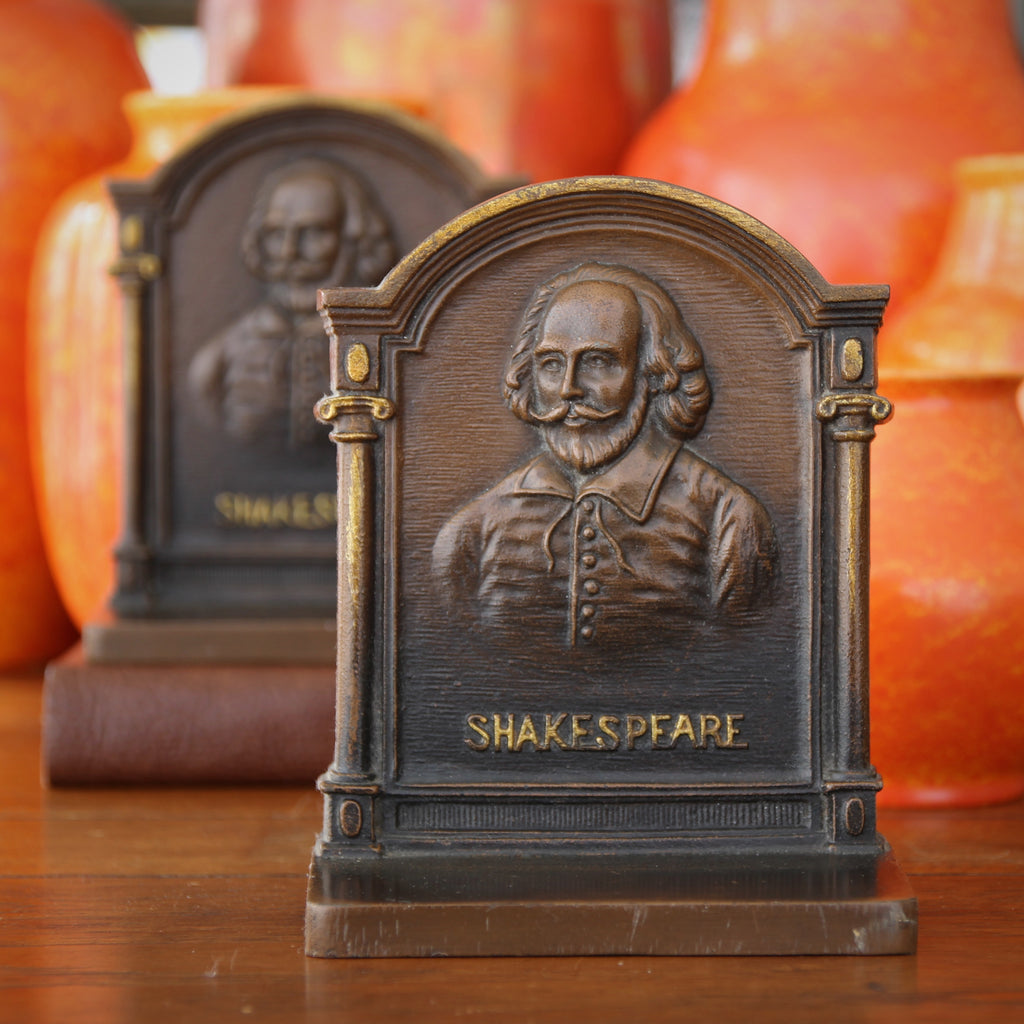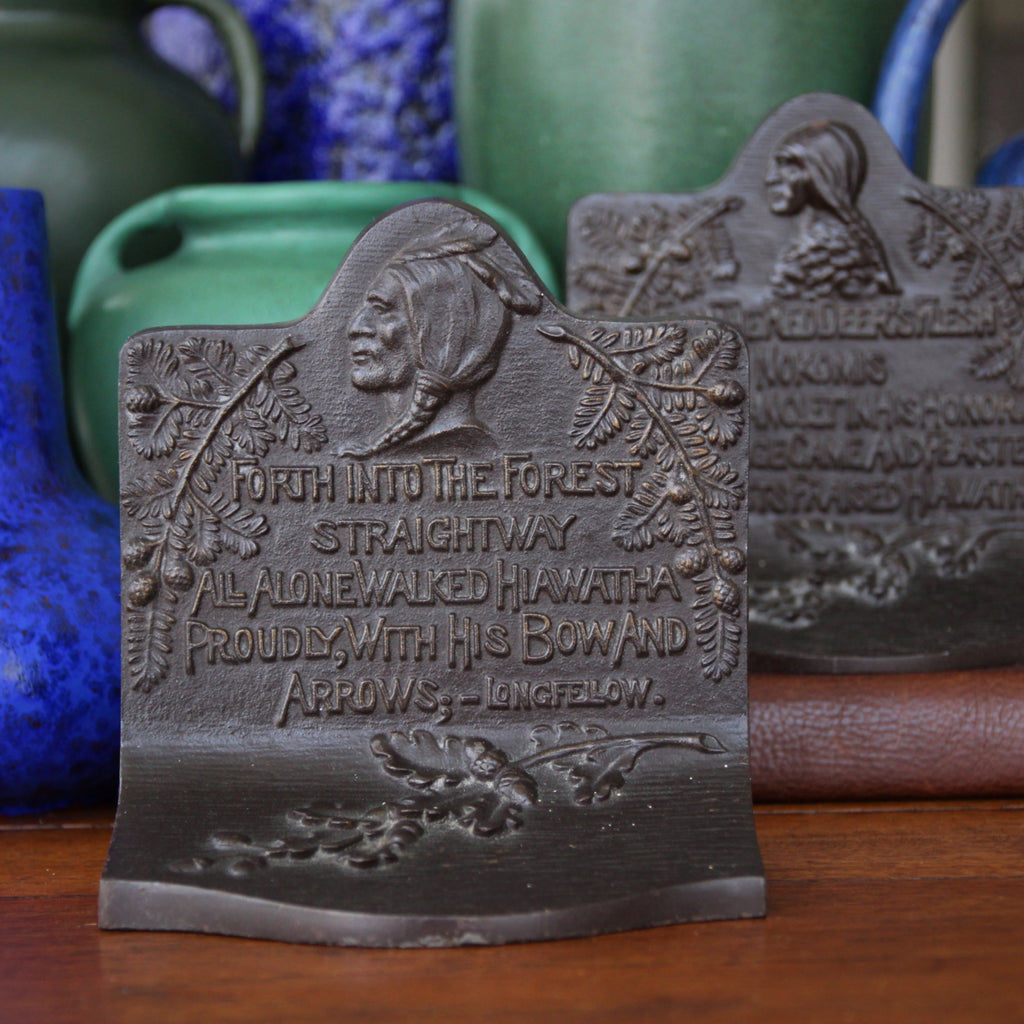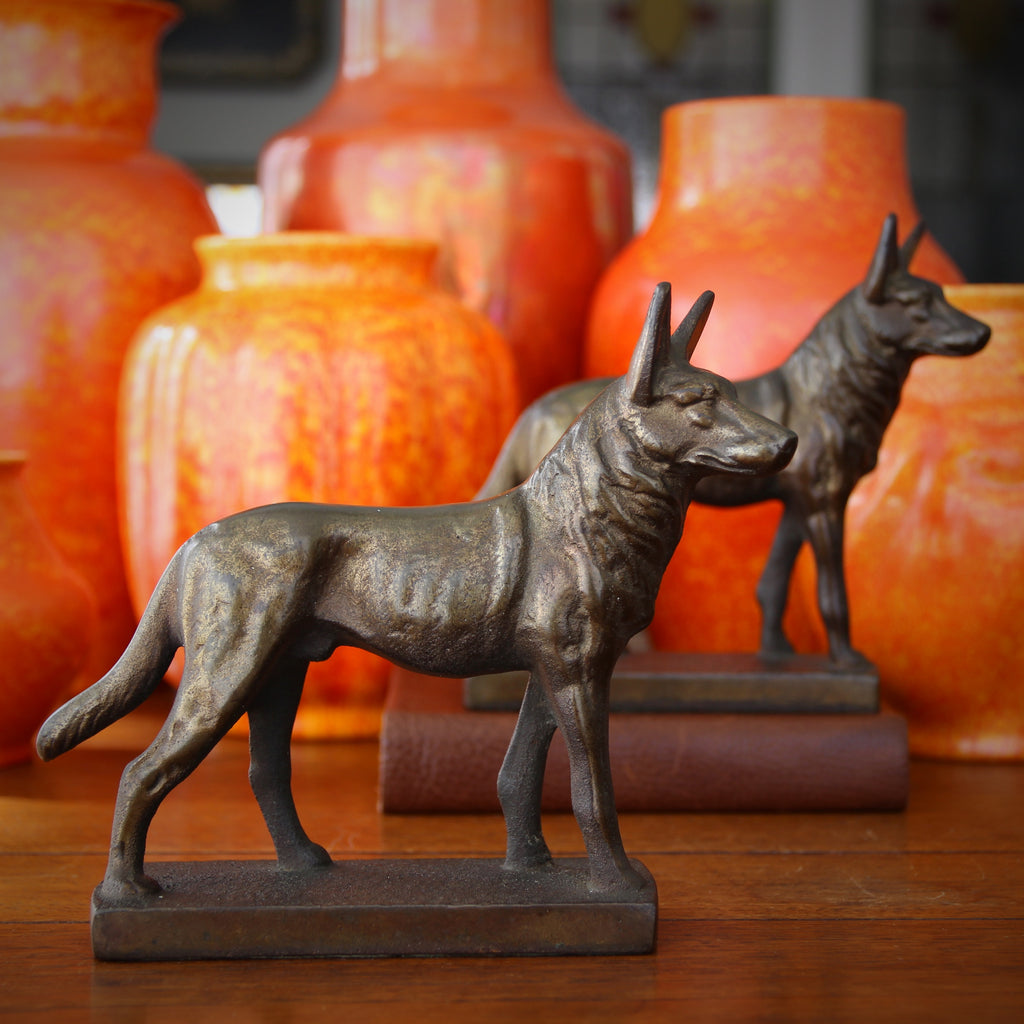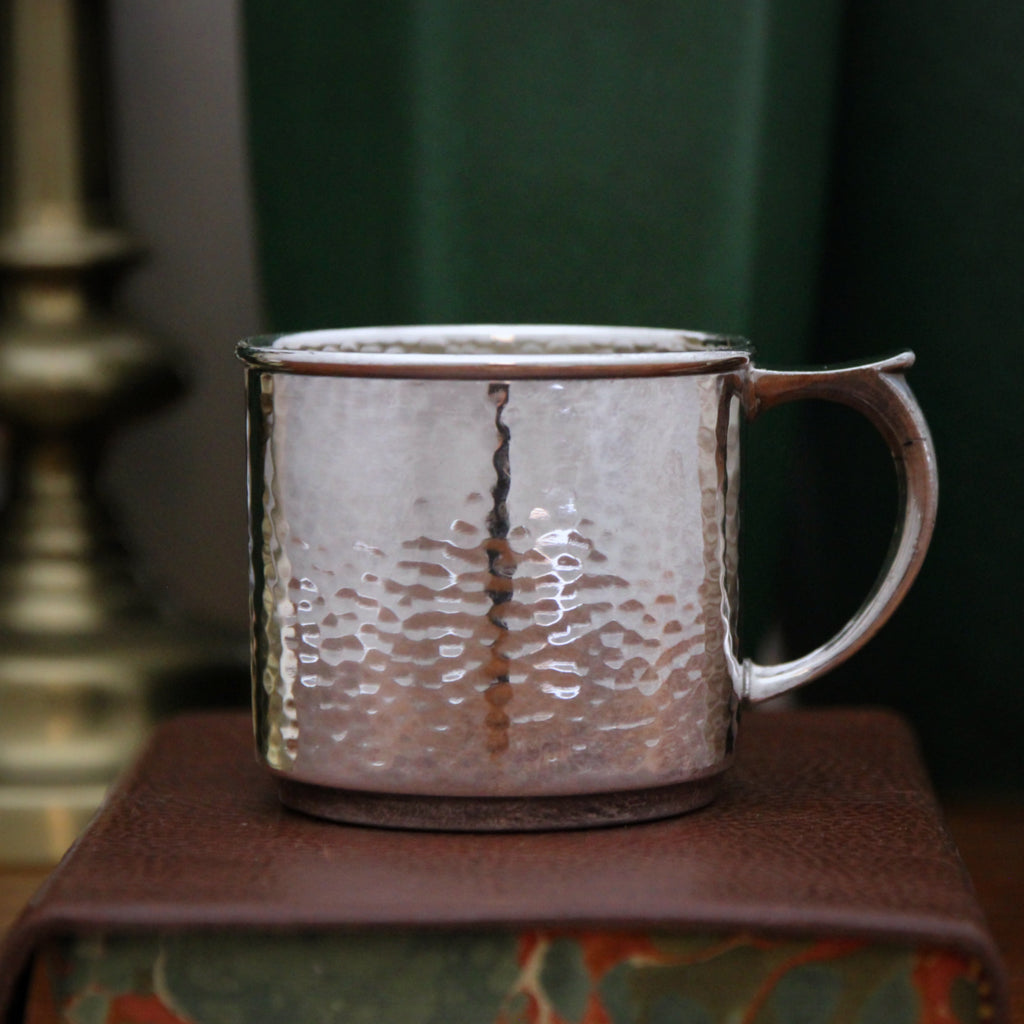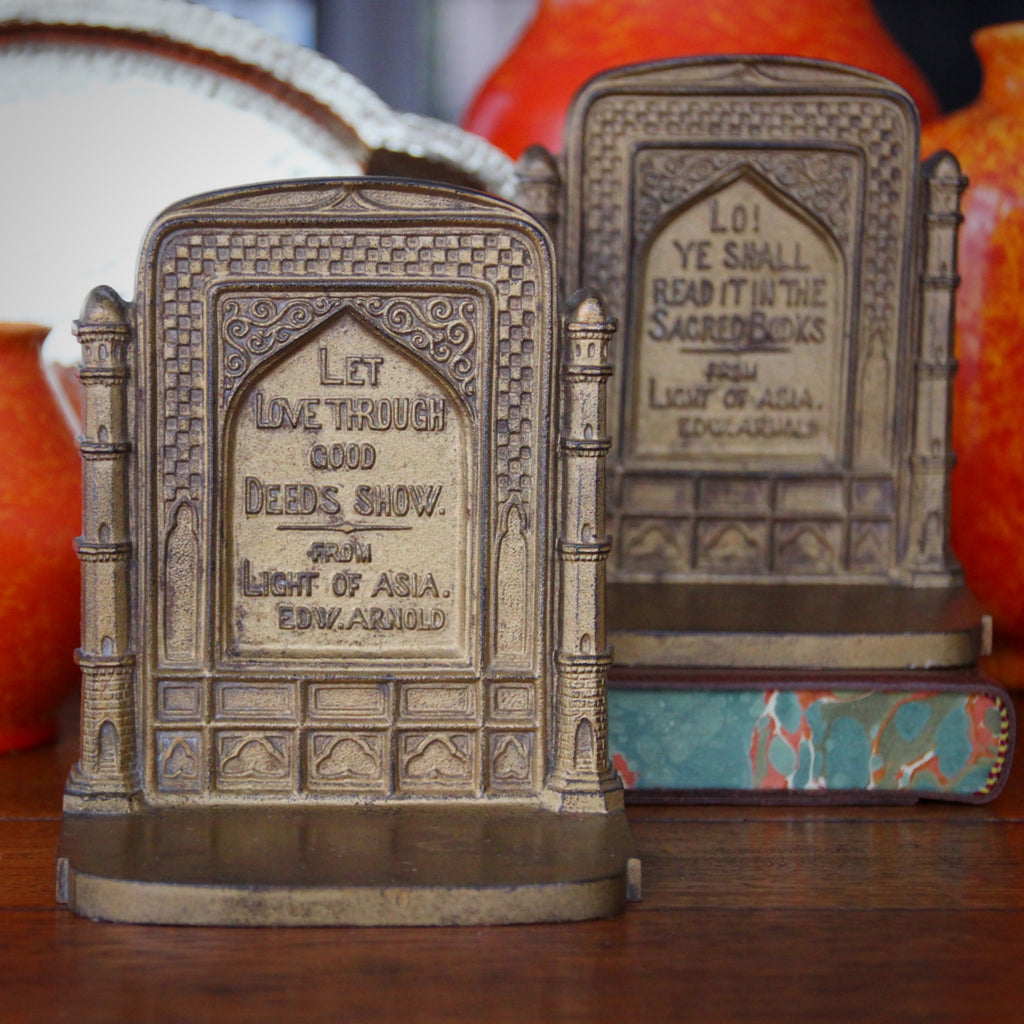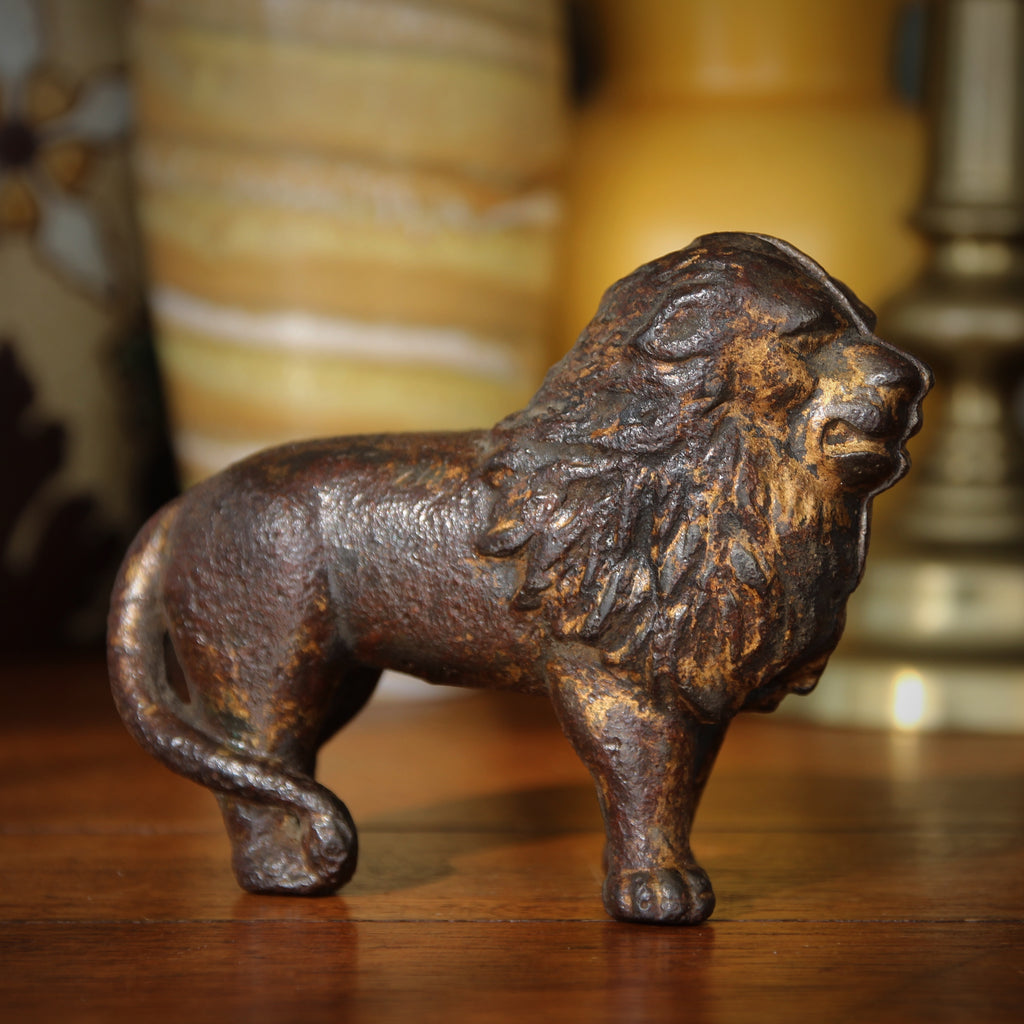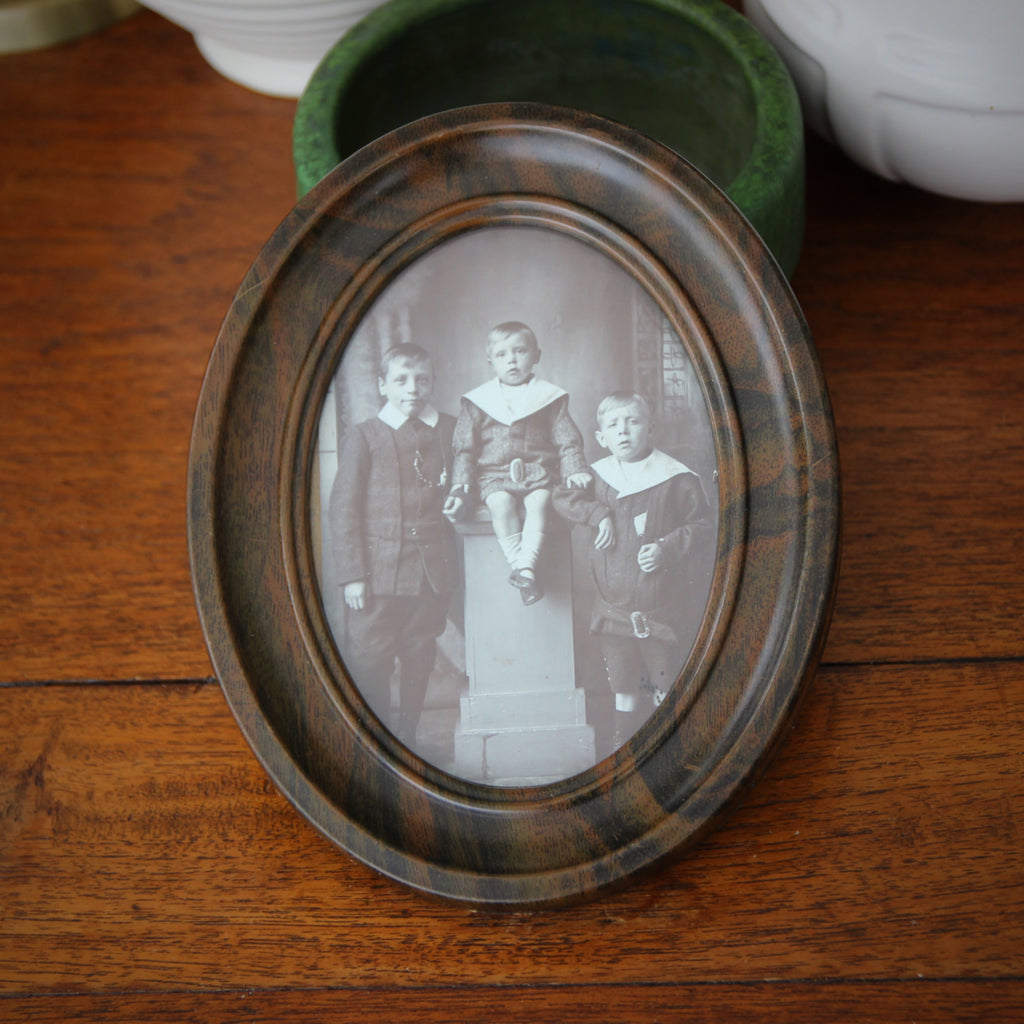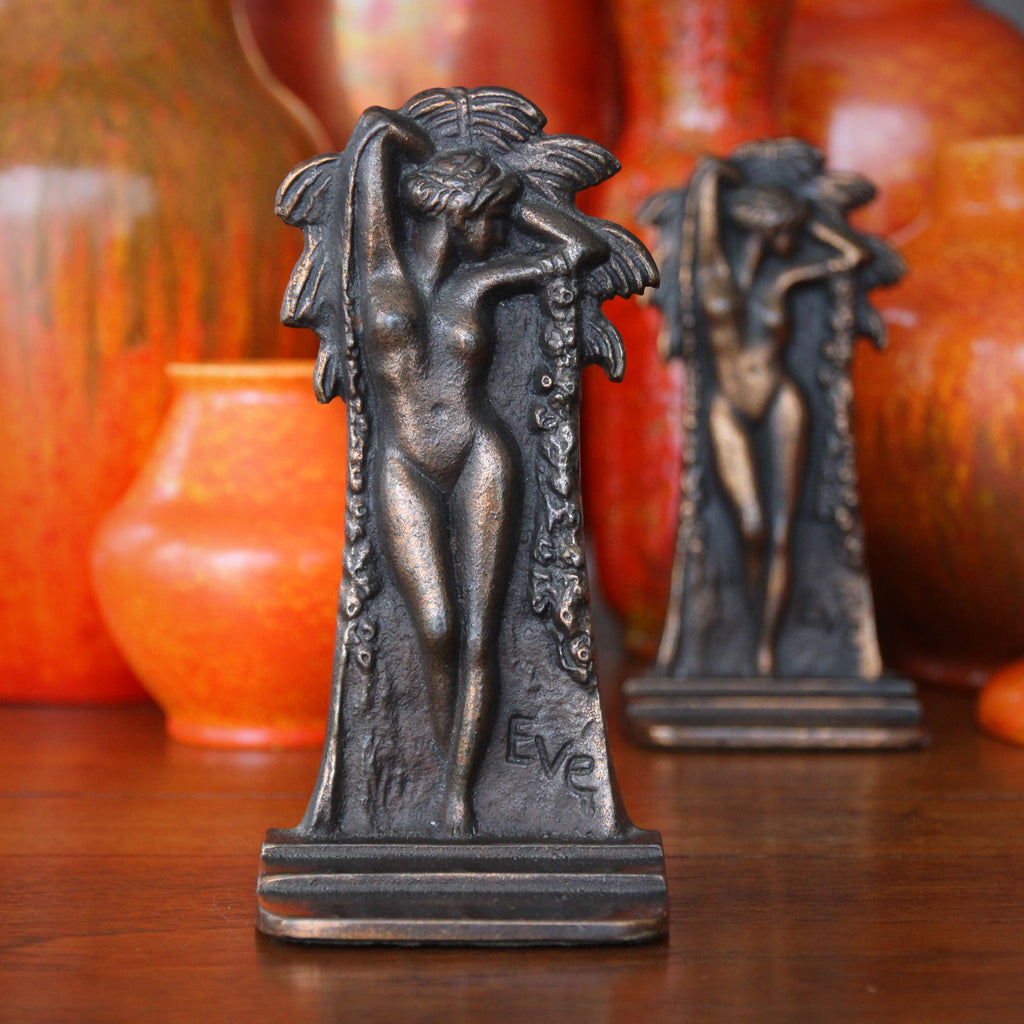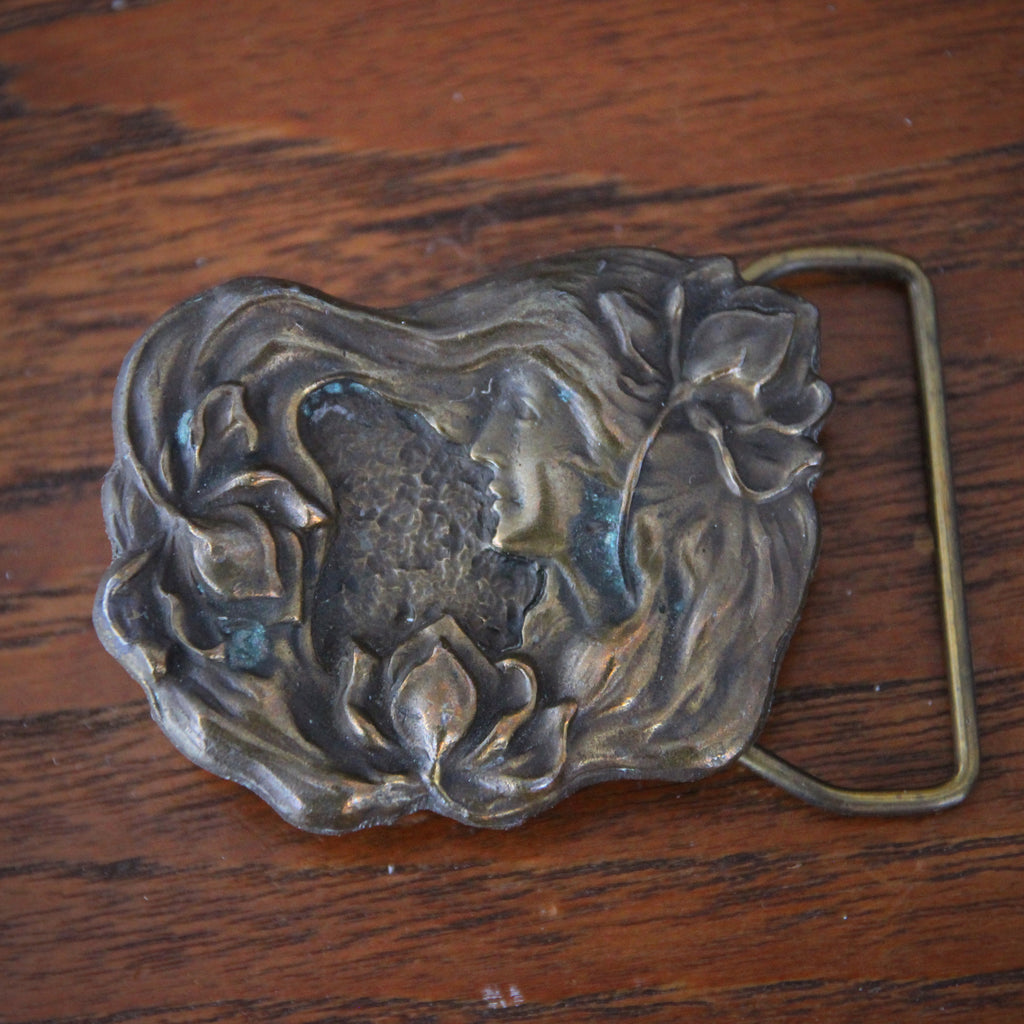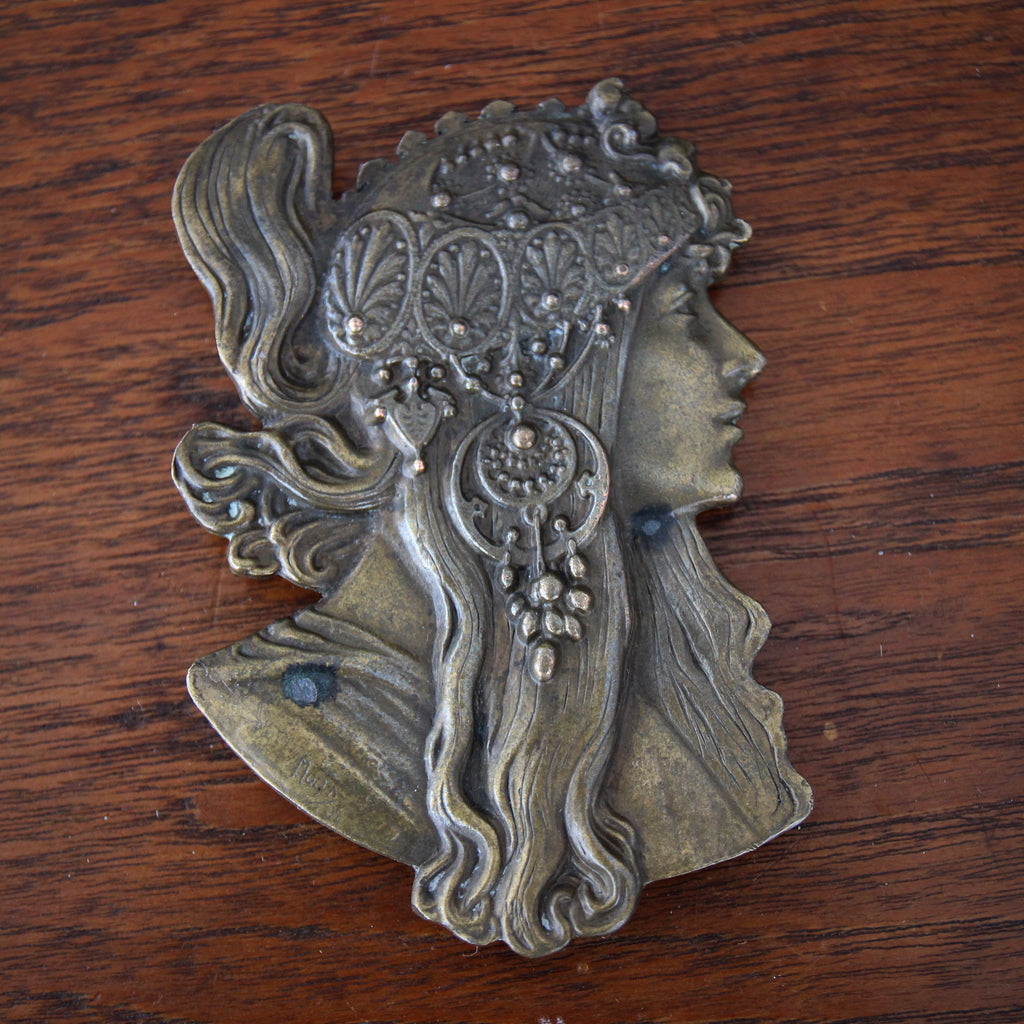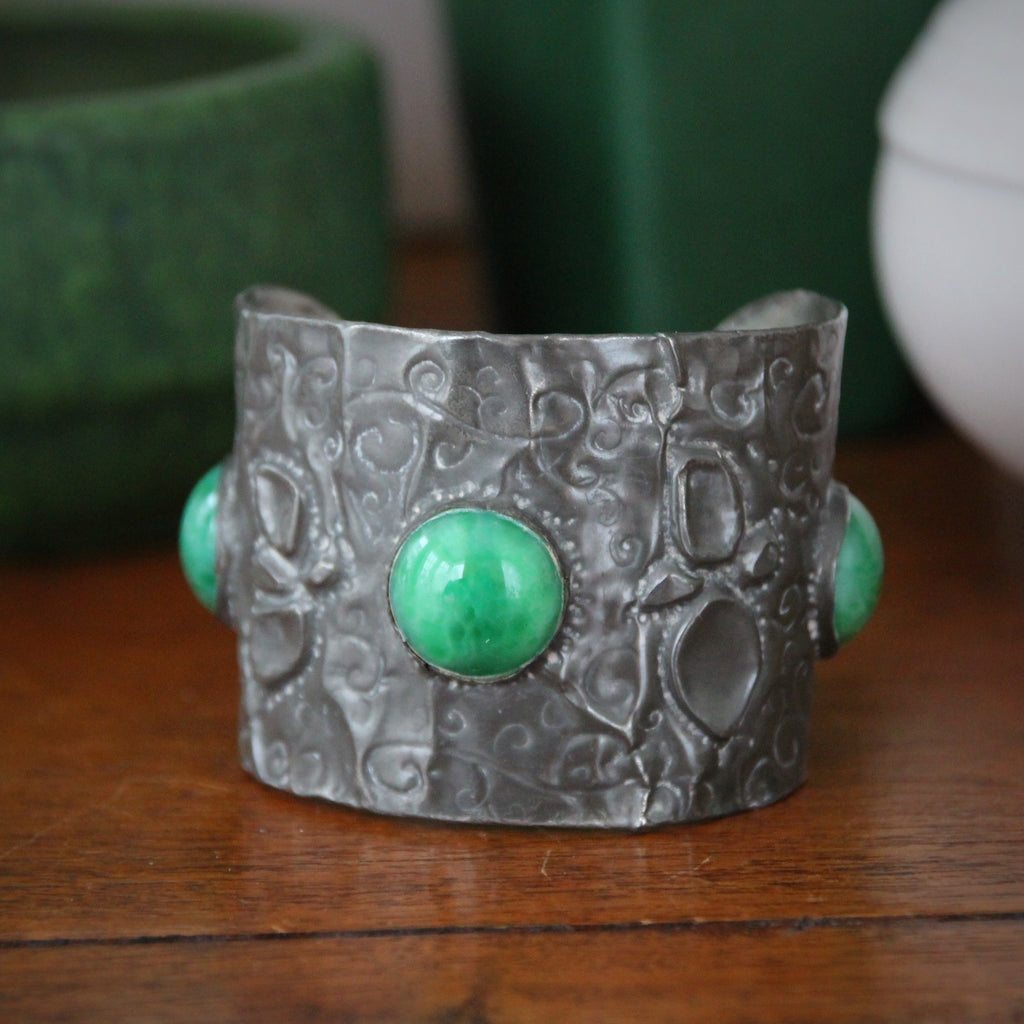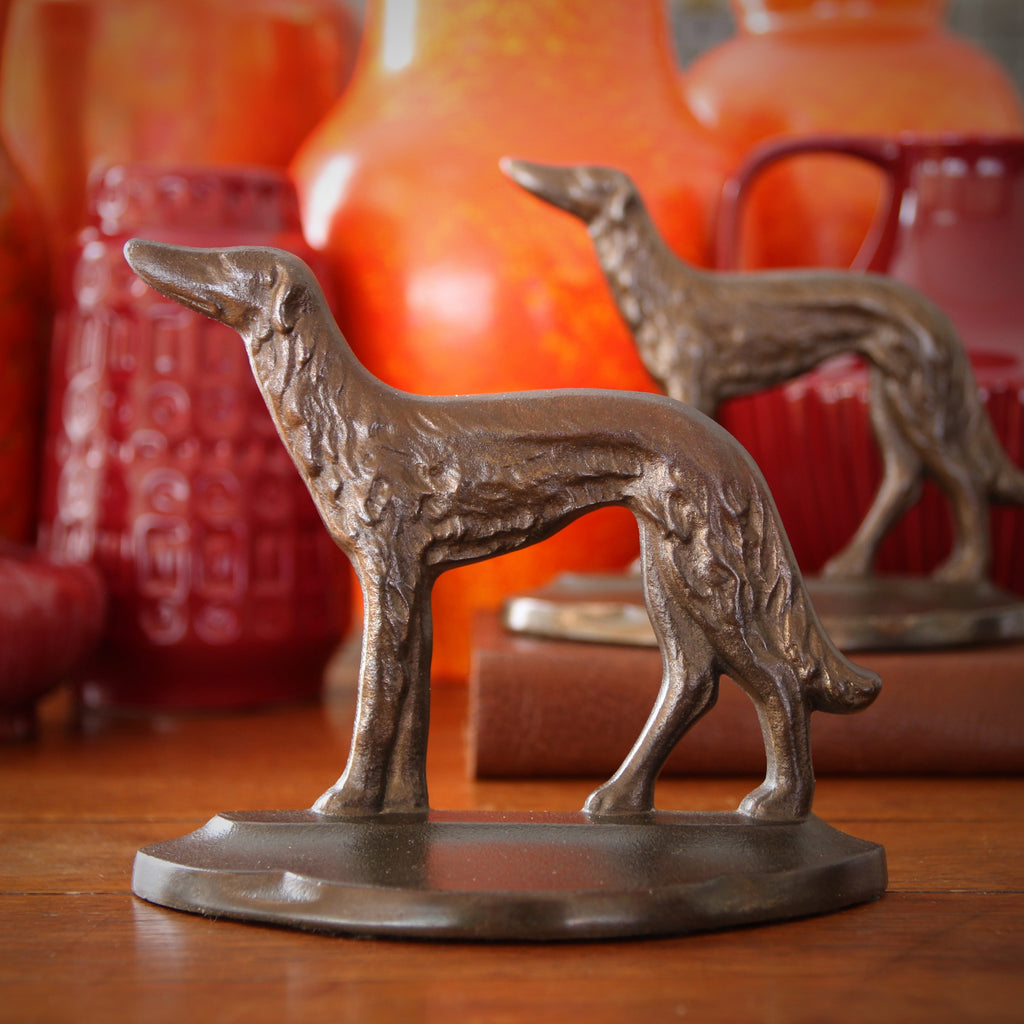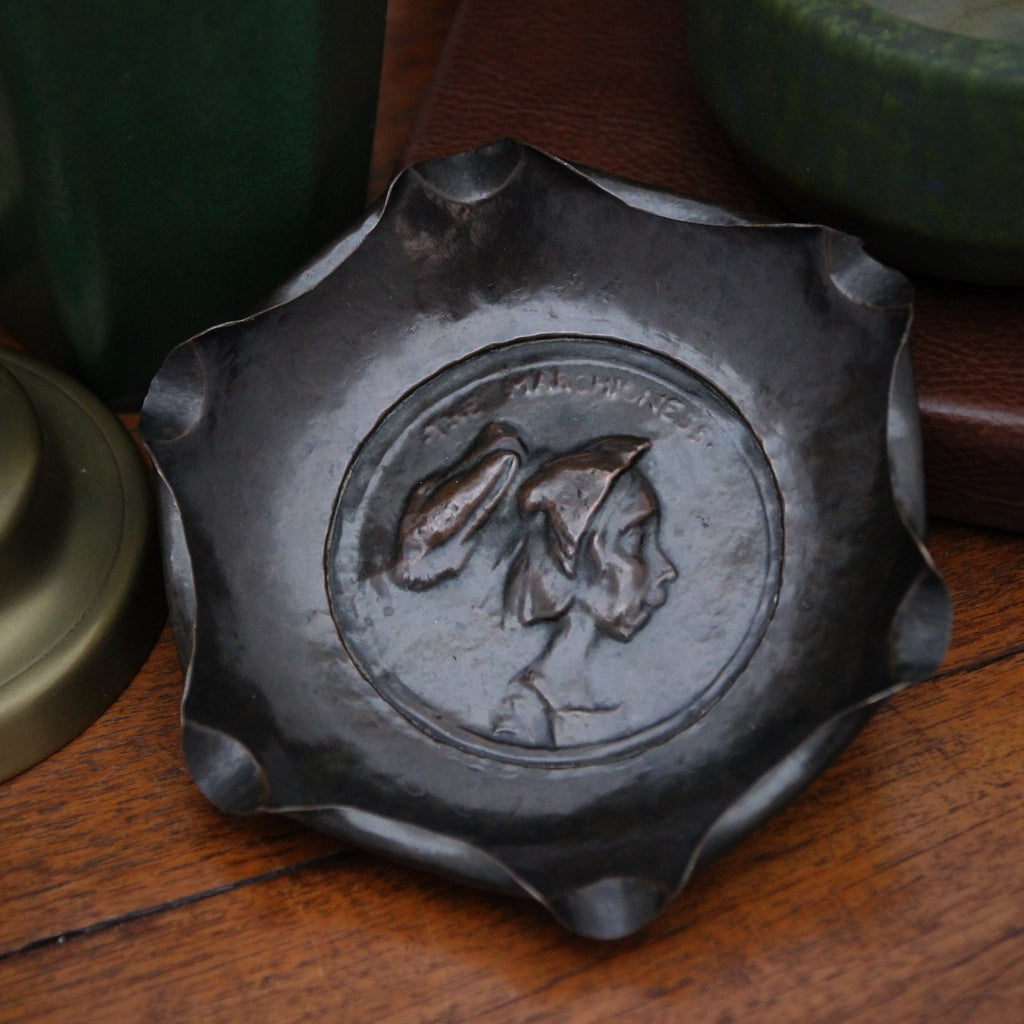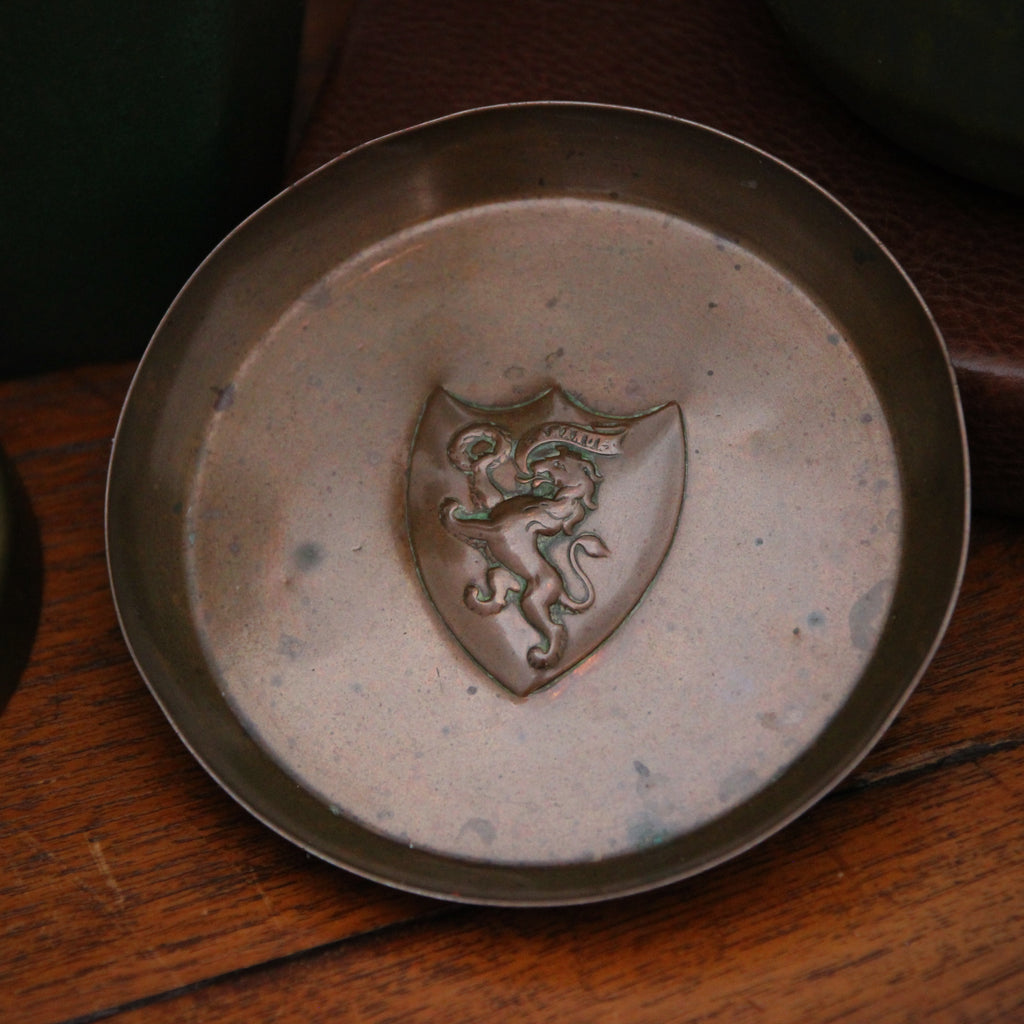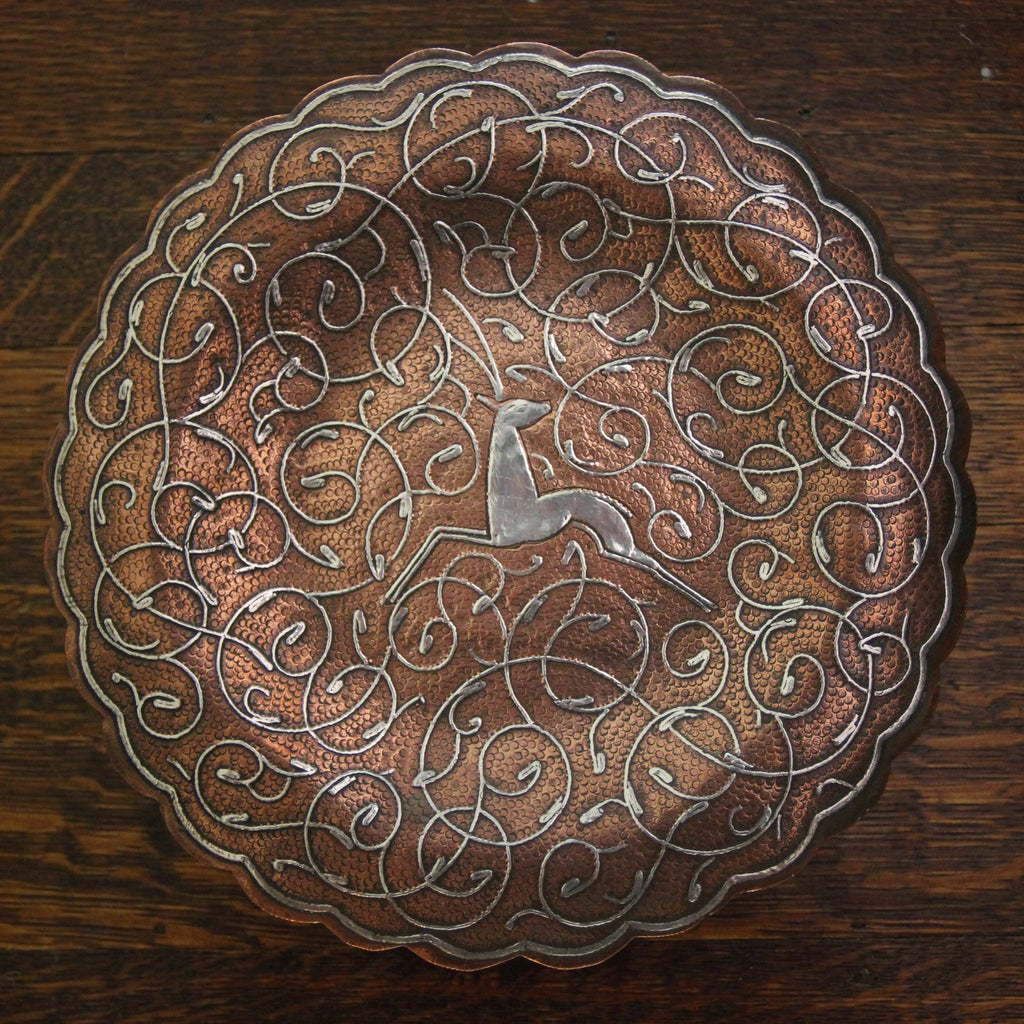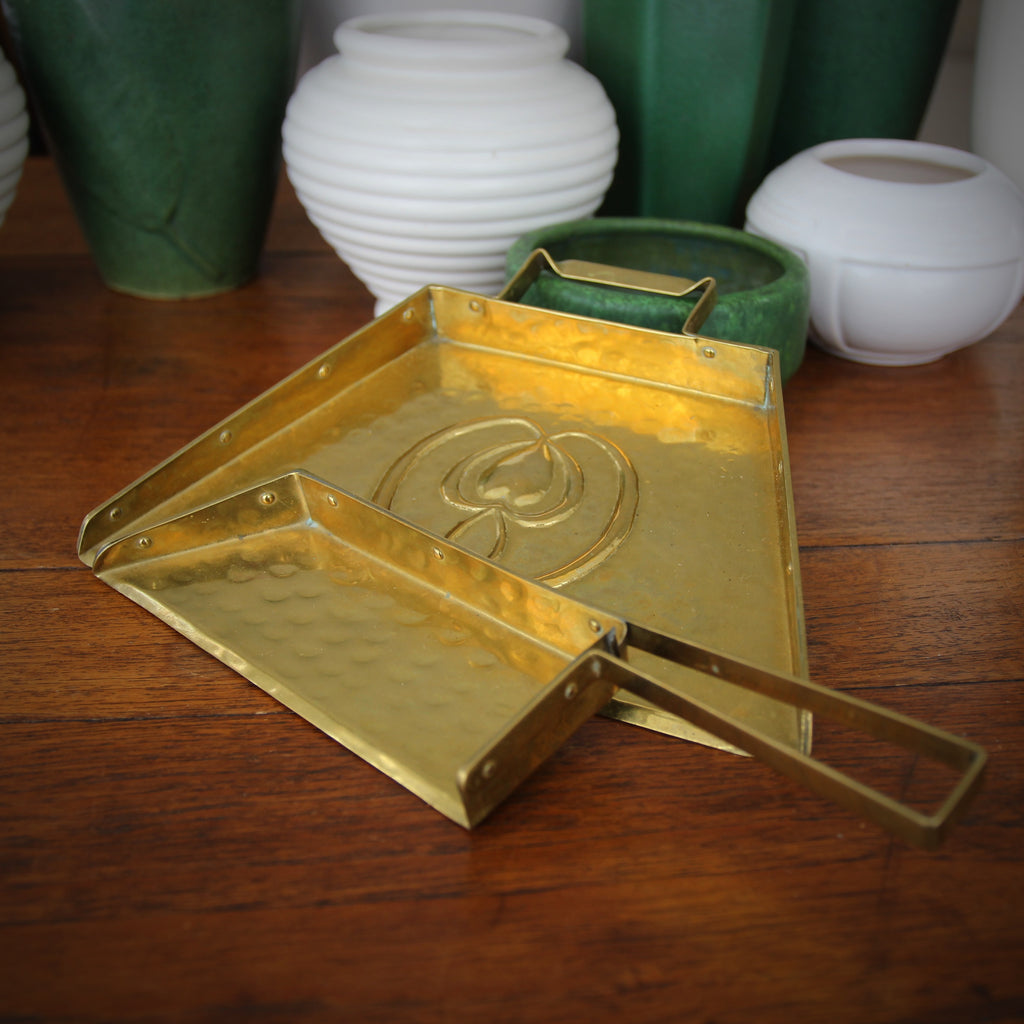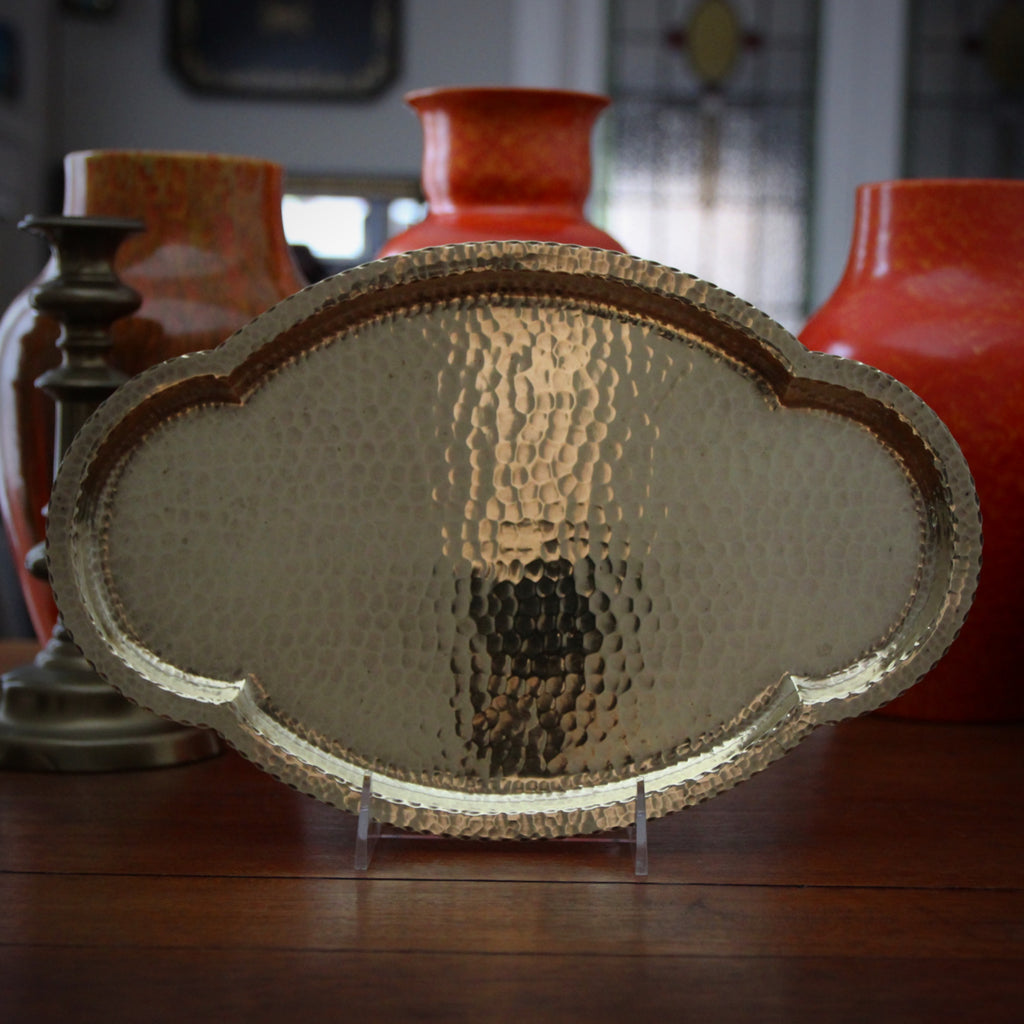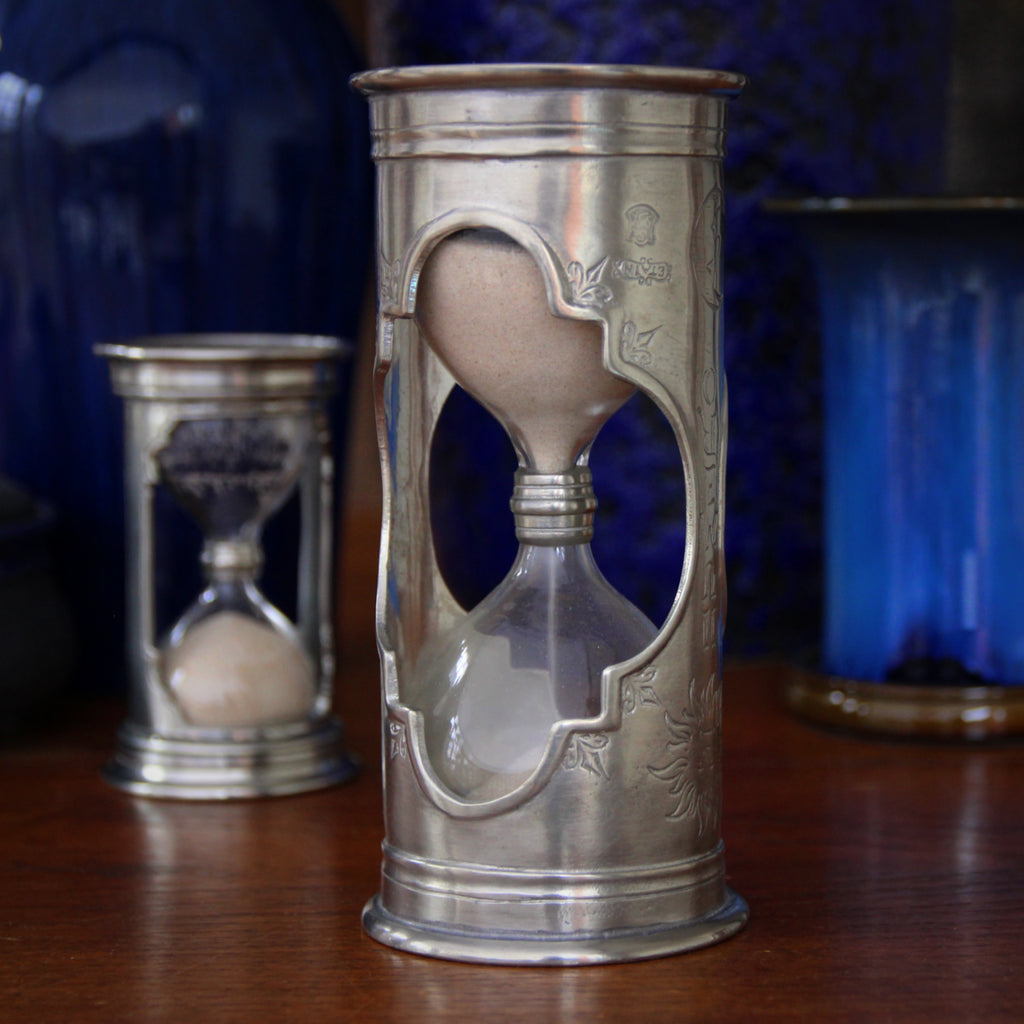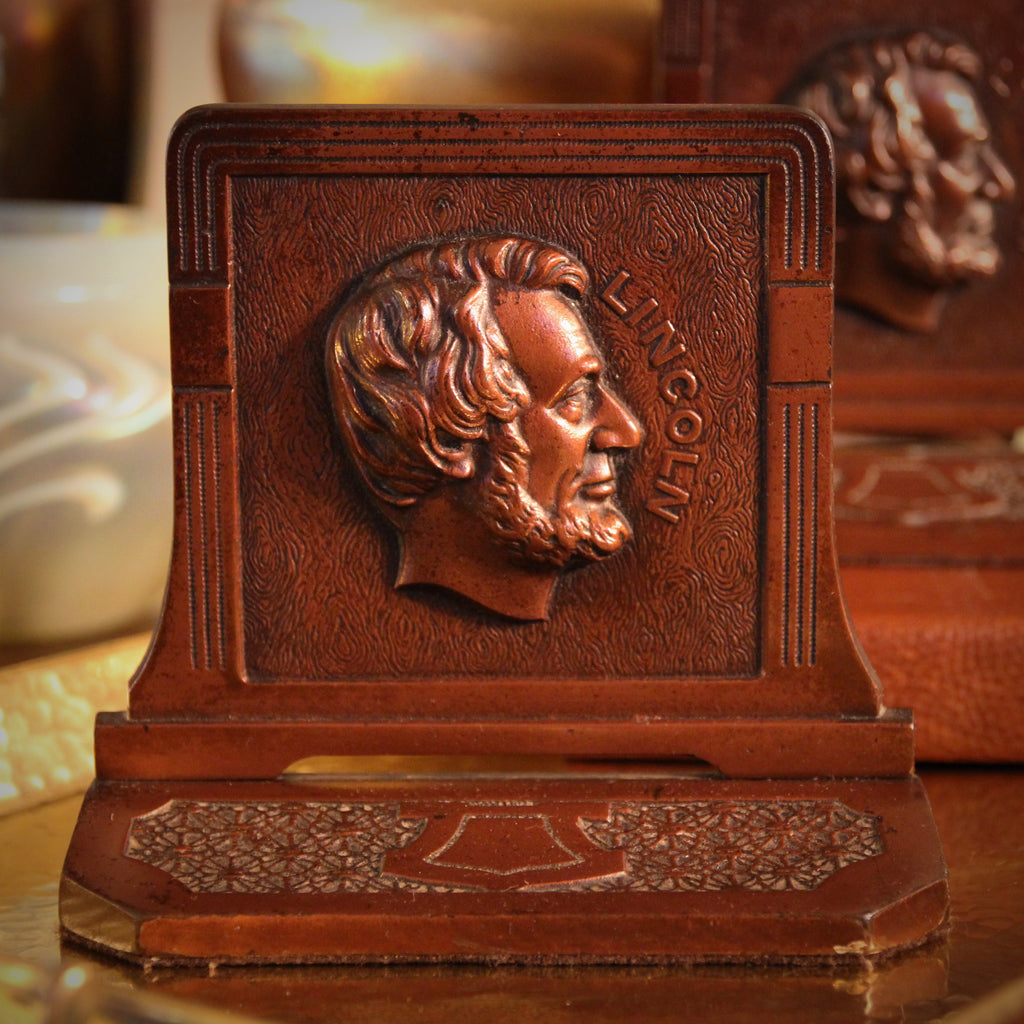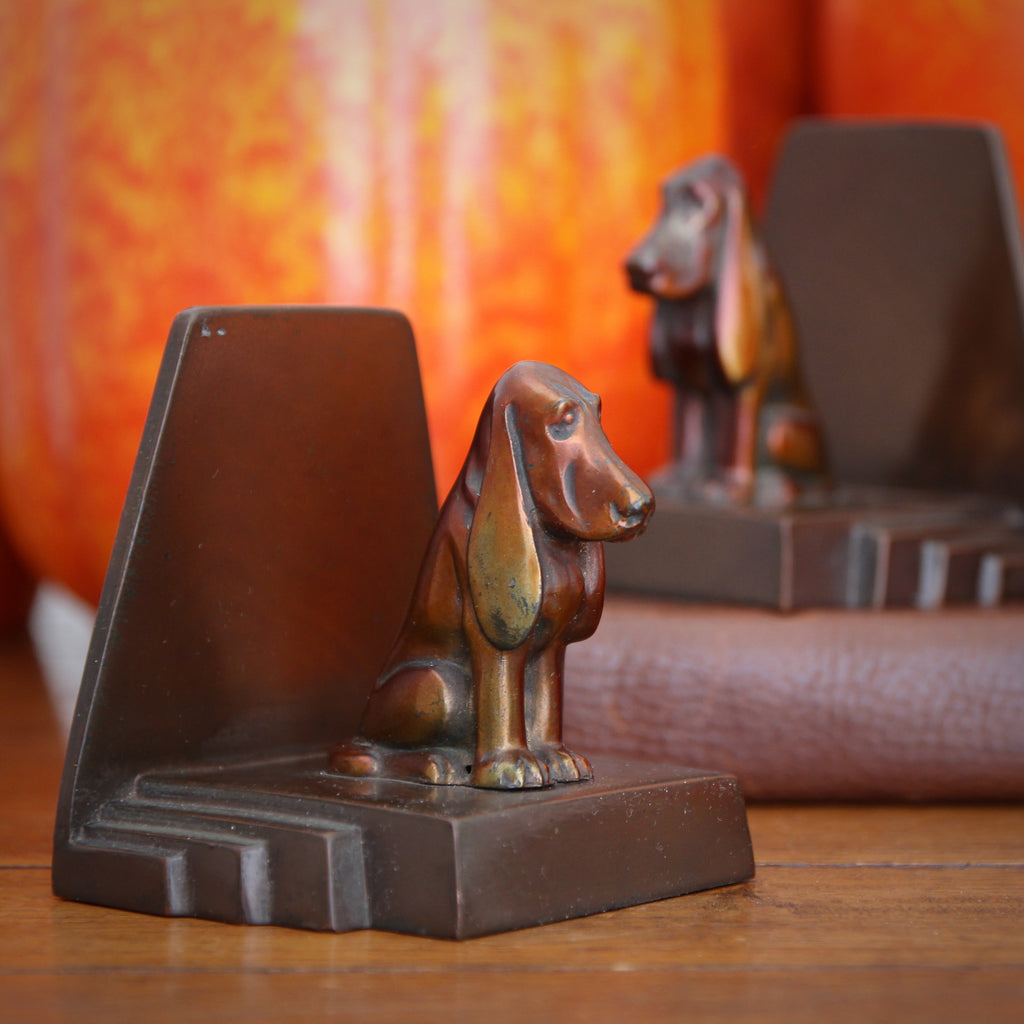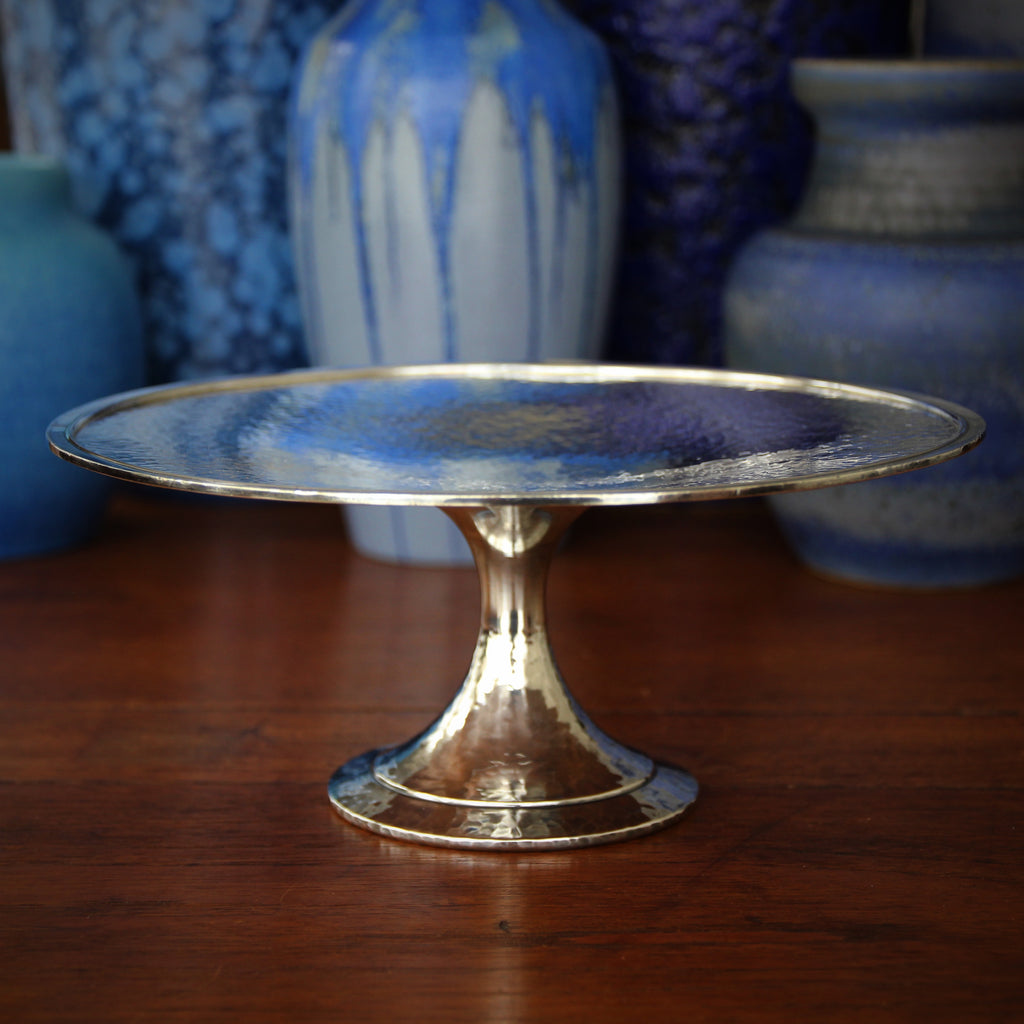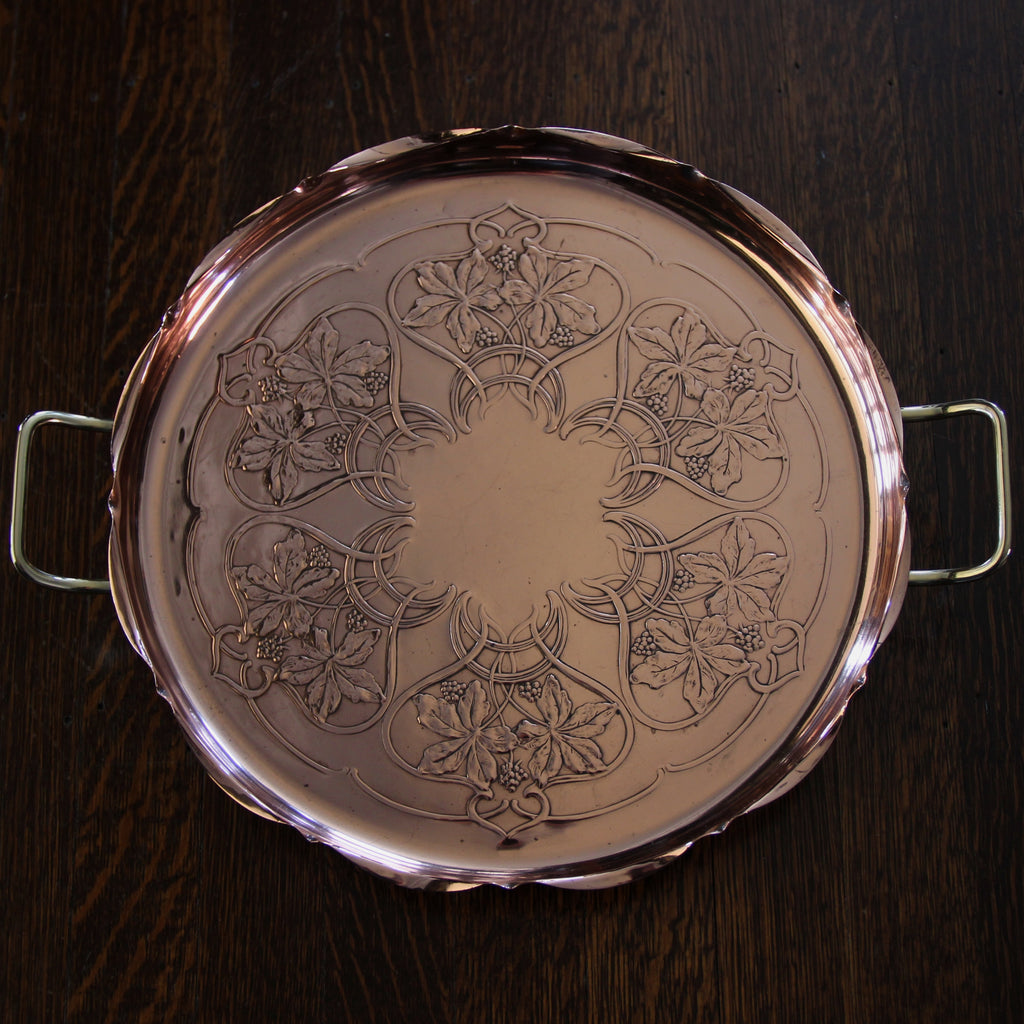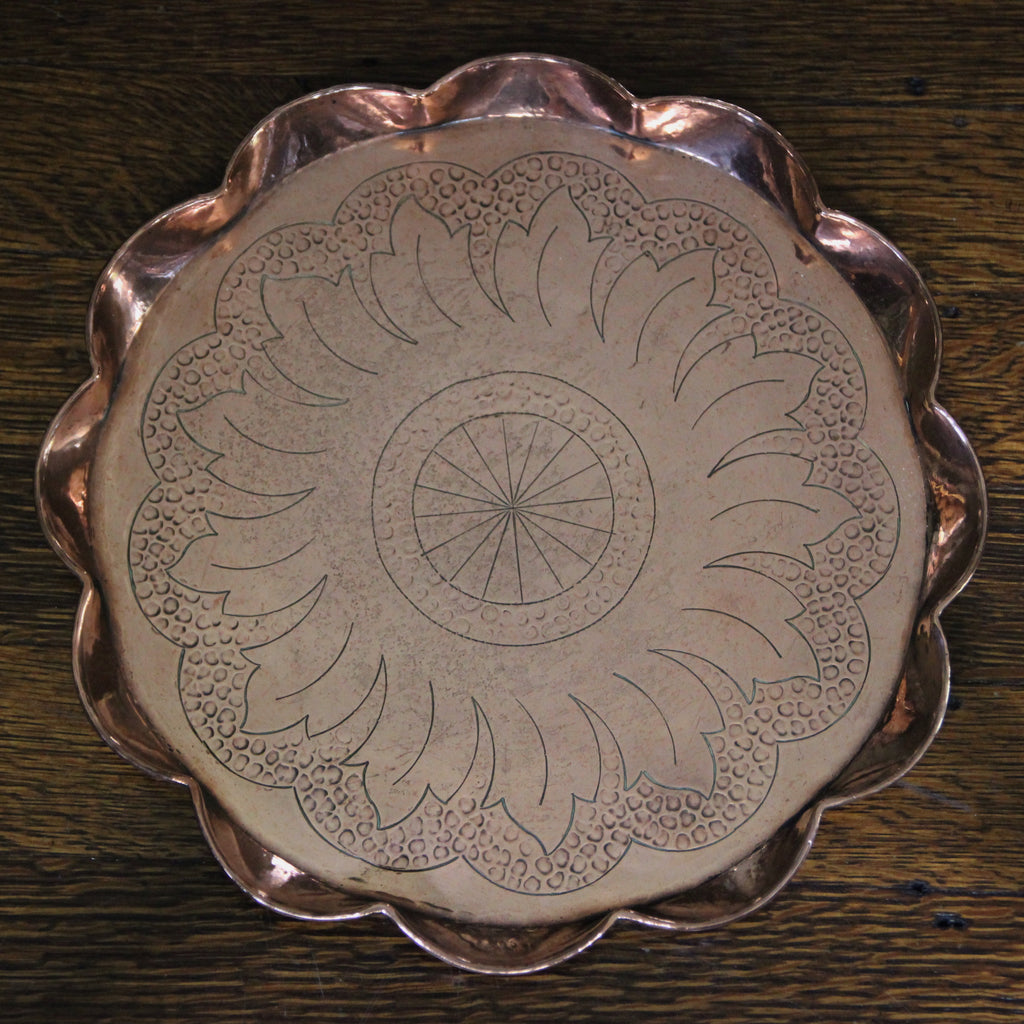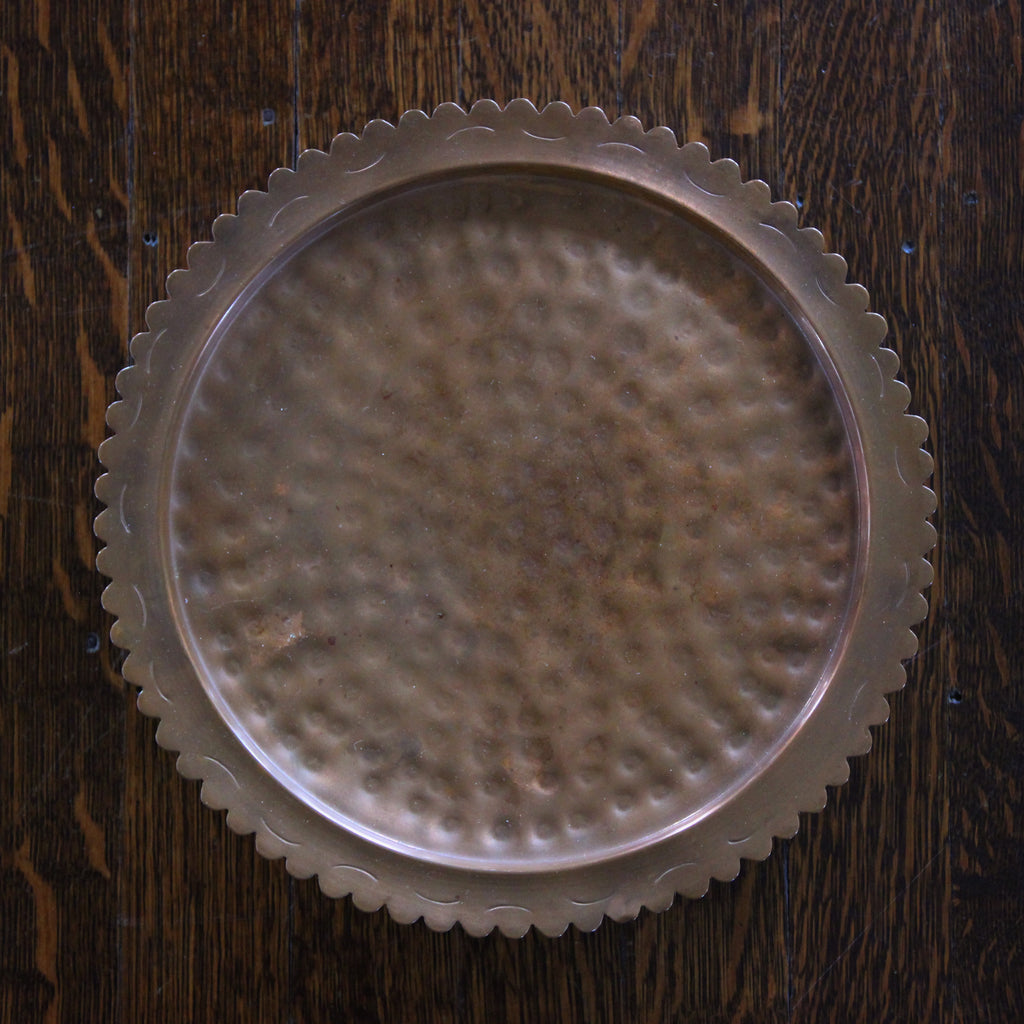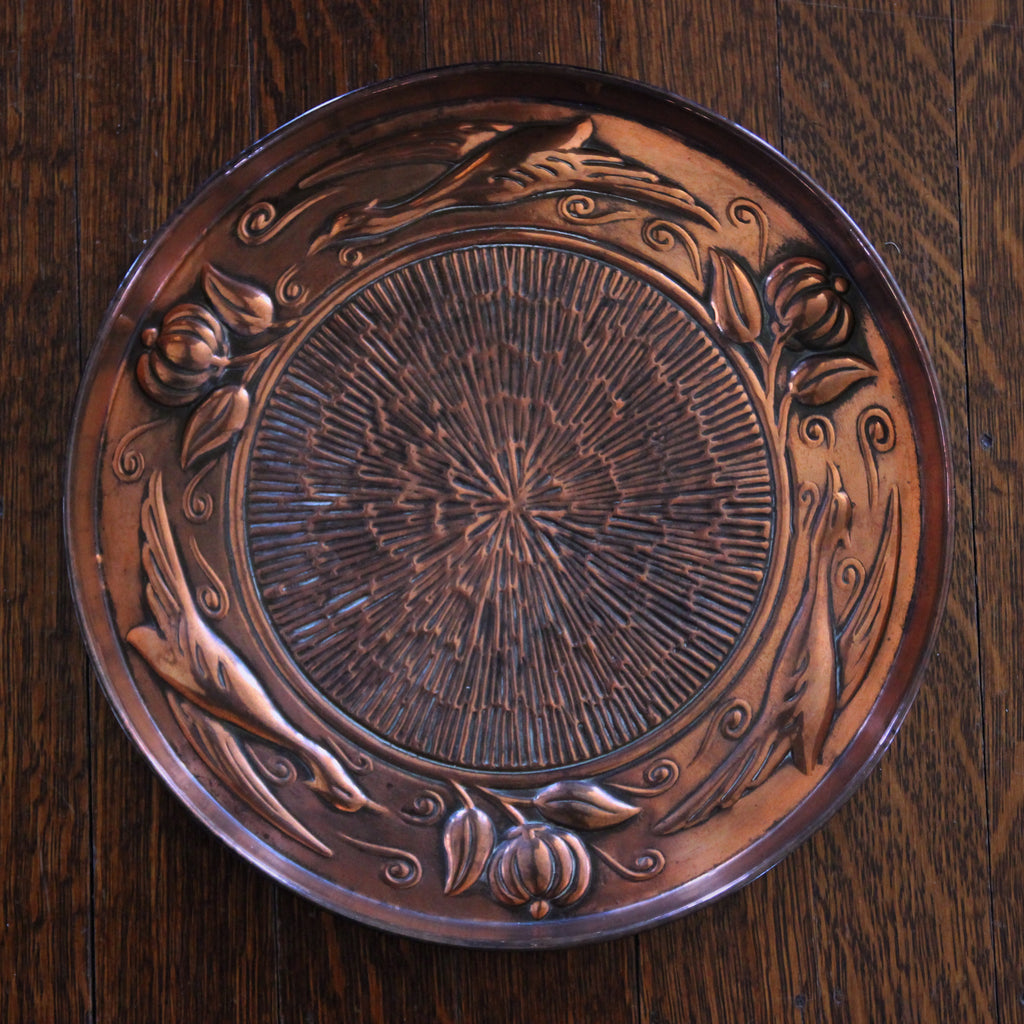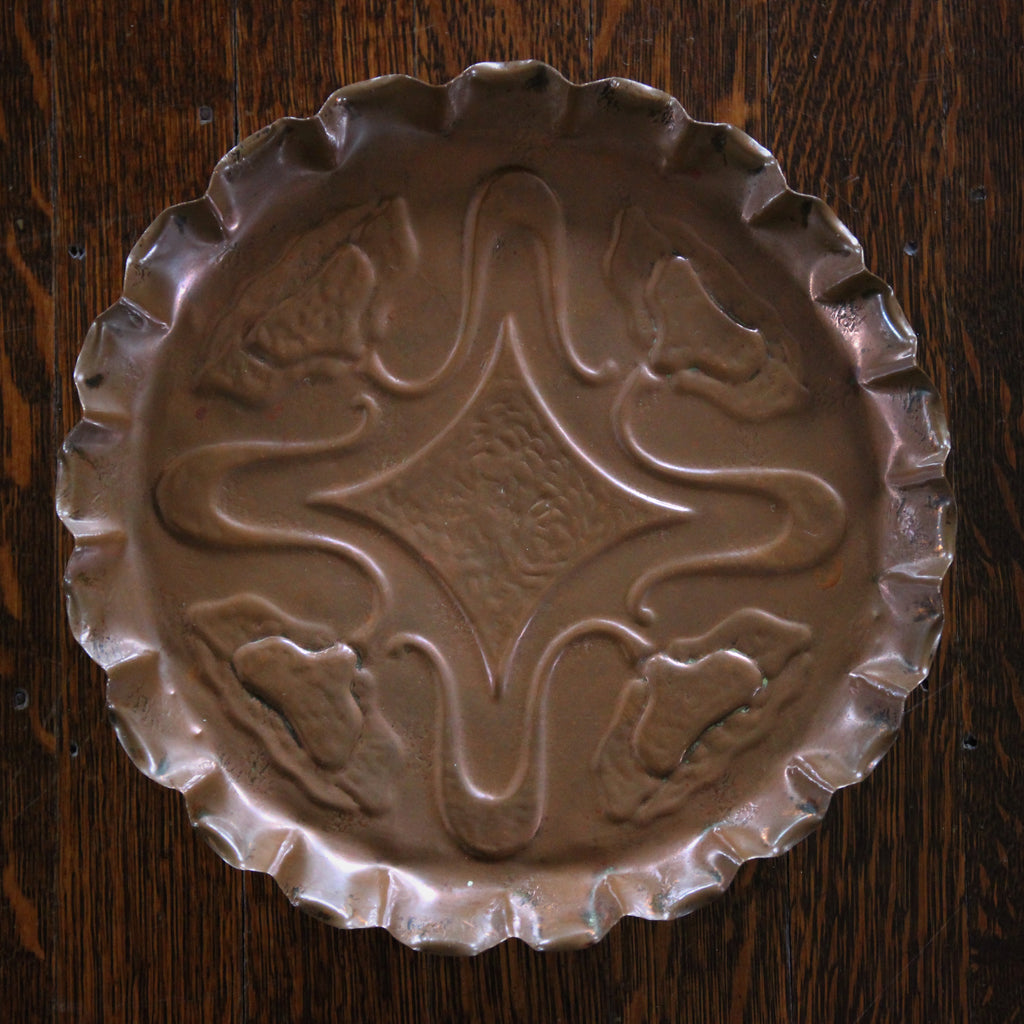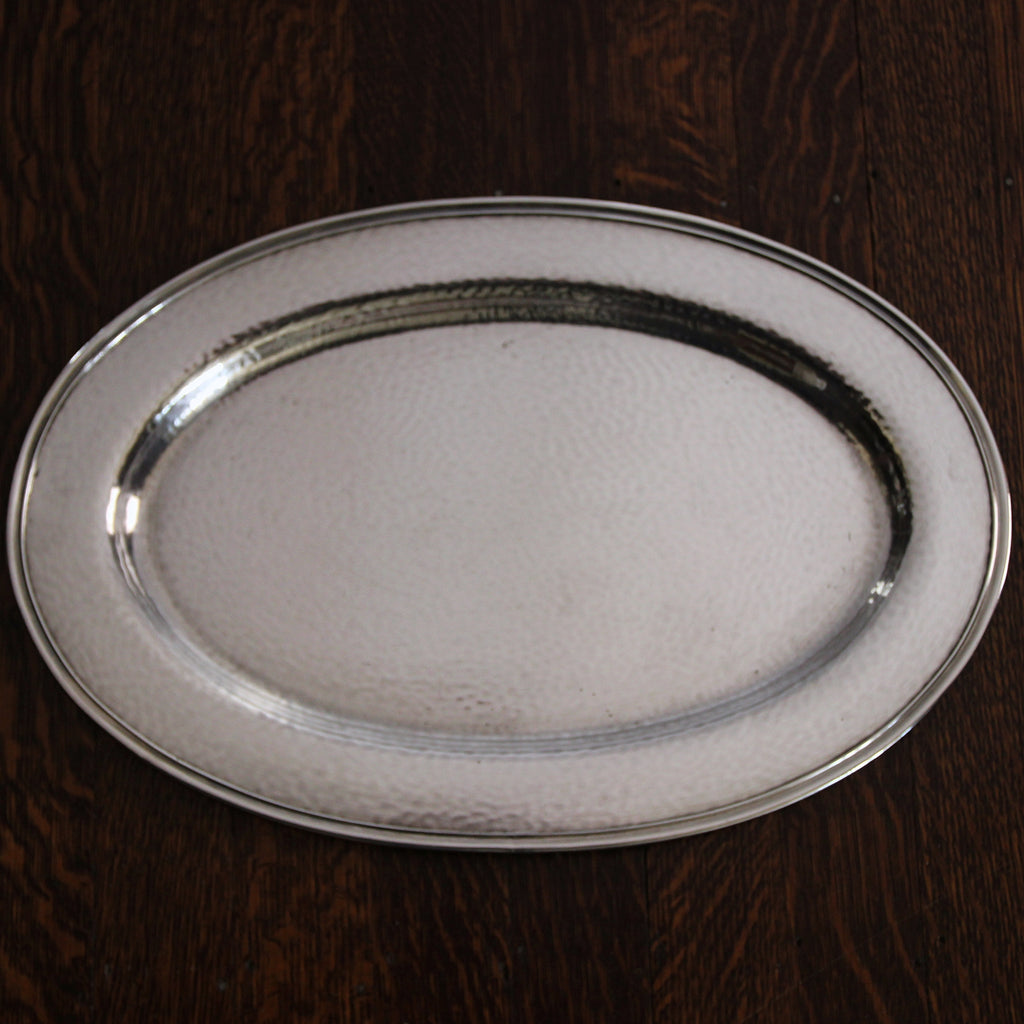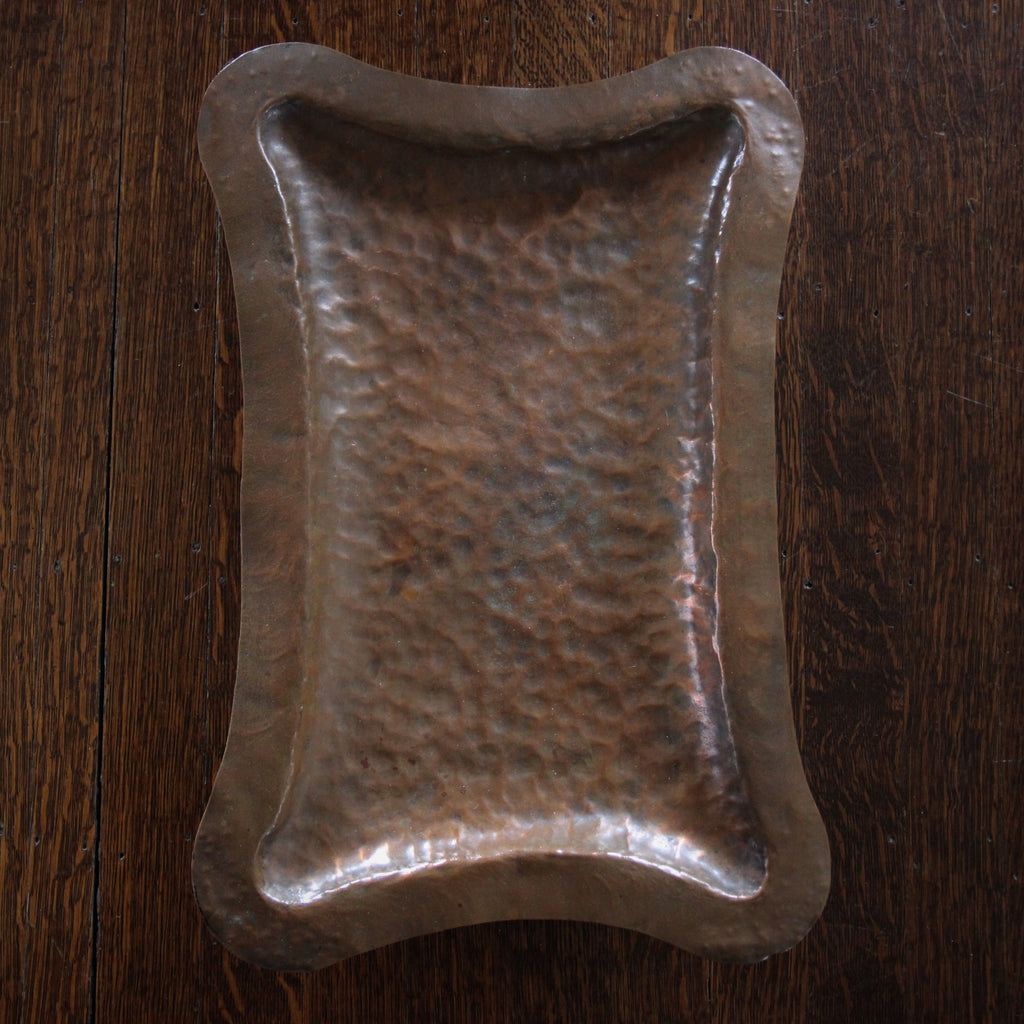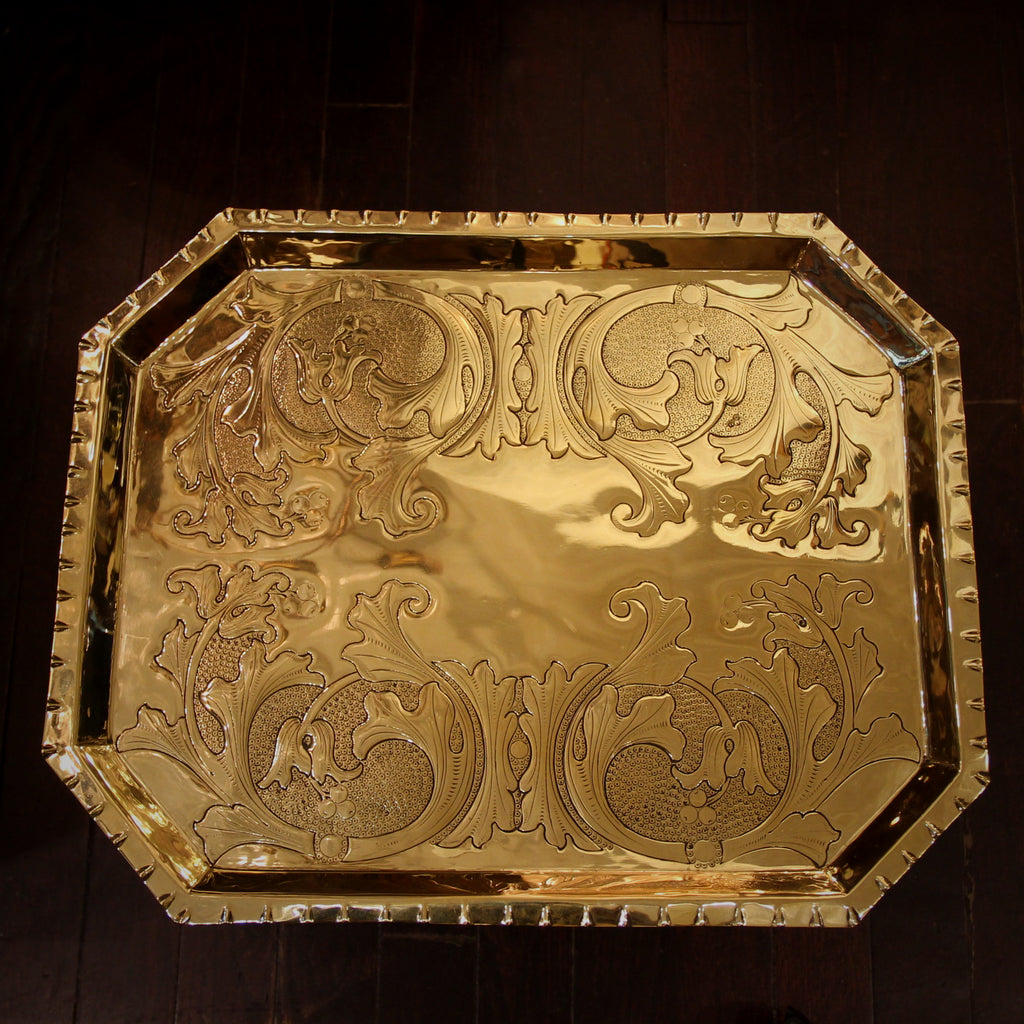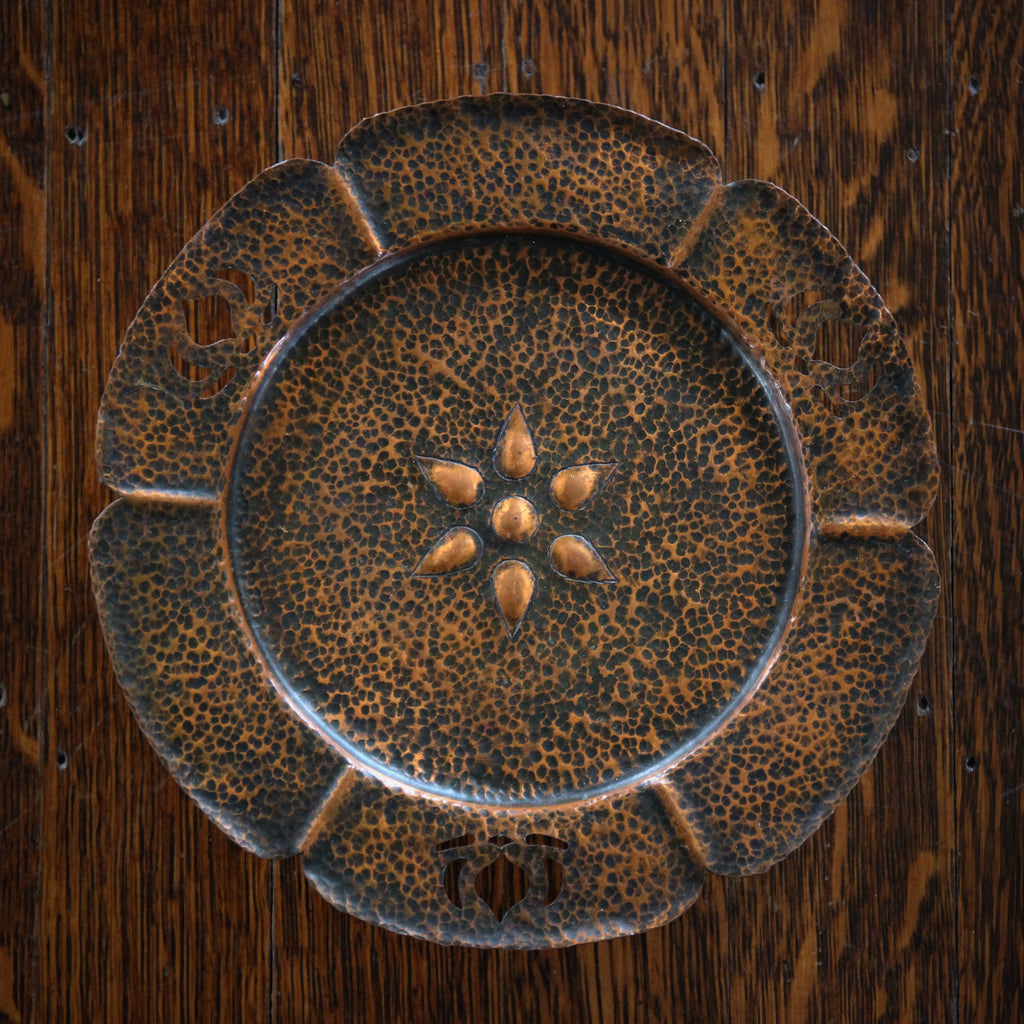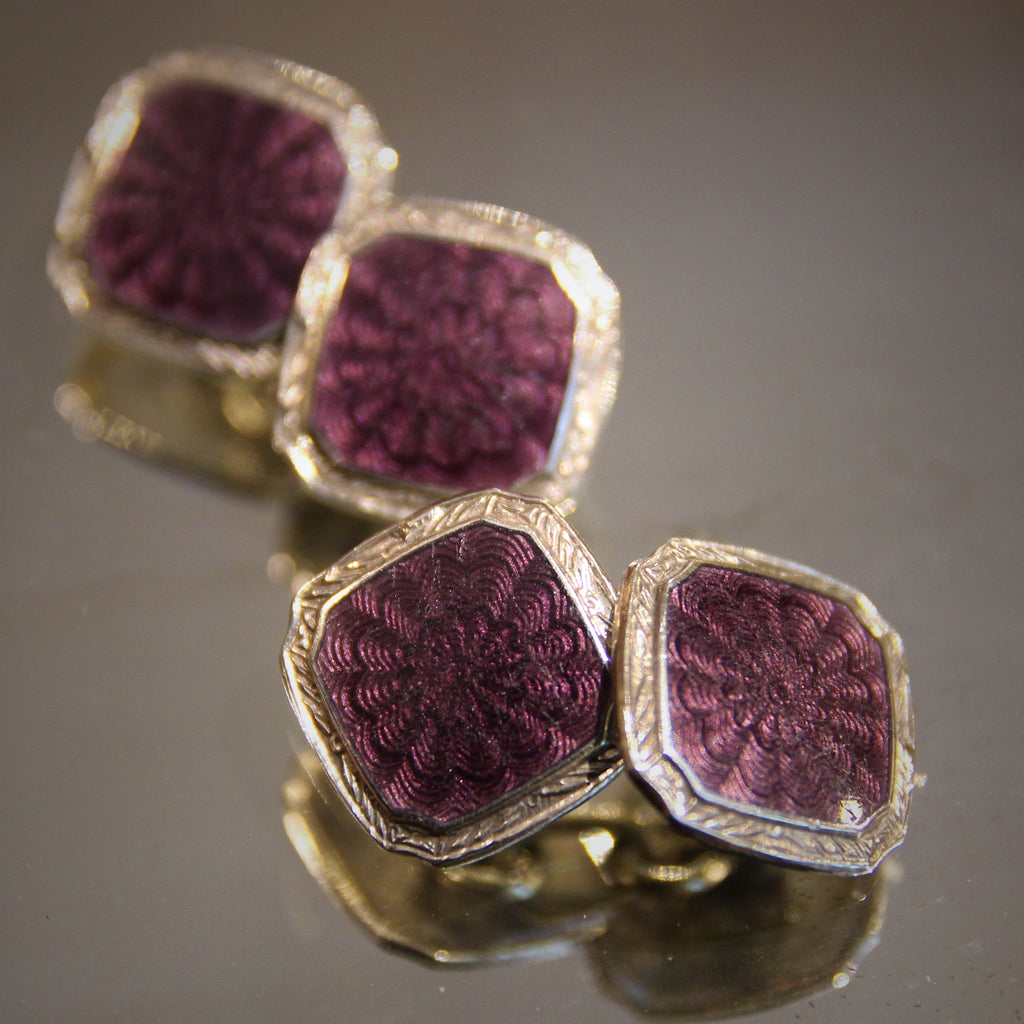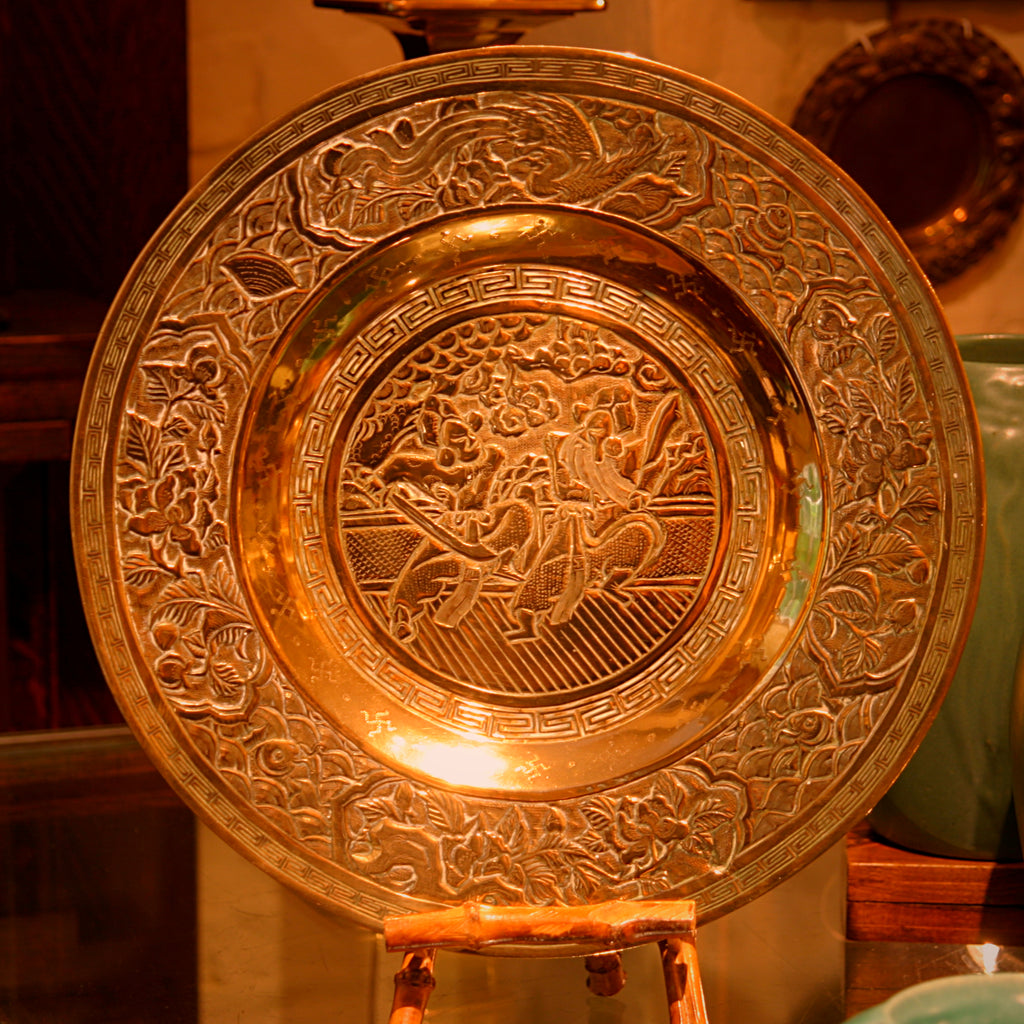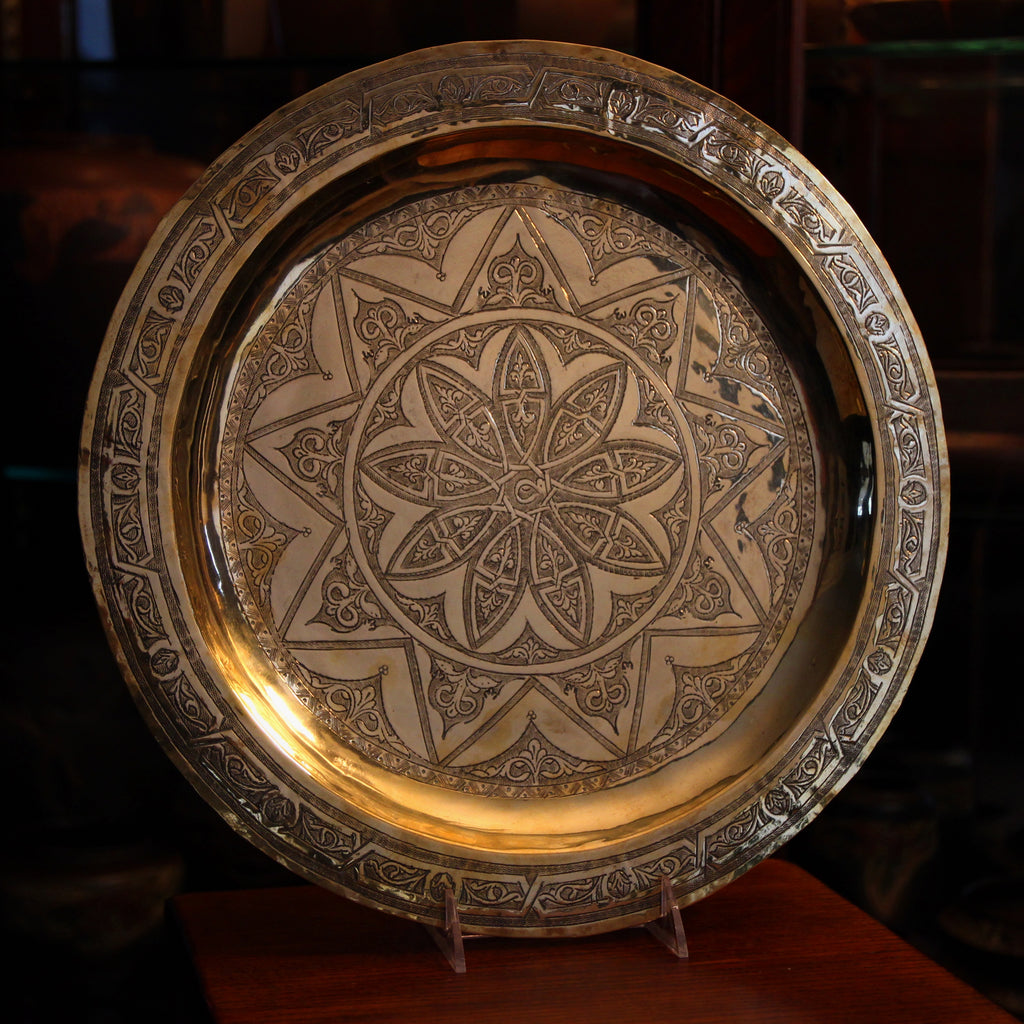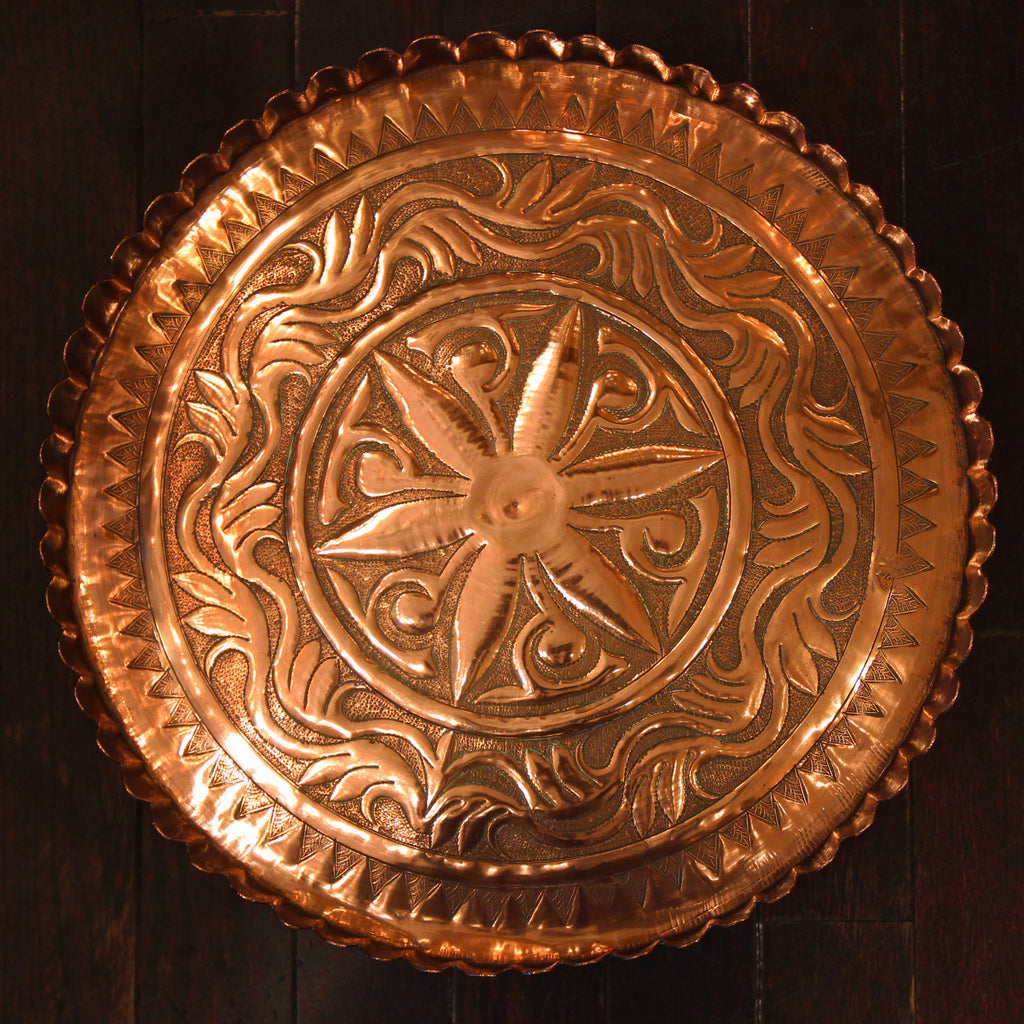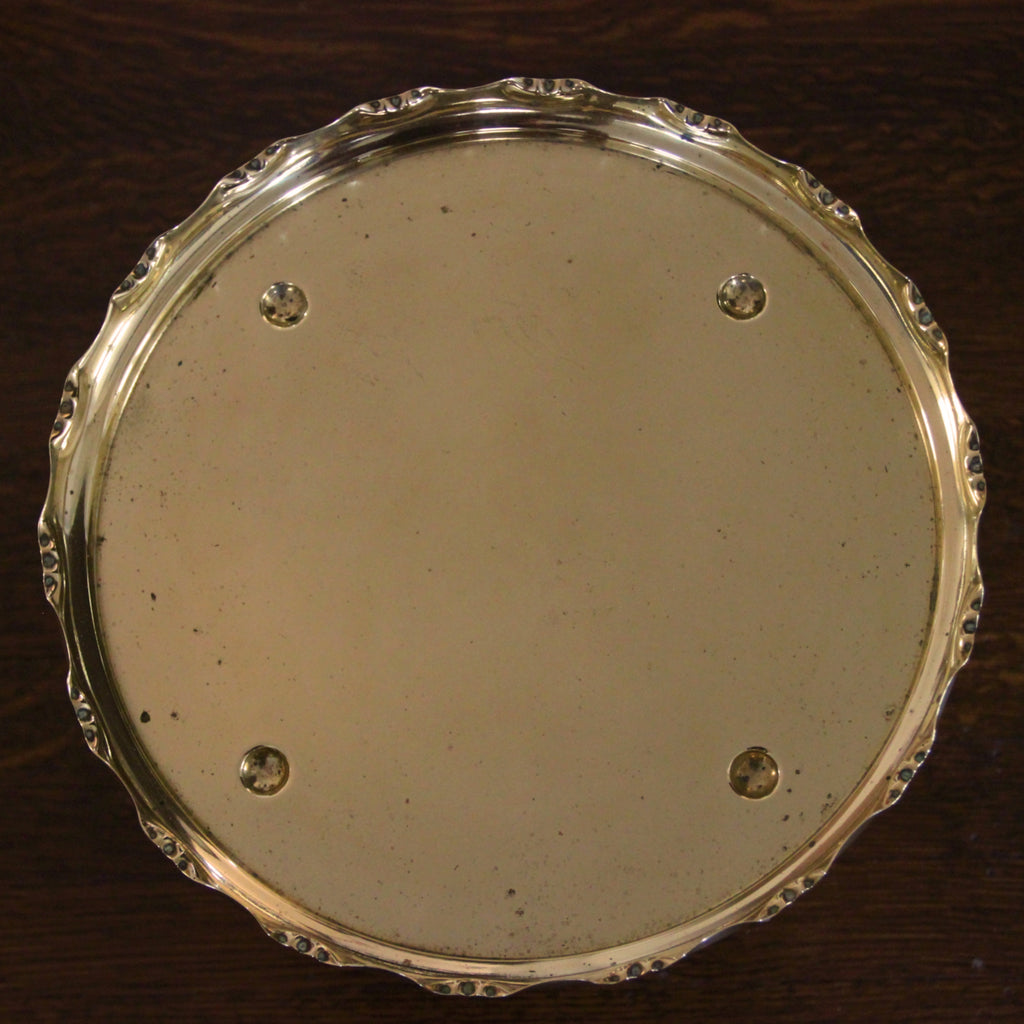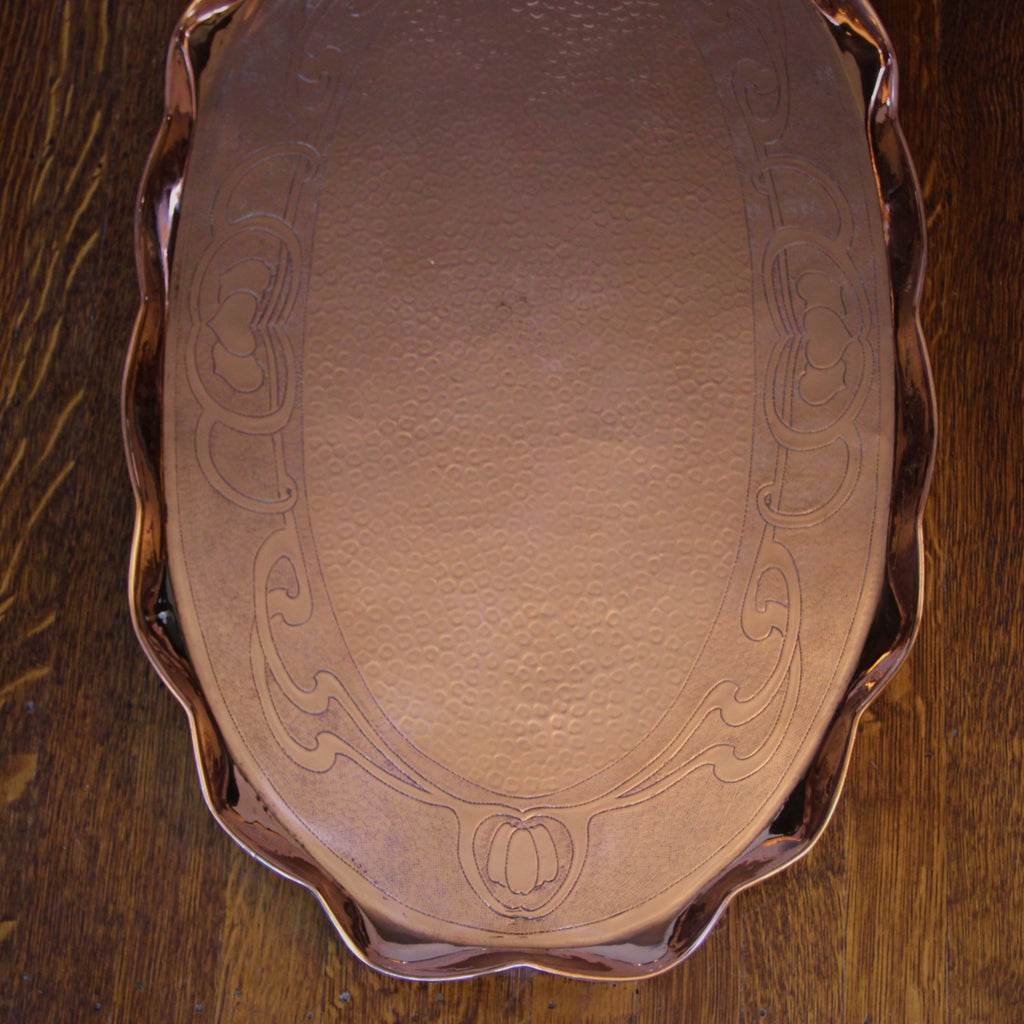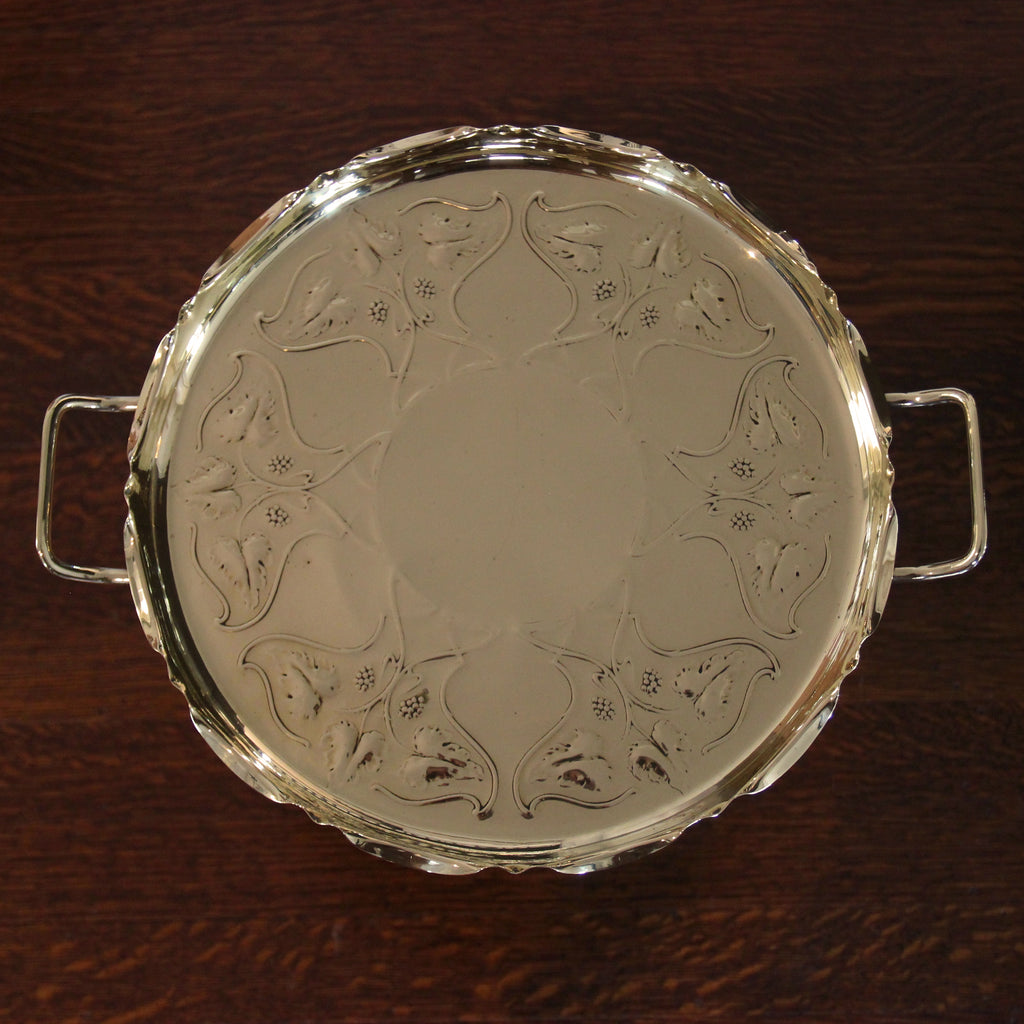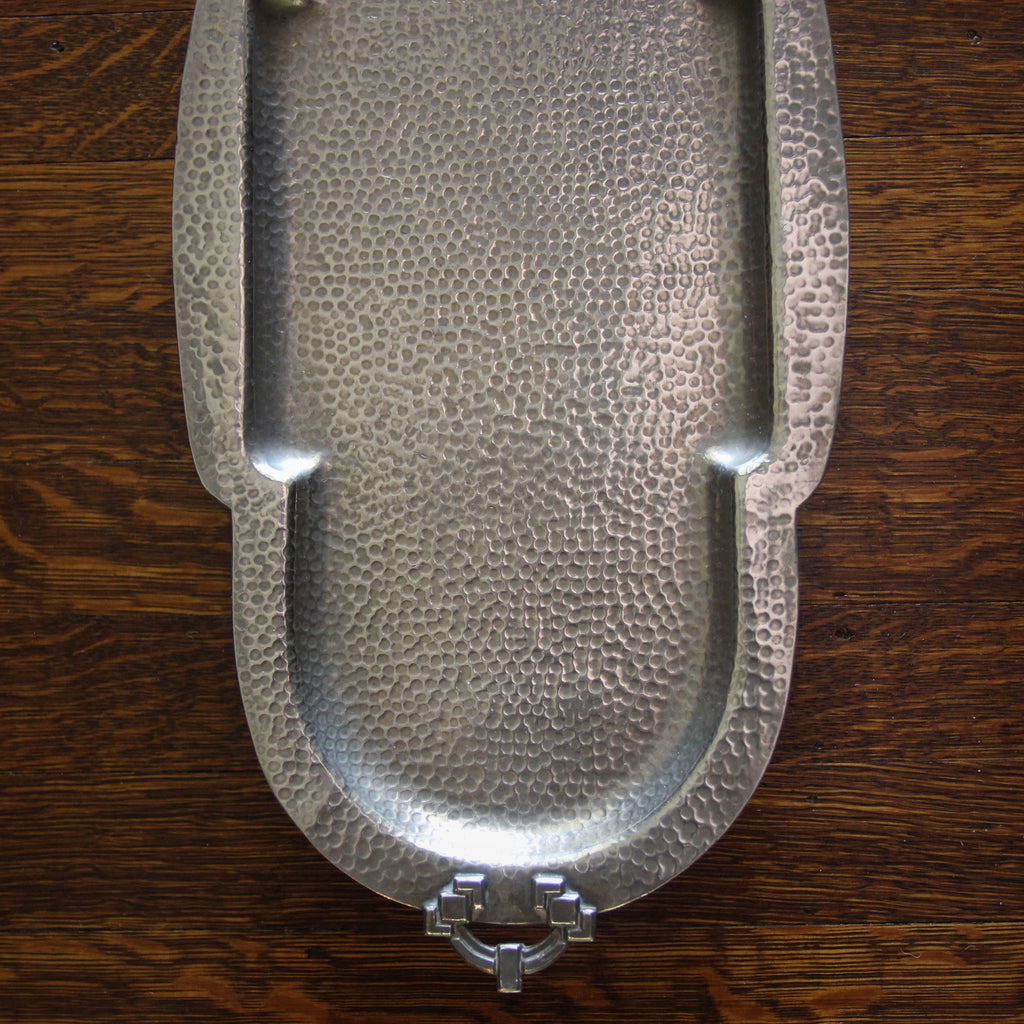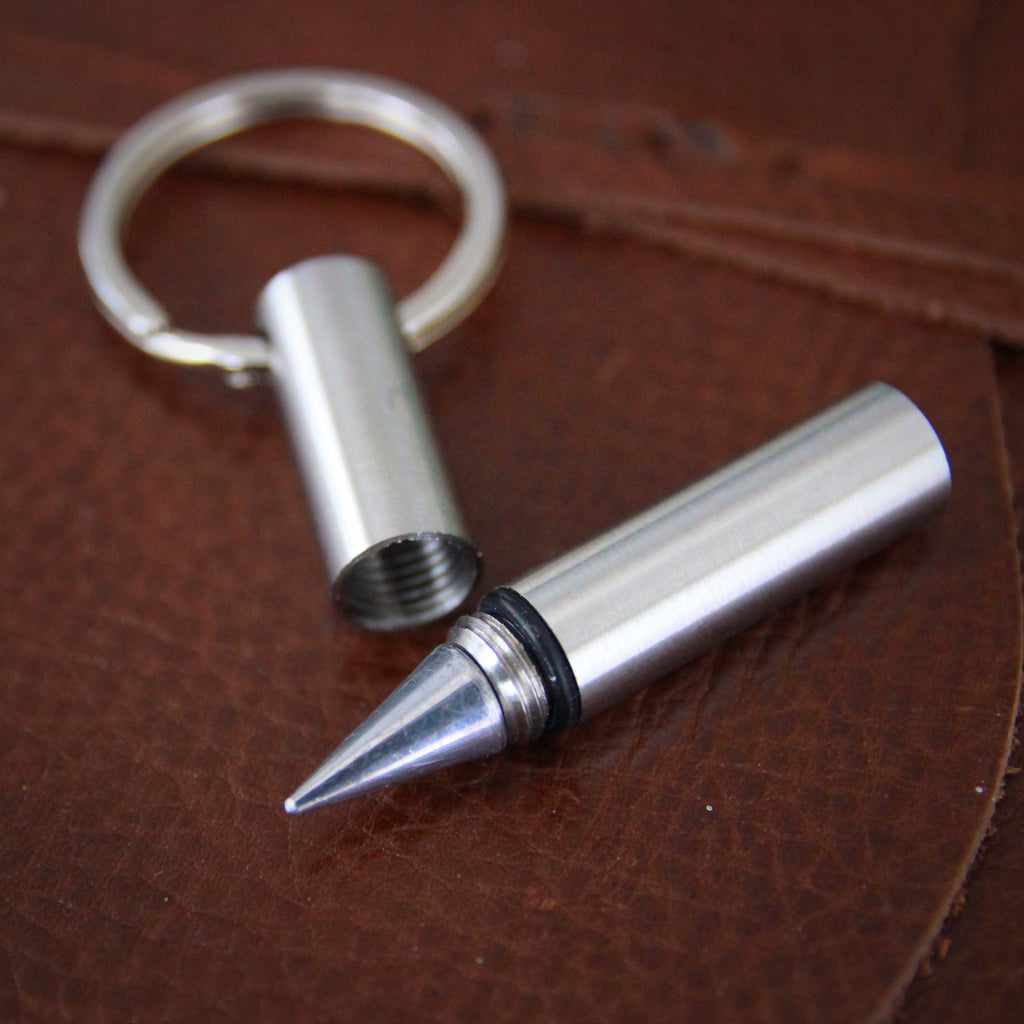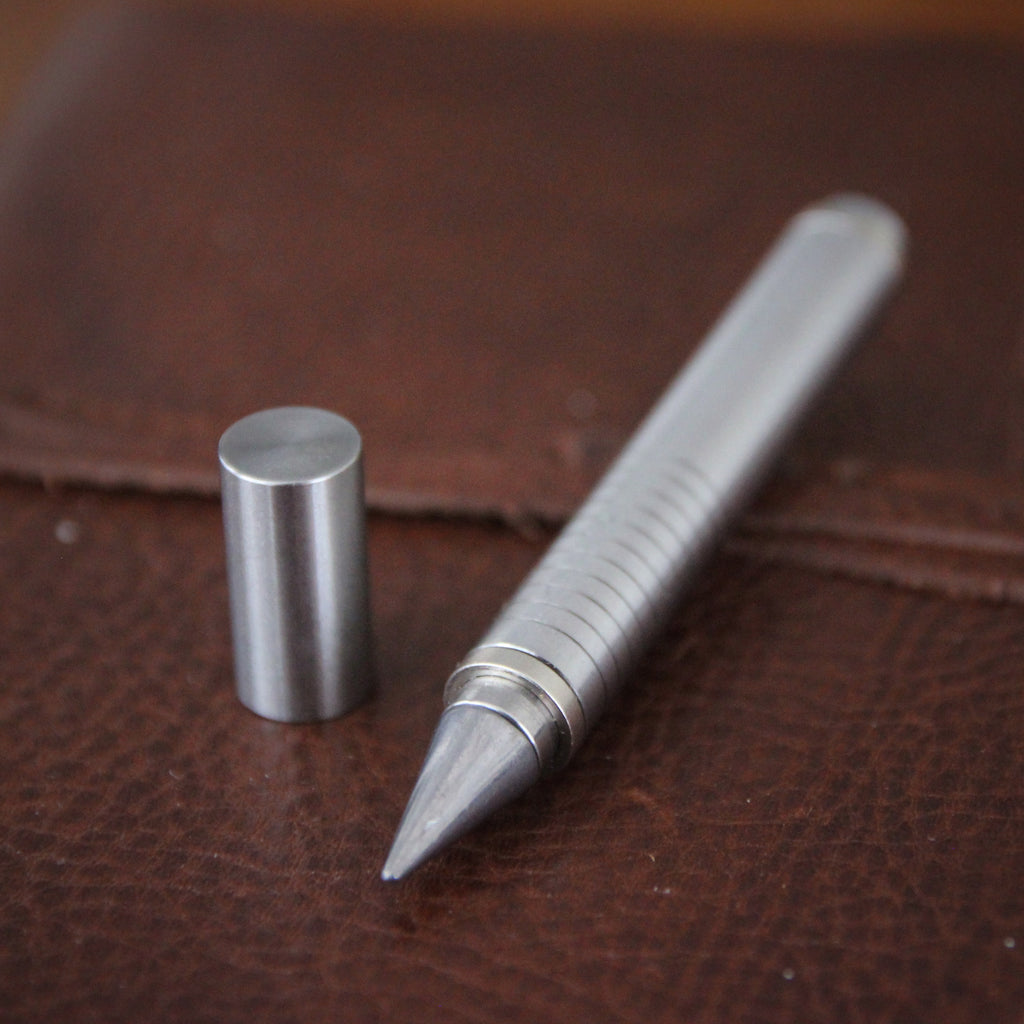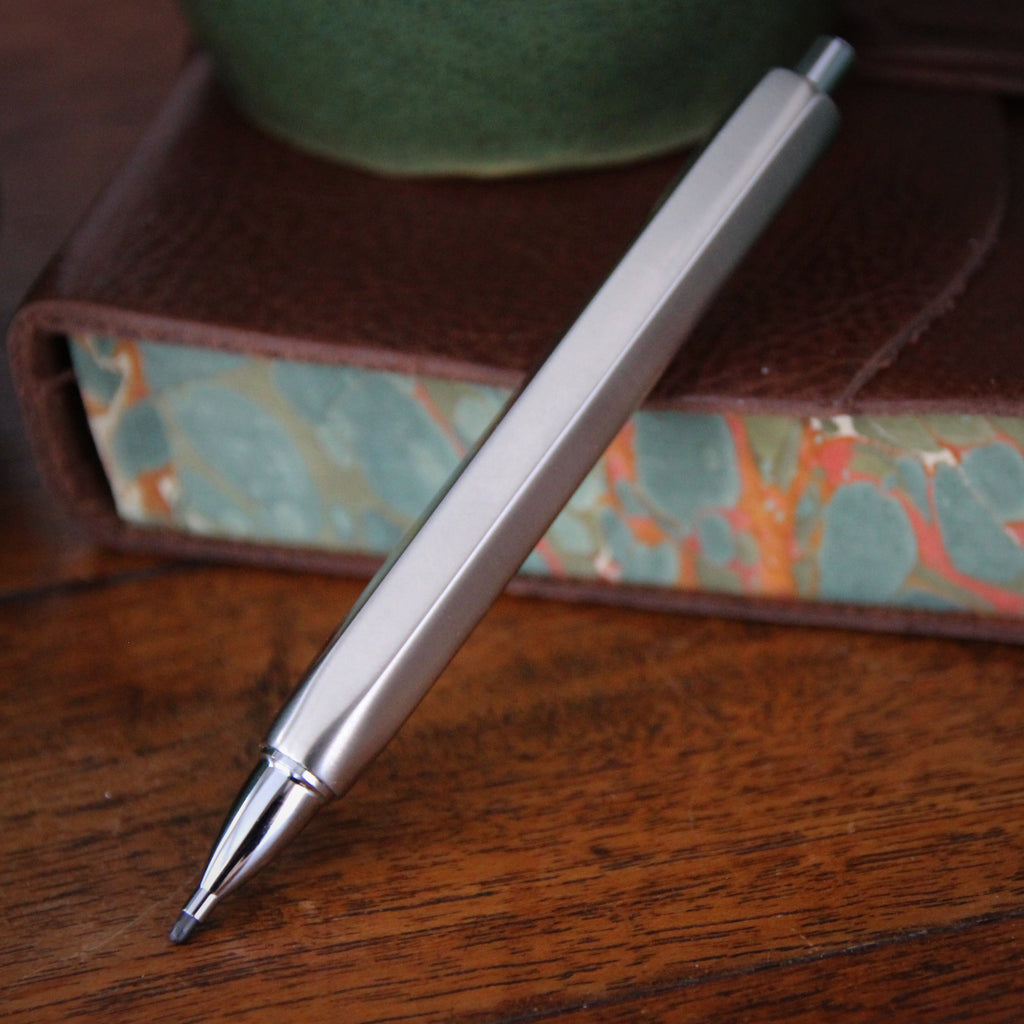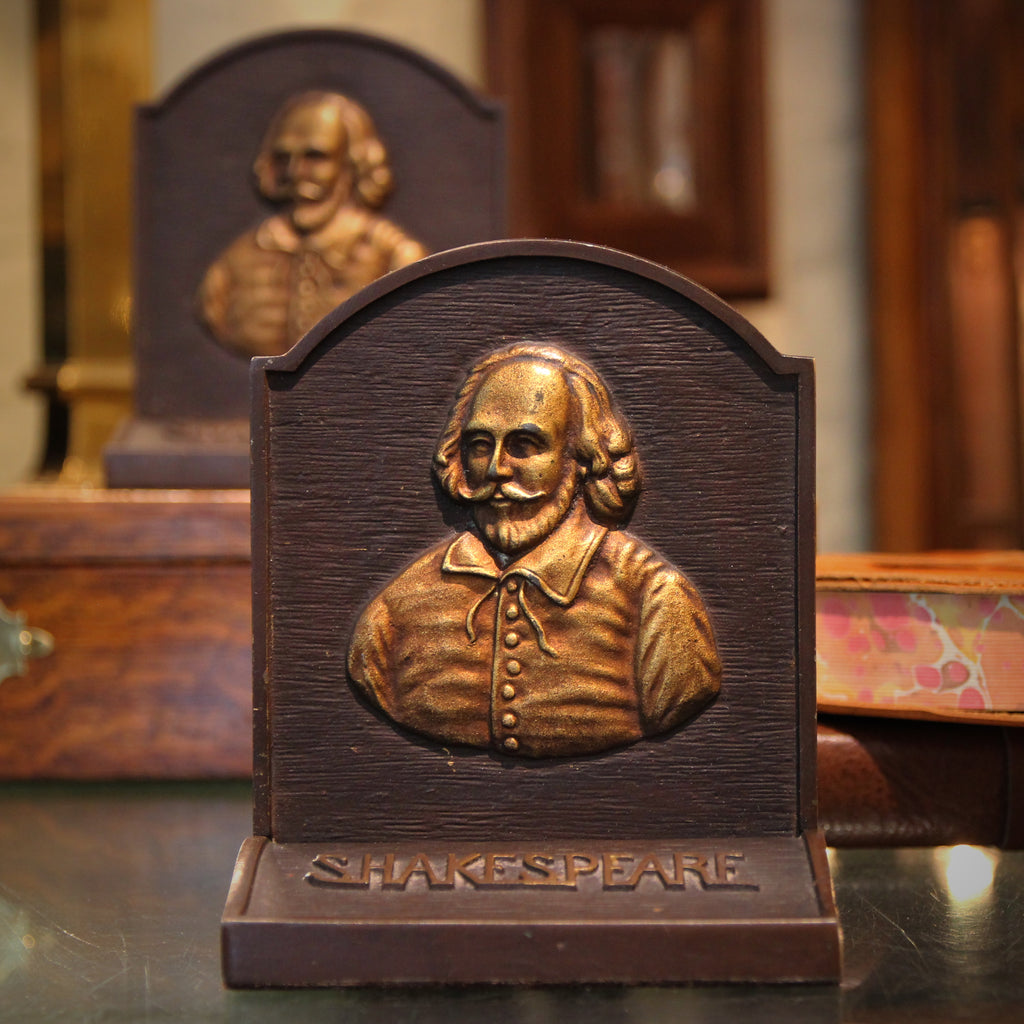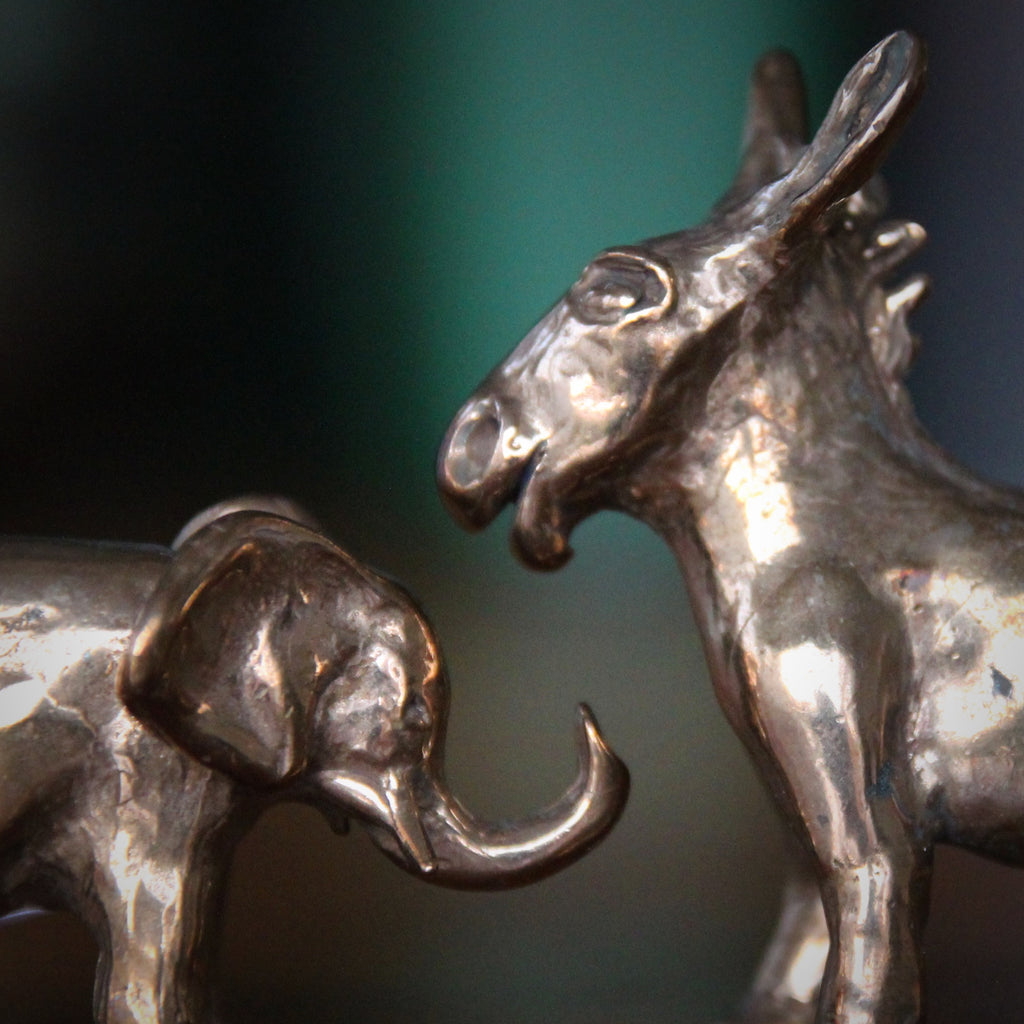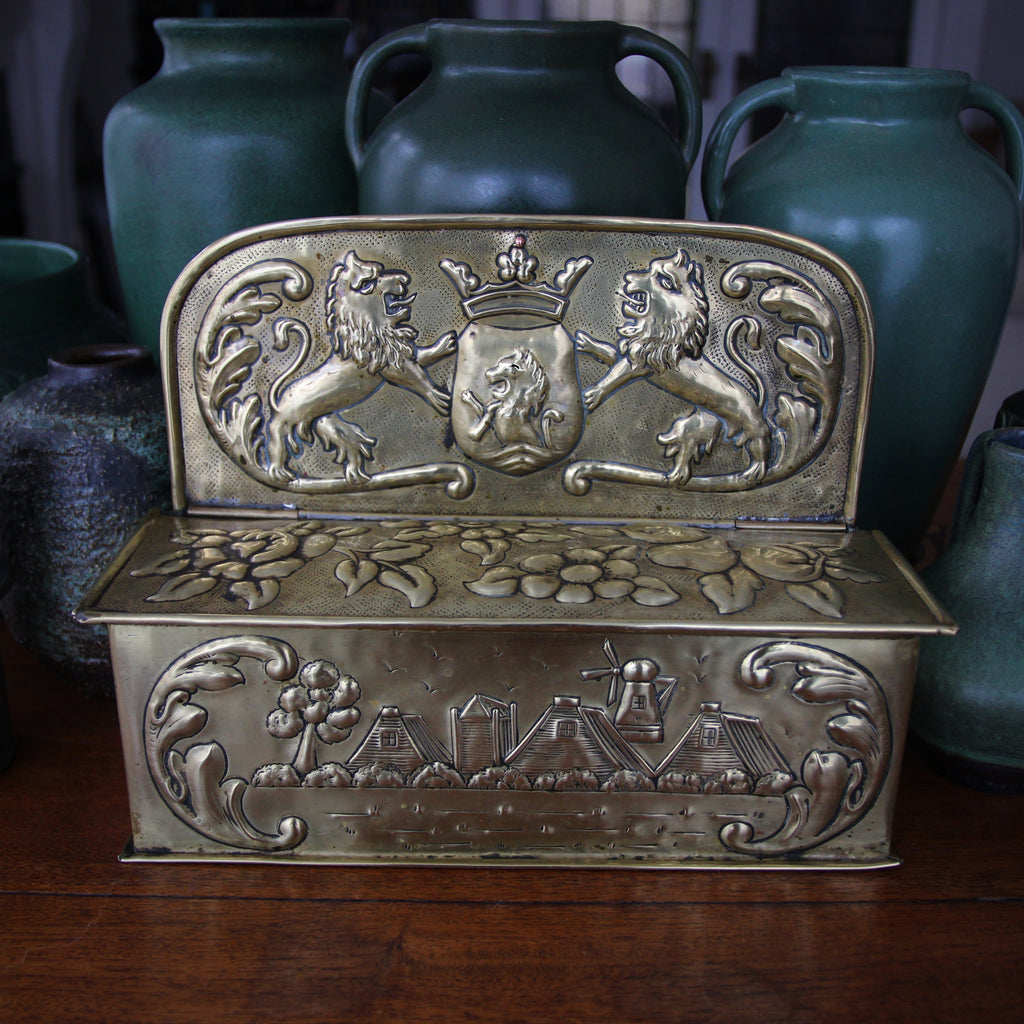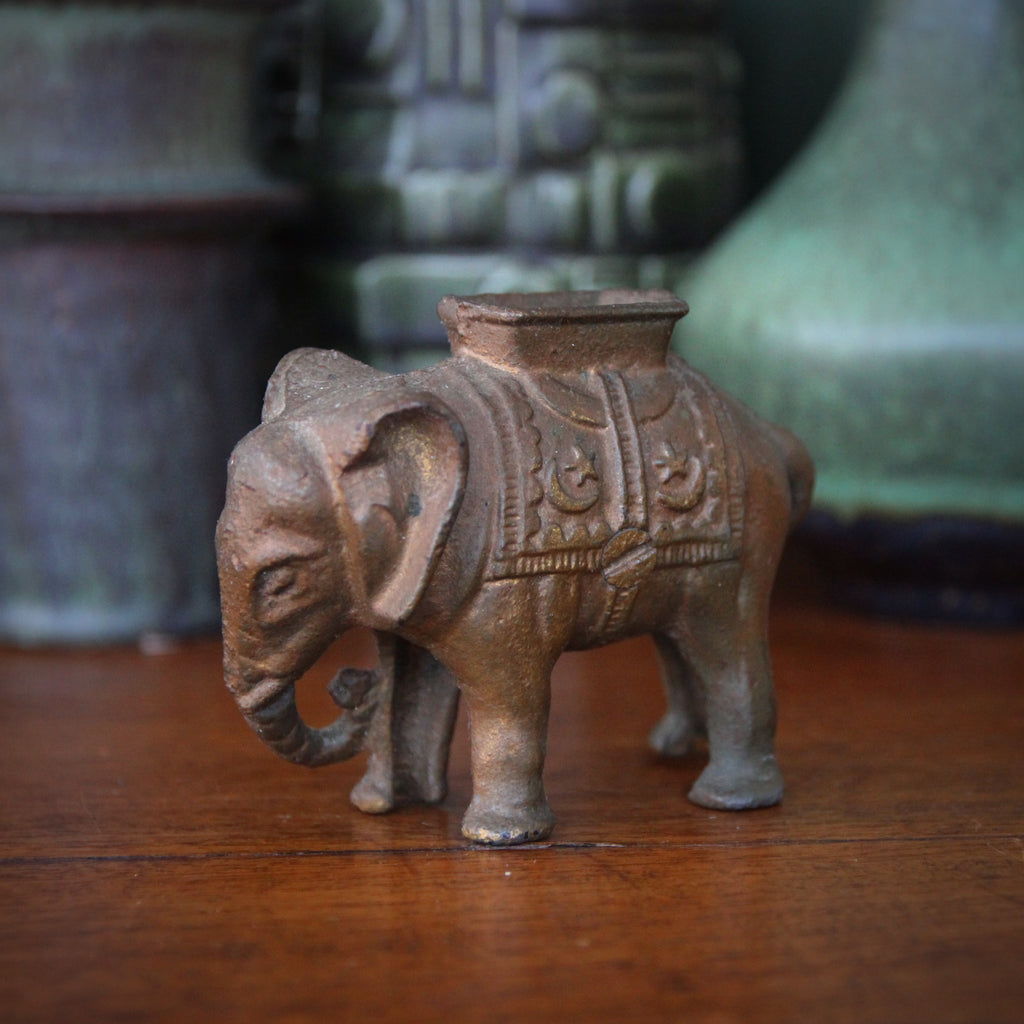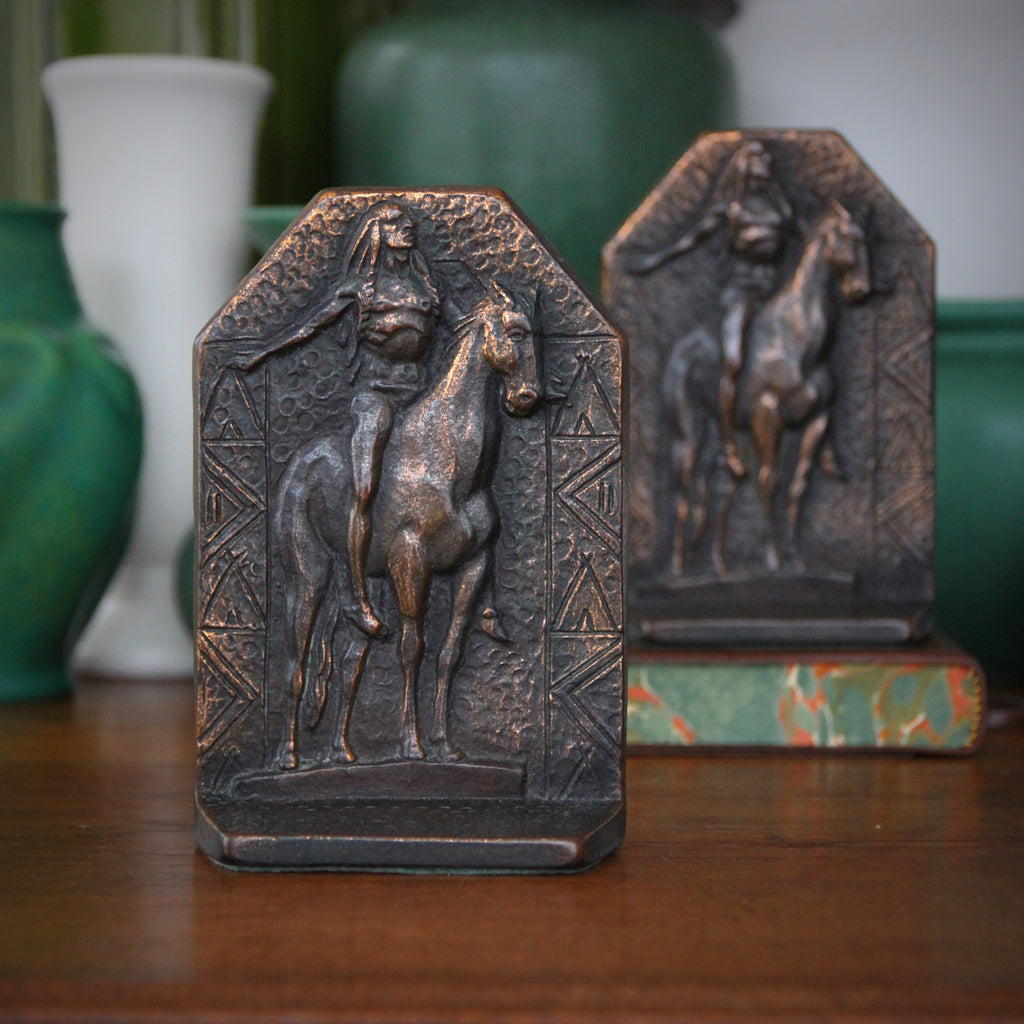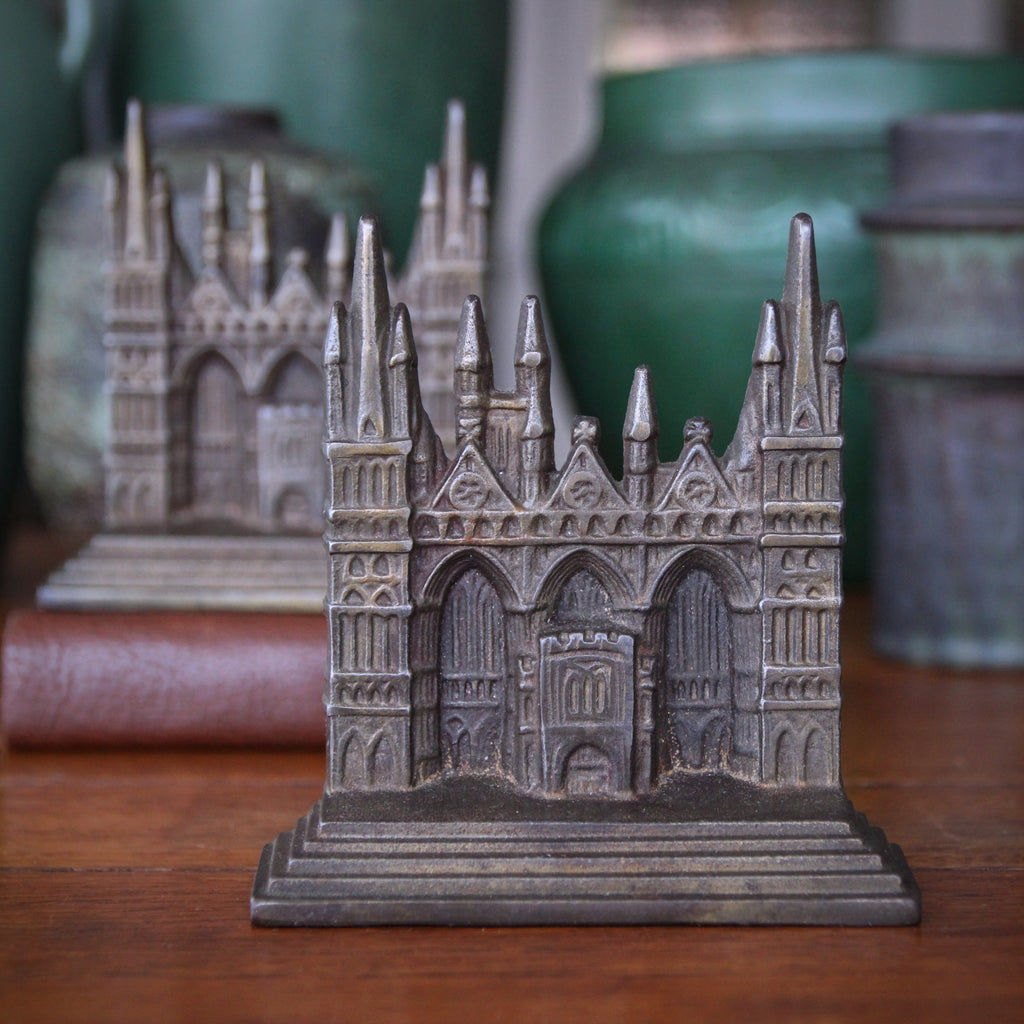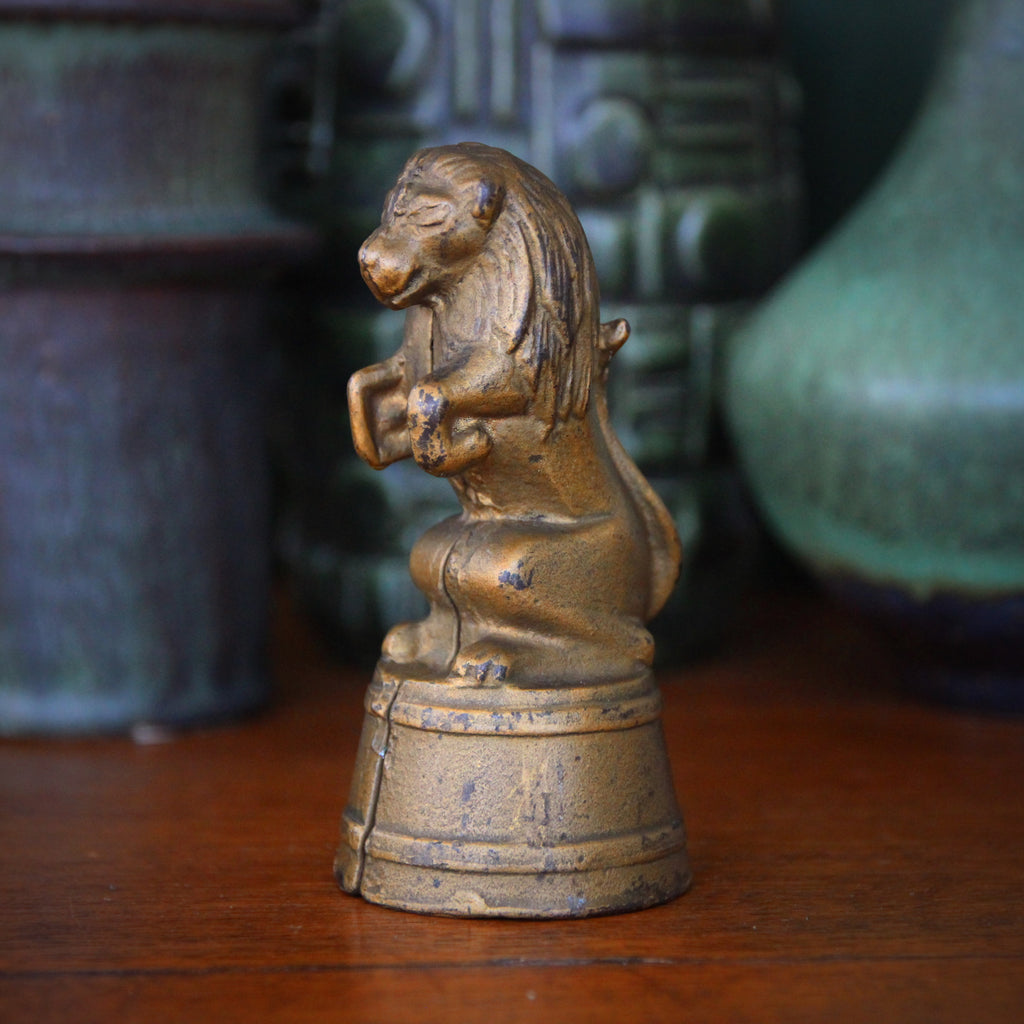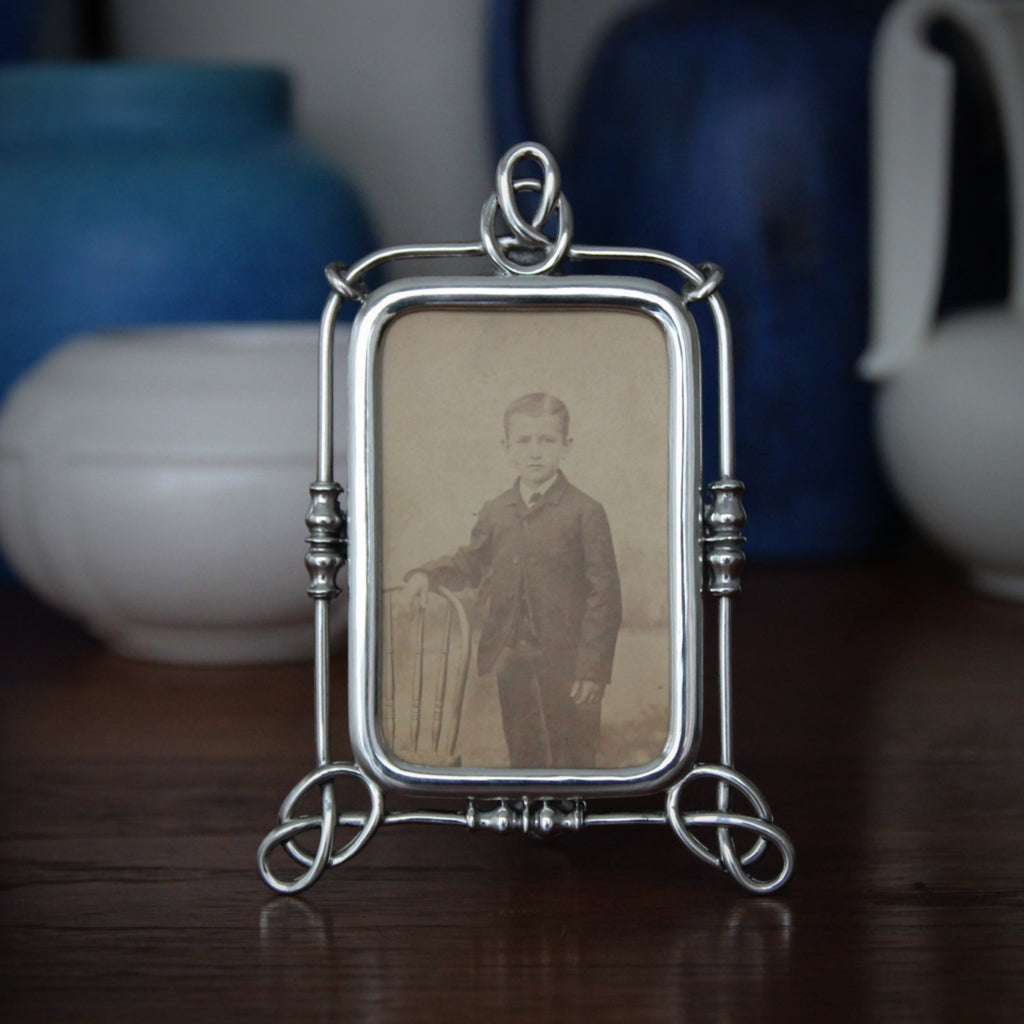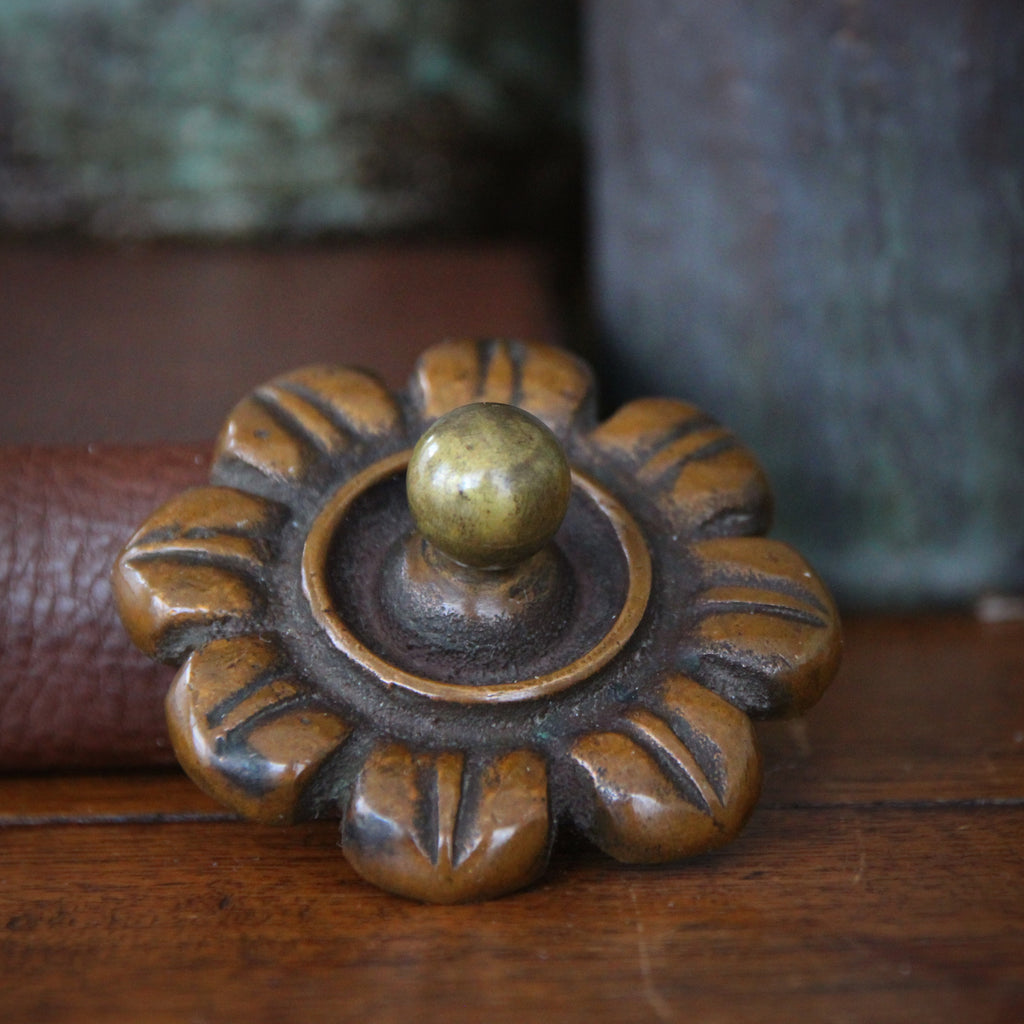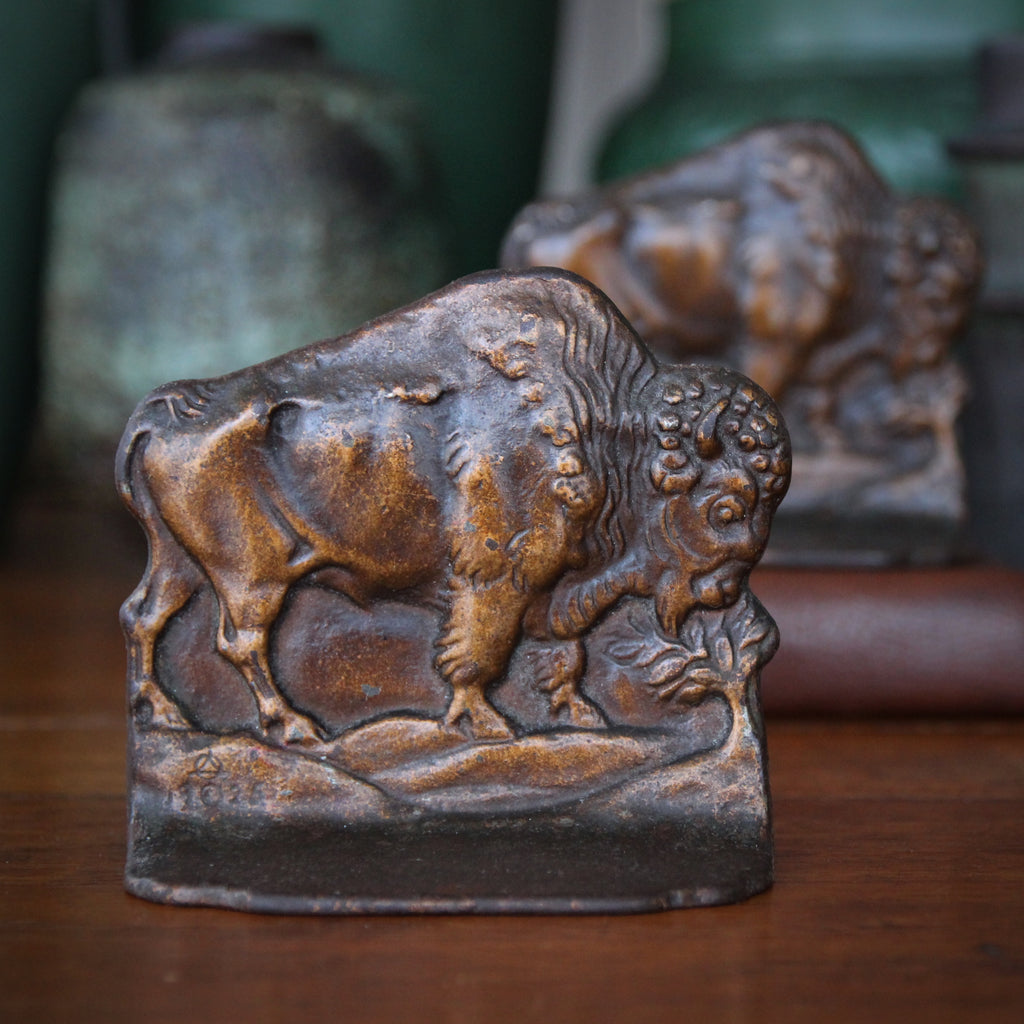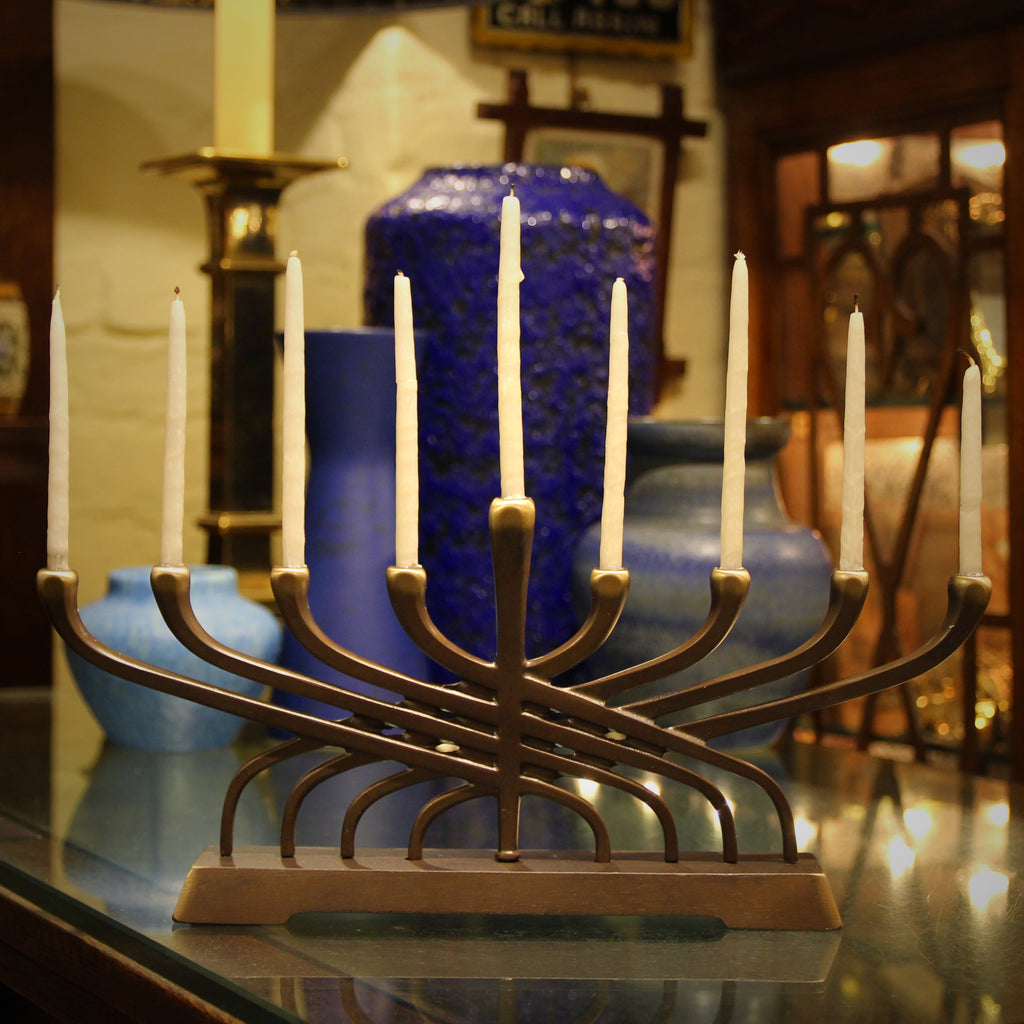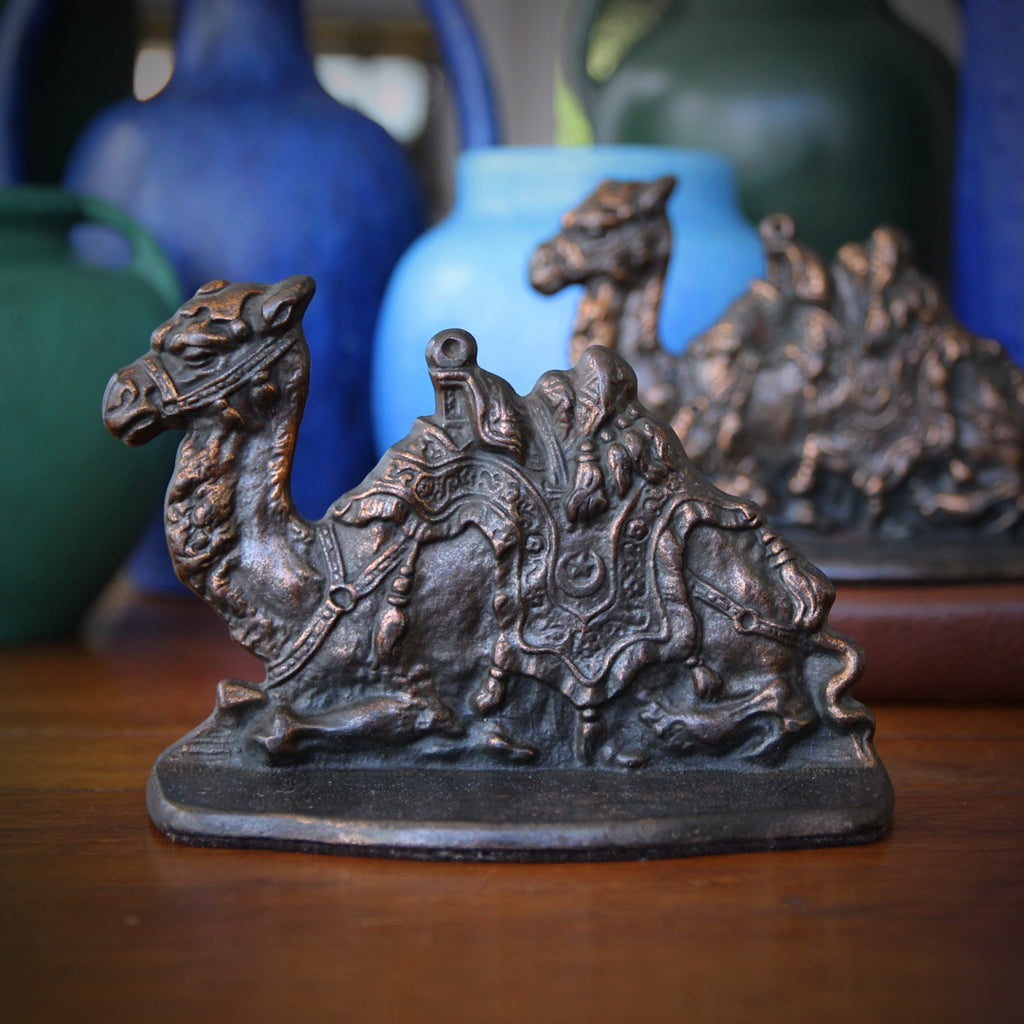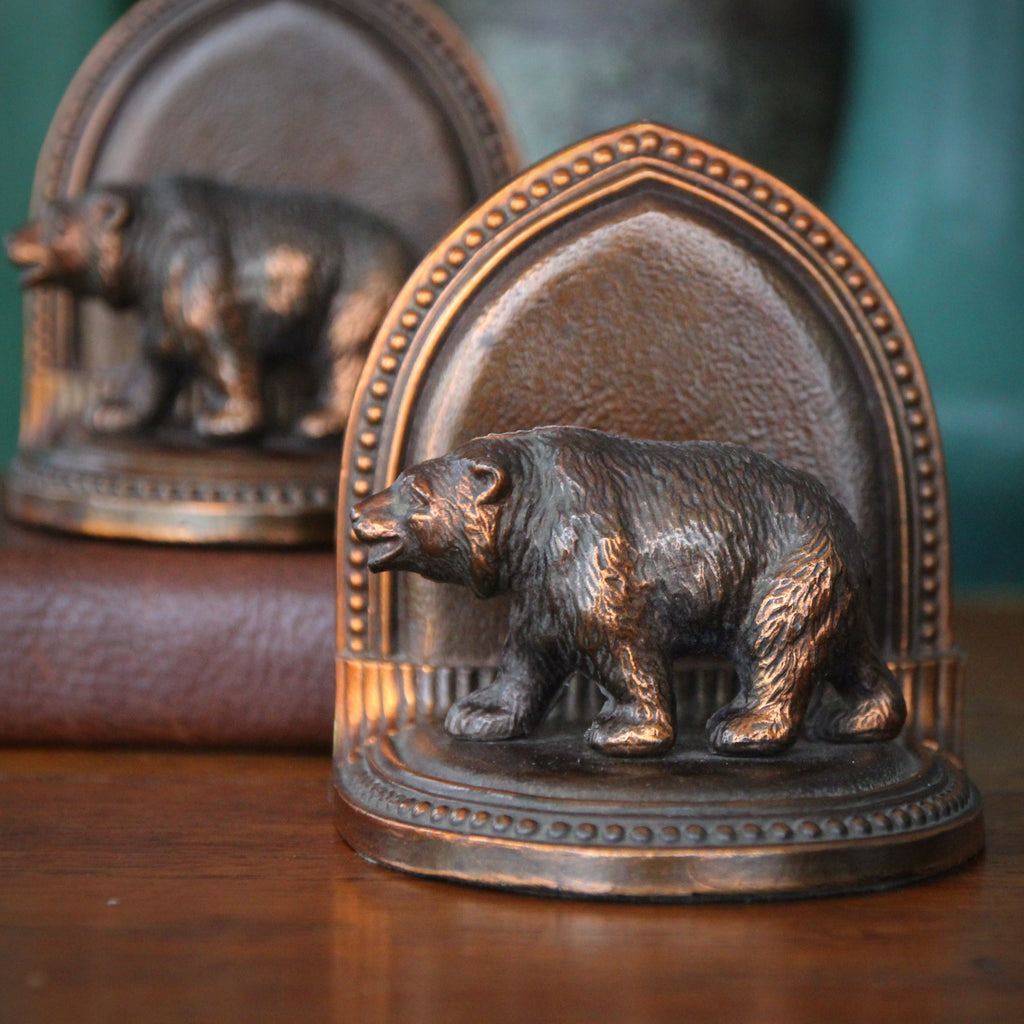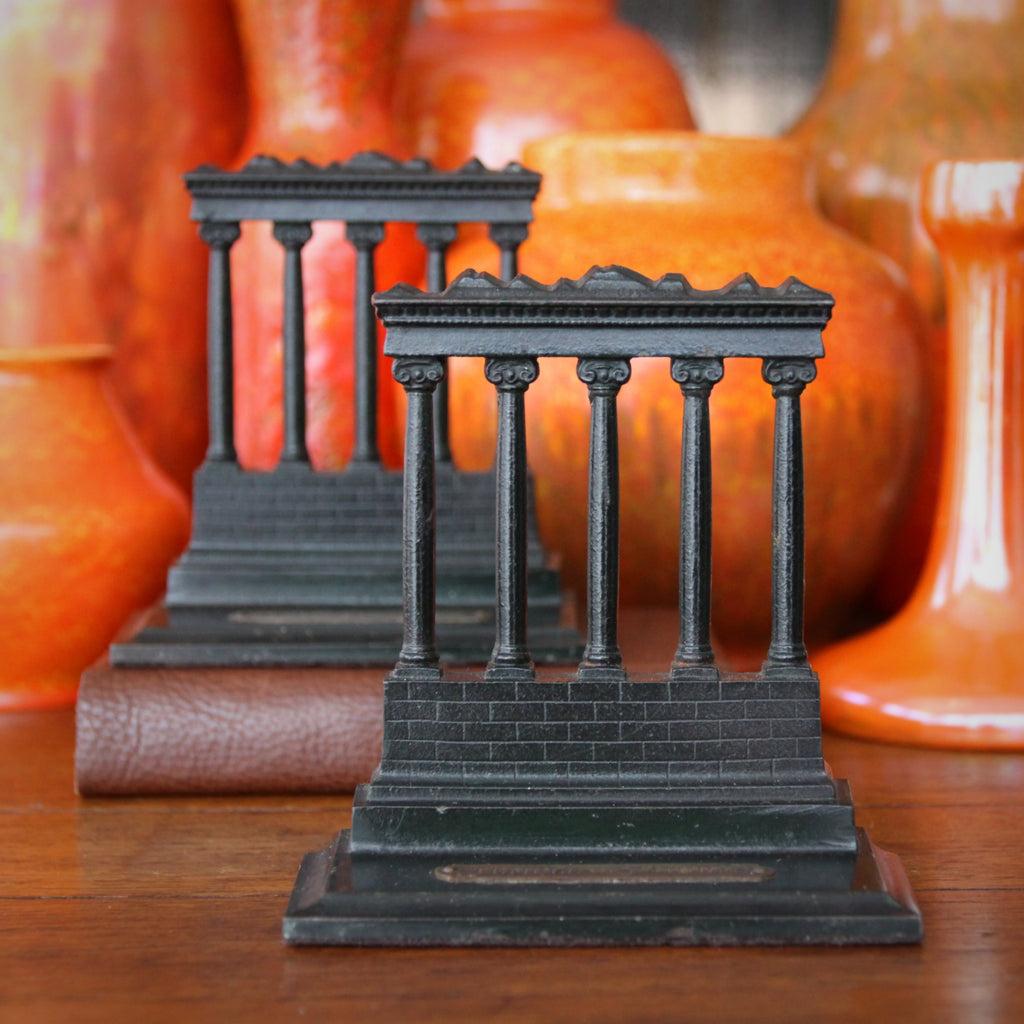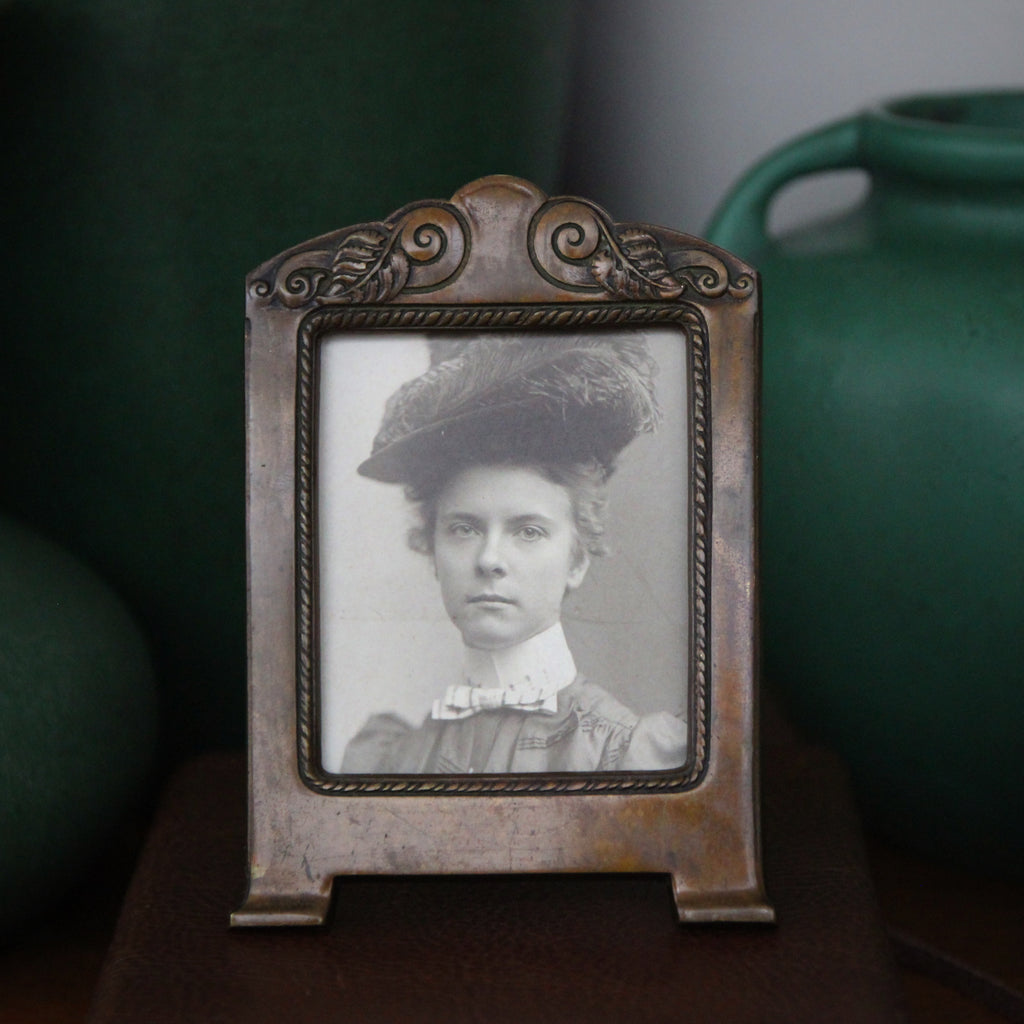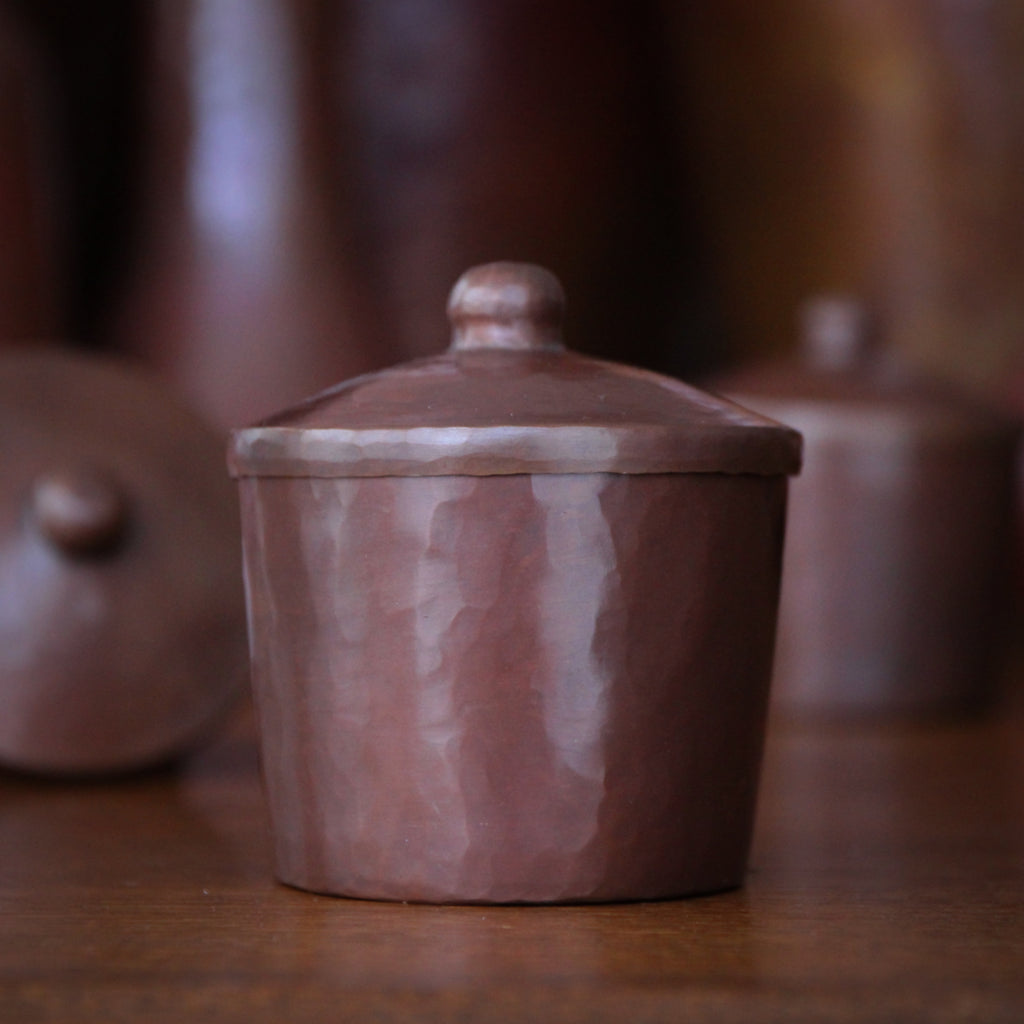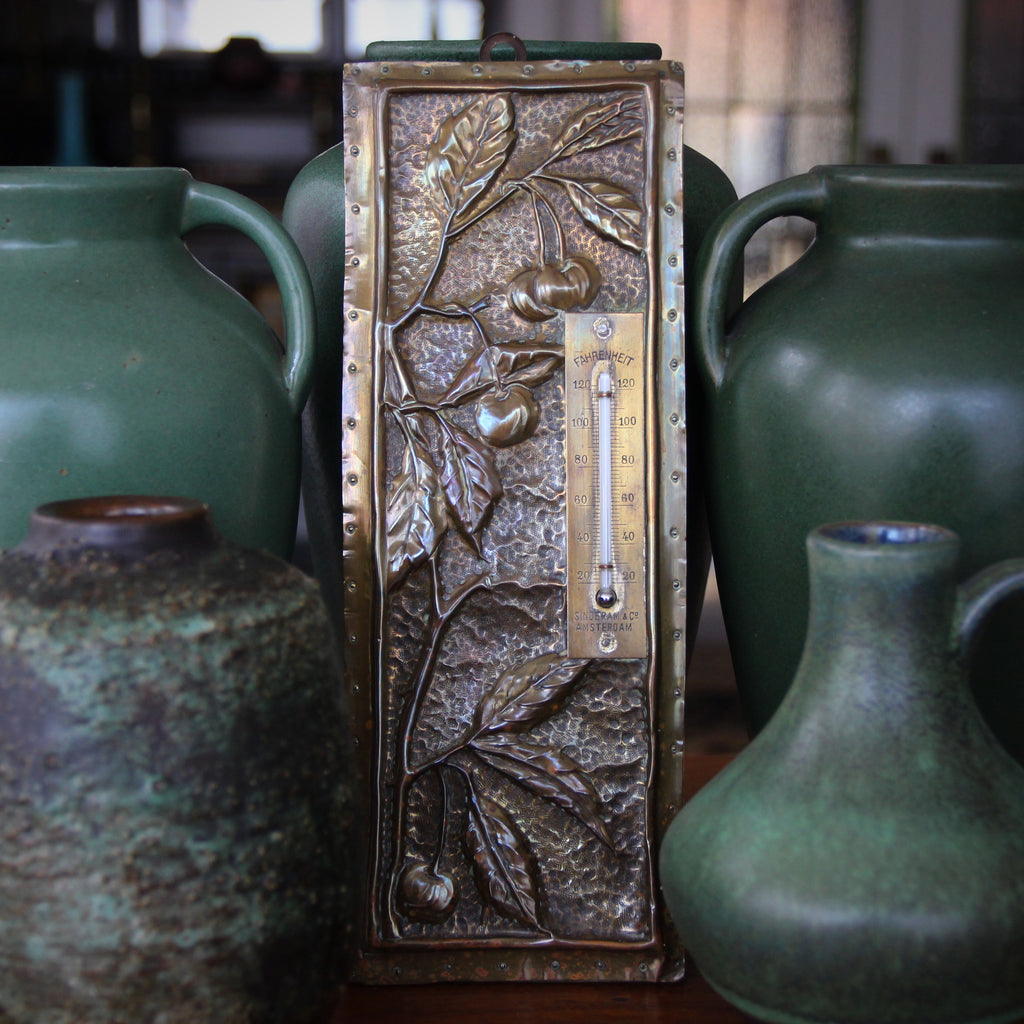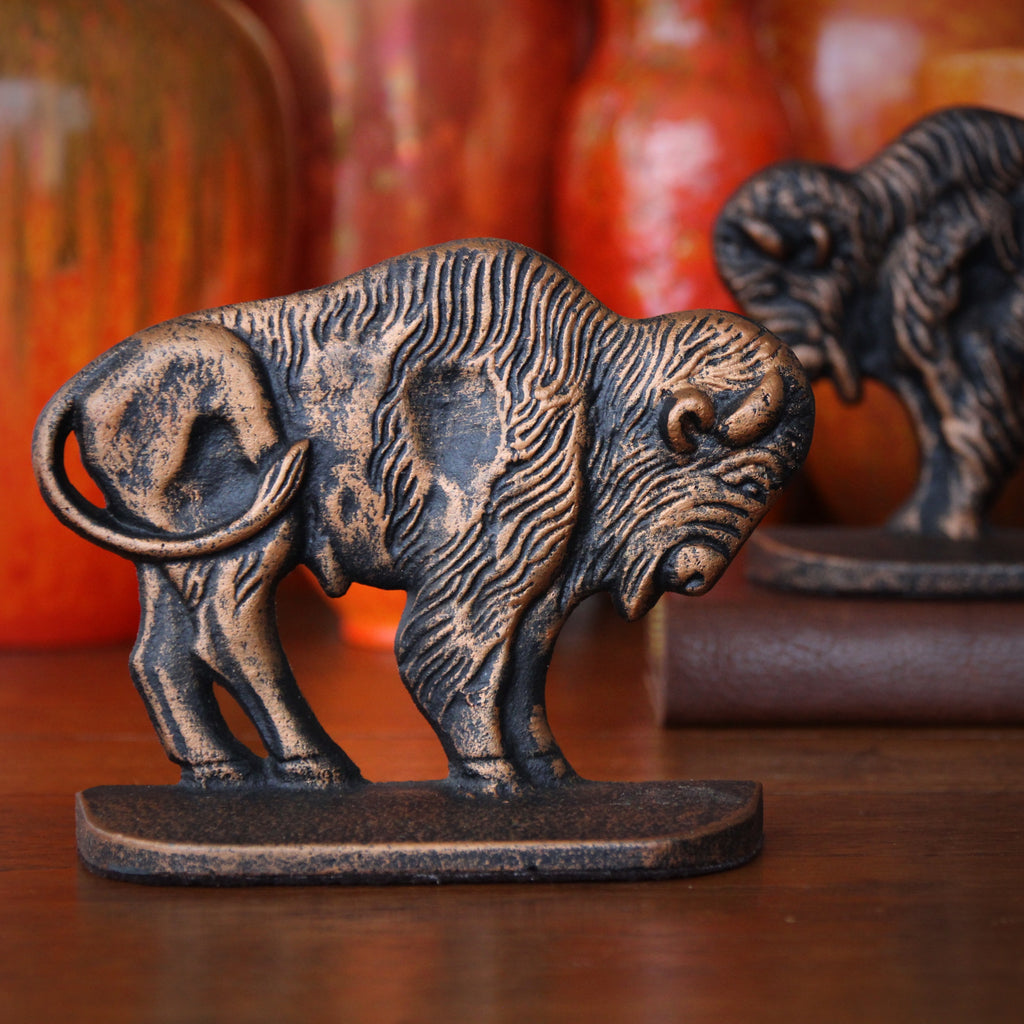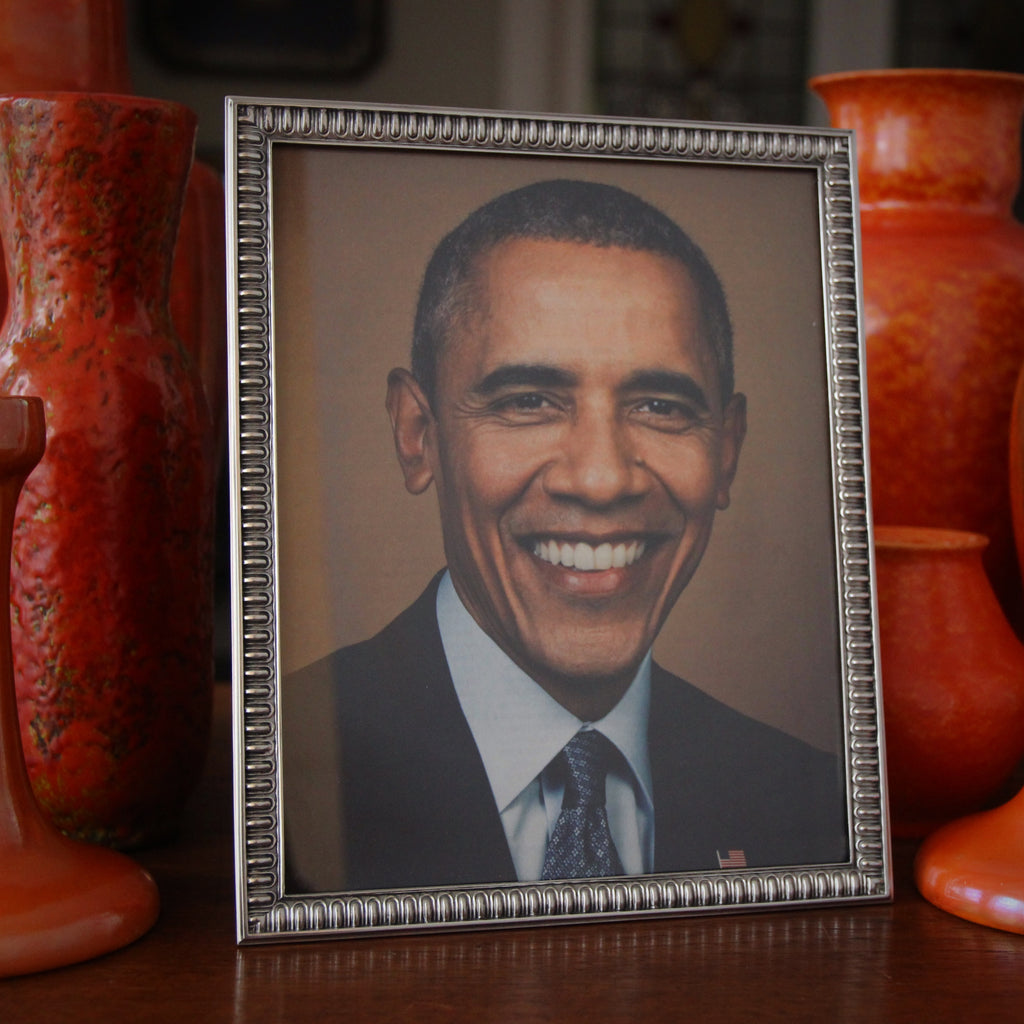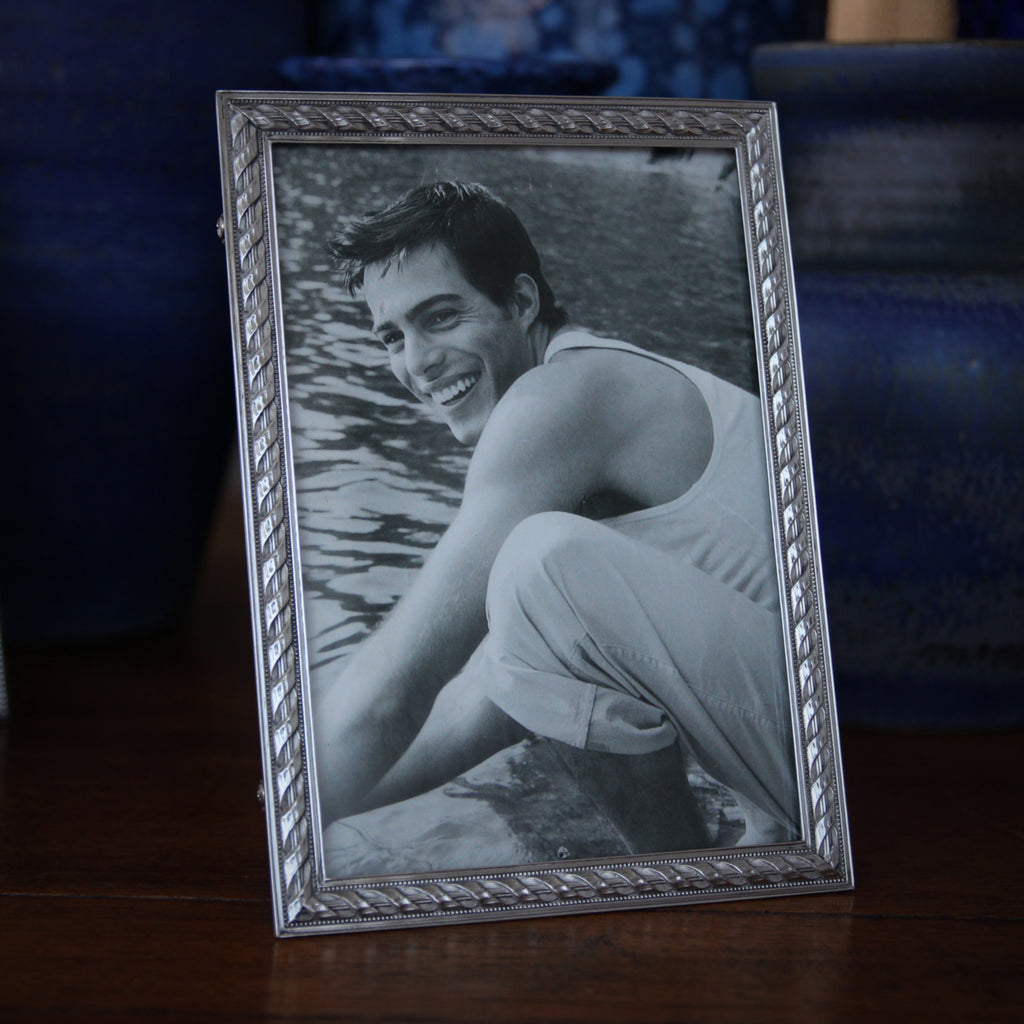JOURNAL — Metalwork RSS
Nice little boxes can be very useful. Holding pills on a kitchen shelf, storing cufflinks at the bedside, or presenting a long-anticipated wedding ring to a future spouse—little boxes can combine function with tremendous style.
This little oval pillbox, made in Edwardian Scotland (c. 1905), is crafted of two beveled ovals of banded agate—browns, caramels, tans and whites. "Engraved" gold-plated sides complete the look handsomely.
More Stately Charm
Here's another handsome brooch, this time Scottish. It features a polished banded agate cabochon in multiple shades of browns and whites. It is set into a silver mount, lapel pin attached. It has almost an "abstract expressionist" sensibility—remarkable considering that the stone itself may be a million years old.
Creamy, Dreamy
I don't really go-out on the hunt for women's jewelry very often. But, while I'm searching for cufflinks, I sometimes come across a handsome piece of women's jewelry (often Victorian or Edwardian) that really speaks to me. No one would accuse me of selecting "girly" pieces. In fact, there is often a "stately handsomeness" to the pieces of women's jewelry I collect. This usually means serious (perhaps solemn) stonework and metalwork that revives the Gothic. Queen Victoria spent almost 40 years of her reign as a widow, and she wore dark and heavy mourning wear from her husband's passing in 1861 until her death in 1901. She set the fashion trends for her fellow countrywomen, especially the aristocracy. Thus, luckily for...
Welcome, June!
The birthstone for the month of June is not a "stone" at all. It is the pearl—the mysterious and exotic and (at one time) ultra-rare treasure from the seas. Pearls, which represent purity, innocence and humility, were once the most precious of all the jewels. Egyptian aristocrats would be buried with their pearls. The Ancient Greeks believed that pearls were the tears of the gods. The Bible tells of the wise merchant who would sell all his stock in order to acquire one perfect pearl. And "pearls before swine" is a classic metaphor for wasting something on a person who cannot understand or appreciate it. Even the Gates of Heaven are encrusted with pearls—"The Pearly Gates." The famous American gemologist...
Perilous Waters
In recent weeks, Shakespeare has been called-out for having been insensitive to important issues of racial injustice, White privilege and colonial oppression. British academics are reviewing The Bard's works to highlight the offensive language—and to adapt that which can be saved and cancel that which is unredeemable.
I am not writing an essay on cancel culture. But I'd hate to see Shakespeare revoked. Let me make six quick points:
On the Hunt
I have never been a hunter. Or have I?
As an antiques dealer, I've frequently woken-up well before sunrise. I've dressed for inclement, outdoor weather. I've prepared my gear (cash, notepad, bubblewrap). I've travelled long and inconvenient distances to "the best hunting spots." And I've methodically stalked my quarry—sometimes in frenzied competition with my fellow hunters. The goal: to make a "clean kill" (that is, a profitable purchase) after which I will "dress" (clean and prepare) the game, and drag it back to the shop (hoping it will someday feed my family). Once in a while, I will keep a particularly prized specimen as "a trophy" for my collection.
Revisiting History
Amongst the nicest—and heaviest—bookends I've ever carried, these stunners were made by Judd Manufacturing in Wallingford, Connecticut in the 1920's. They are made of cast iron, but refined with a bronze finish, which provides a smoother, more sophisticated surface appearance. And the sculpting is very well done. The handsome chief, shown in full, feathered headdress, is modeled with great skill and attention to detail.
Judd Manufacturing
Judd Manufacturing got its start as a blacksmith foundry in New Britain, Connecticut during the Revolutionary War. It later reinventing itself as a harness maker, selling sleigh bells, saddles and other equestrian gear. Over the years, the company grew, changed hands within the family, and even split into two separate companies—one moving to Wallingford, CT and the other moving to New York City. In time, the New York City division prospered and bought-out the Connecticut factory. In the late 19th and early 20th centuries, Judd made decorative metalworks for household use: banks, doorstops, door-knockers, inkwells, animal sculptures and (most famously) bookends. The company was purchased by Stanley Works (New Britain, CT) in 1954.
Two Months 'til LEO
The sunsign LEO begins in two months—23 July! Spelter is an alloy, that is a blend of metals, with zinc as the main component. Like bronze, spelter can be cast with very crisp, delicate details. Yet it is lighter and less expensive than bronze, making it an attractive alternative for sculptures and other metal objets (especially those which are not subject to rough handling, extreme weather or heavy use). The Viennese are well-known for their excellent cold-painted bronze and spelter sculptures. "Cold Painting" is the process by which finished sculptures are hand-painted with an enamel paint after the metal object has been cast and prepared. Great detail and fine paintwork is possible—though the paint is subject to chipping if roughly handled...
Wisdom
Wisdom just isn't what it used to be. For millennia, scholars, writers, theologians, philosophers and kings have sung the praises of Wisdom—the ability to think and act with understanding, knowledge, experience, prudence and common sense. The Old Testament devotes a book to Wisdom. Solomon valued Wisdom above all other blessings. Jesus preached about the wise steward, the wise builder and the five wise virgins (with their lamps). Saint Thomas Aquinas called Wisdom "the father of all the virtues." Even the word philosophy means "the love of Wisdom." She (for Wisdom is always a woman) was personified: the Greek goddess Athena and the Roman goddess Minerva represented this most important virtue. And artists through the ages have painted and sculpted...
Accessories for the Natural Man - XVIII
An understated white-speckled brown enamel inhabits one corner of these English Art Deco cufflinks from the 1930's. Directly across the face, the chromed metal is broken into two fields: one is textured while the other is smooth. In the center, running diagonally between the fields is a cream enameled bar. Lots of activity and lots of motion make for a dynamic design, quite unlike any other cufflinks.
Accessories for the Natural Man - XVII
Here's another handsome pair of English Art Deco cufflinks. This time, the face of the cufflink is bisected with a deep furrow, slashing-though the color blocks of brown and white enameling. And while the coloration of the enamel is understated, the visual effect is nonetheless bold. Made in the Thirties in England.
Accessories for the Natural Man - XVI
"Soft squares" of black mother-of-pearl are machine engraved with a flower petal design (also known as a "corollate"design) and mounted into art deco settings. They make for a handsome cufflink, well-suited to shirts (or shirt stripes) of many different color variations.
Accessories for the Natural Man - XV
Art Deco was vastly popular—and it lived a good long life. After World War One, Americans (and others) felt that they were now living in a new, modern world. They embraced the streamlined, forward-looking aesthetics of the Art Deco movement. And, luckily, Art Deco was perfectly suited for the kind of mass production that was necessary to make a lot of new stuff to satisfy a growing, post-war middle class.
These English Art Deco cufflinks are chromed and then punctuated with chocolate and cappuccino enameling. If you want, you can imagine that the graphic symbolizes "V for Victory"—though, in truth, these cufflinks were made a few years before the war touched-down in England.
Accessories for the Natural Man - XIV
The crisp, bold graphic on these cufflinks—presented in unusual rootbeer and taupe enameling—makes me think of the "V" in "Victory." It's easy to see victory everywhere, especially in hindsight, when looking at something English from the Thirties or Forties. But British victory in the war was never a certainty. World War Two was fought hard and long—and the British paid dearly for their win. As for these cufflink graphics, they were probably made well before England entered the war (or even before there was a war). So I guess I'm just being a romantic, or, perhaps, fanciful. What is true is that these cufflinks are quite unique, especially regarding their coloration, and they do enjoy a strong and handsome graphic design....
Accessories for the Natural Man - XIII
A few days ago, we shared some "Toledo" cufflinks—damascened, mixed -metal accessories in the traditional Central Spanish style. Here's another pair. The body of this cufflink is quite interesting; it resembles the cross-section of galleon's hull, laden with treasures, no doubt.
Accessories for the Natural Man - XII
Though I purchased these cufflinks in London, I have never been convinced that they were made in England. Something about the "large stone" slightly fascist design hinted at an Eastern European (or Soviet Bloc) origin. They are set in Art Deco mounts—indicating that they are from the Thirties—a period when such "Brutalist" stonework was not really en vogue in the British Isles. In this regard, they are just slightly ahead of their time. (Big-stone cufflinks became popular after World War II, even more so in the Sixties and Seventies). Regardless of the time or place of creation, one must admit that the banded agate is simply beautiful. Caramels, whites and rootbeer colors form spontaneous streaks of stone—which was then cut, bevelled, polished...
Accessories for the Natural Man - XI
The Scots love their stones! From the rusticated architectural building-blocks in Edinburgh to the inlaid agates in their "Penannular" shawl-fasteners. And what seems to be important isn't whether the gemstone itself is valuable in the eyes of the world but, rather, is the stone colorful, beautiful, and Scottish in origin. Like so many things Scottish, the best things come from the land. My favorite things in Scotland are hard, durable and weather-beaten. After all, this is a country represented by the thistle—a wiry, spiky and tenacious plant which clings to life in the rocky, cold and windswept mountain terrain. These cufflinks, made in the 1920's, are fashioned from oval cabochons of polished "hardstone"—mostly oxblood, with a dose of brown, and...
Accessories for the Natural Man - X
We're spending a few days showcasing some accessories "for the Natural Man"—cufflinks in the subtle, low-key shades of brown, rust, cream, black and white. You'll find them (and many others) for sale on the LEO Design website.
These black mother-of-pearl cufflinks are ultra-iridescent—the "highlight colors" are lush and varied. They are set into gold-plated mounts and you can learn more about them by clicking on the photo above.
Accessories for the Natural Man - IX
In the 1930's, functional graphics in England took on a particular look—clear, soft, round—and one can see great examples of this in vintage enameled railway signage from the period. Sometimes the signage was in brown, sky blue or green, giving the signage a "softer" more natural appearance. This contrasts with American signage of the period which was often red, yellow, orange, black or white—meant to "pop" not "complement" the surroundings. Furthermore, many of the signs were produced with rounded corners which served to soften the sign's appearance even more.
Accessories for the Natural Man - VIII
Tracery is most often associated with Gothic architecture—for example the lacey, carved-stone windows in a church (usually filled with stained glass) or pierced woodwork (including trefoils and quatrefoils) that decorates the interior. These Art Deco cufflinks, while they make no pretense to Gothic style, have metallic tracery overlays which are derivative of the Medieval style. The gilt metalwork lies upon mother-of-pearl faces and are set into gilt (that is, lightly gold-plated) mountings. Click upon the photo above to learn more about them.
Accessories for the Natural Man - VII
This pair of goldstone cufflinks is as "flashy" as we will get this week. In truth, "goldstone" is not a stone at all; it is a glass carrying suspended copper crystals which create a sparkling, metallic optical effect. For centuries, goldstone was believed to have been invented in Venice by the Miotti family of glassmakers. In the 1600's, the Venetian Doge granted the family an exclusive license to produce goldstone. More recently, a Persian amulet (dating from the 12th or 13th century) has been discovered, showing that goldstone had been produced elsewhere and earlier.
Accessories for the Natural Man - VI
At first glance, these cufflinks seem to have very little decoration to them. But, upon closer inspection, there is quite a bit of subtle detail work which adorns them. First, they are crafted in an interesting, modernist "lozenge" shape—essentially a soft rectangle. Then the centers are etched with very fine diagonal lines. The end quarters are etched with a contrasting crosshatch effect. Finally, two of the corners are "dipped" into brown enameling, giving the piece an interesting "twisting energy." But all of this is only appreciated by someone who takes the time to study and understand the cufflinks.
Accessories for the Natural Man - V
Toledo is an ancient city in Central Spain, about 45 miles south of Madrid. In Medieval times, it was known as a place where Christians, Jews and Muslims lived together (for better or worse), with each group contributing art, architecture and cuisine to create a rich, blended culture. But long before this, Toledo made its mark as the place where the finest forged-steel swords were made. Metalsmiths in Toledo invented a technique of forging hard and soft steels together, creating swords that were strong and flexible. From 500 BC, the Romans discovered that they wanted their weapons from Toledo.
Accessories for the Natural Man - IV
Every now and then, a customer will want to buy a pair of cufflinks for a young man. Sometimes he's about to graduate from high school or university. Or, perhaps, he's been invited to his first dressy function. This will be the young man's first pair of cufflinks—and the shopper asks for a little advice.
White mother-of-pearl cufflinks are the most neutral and one can never go wrong wearing them with black tie or a dinner jacket. But white (dressy) mother-of-pearl cufflinks always exude a formal disposition—and a man with his first (and only) pair of cufflinks may want to be able to wear them with other shirts, on other occasions. In this case, I always recommend black mother-or-pearl.
Accessories for the Natural Man - III
Many people assume that the "repp" in "Repp Stripe" refers to the repeating pattern of distinctive, colored stripes often shown in ties or foulards. In truth, "repp" refers to the repeating tiny ribs woven into the silk fabric from which the ties are made (regardless of the color pattern). In the Medieval age, groups of knights would enter battle wearing distinctive heraldic colors or carrying flags which indicated the fighting team to which they belonged. Repp stripes are an evolution of this idea, adopted by (originally male) groups to distinguish themselves from other groups: schools, military regiments, social clubs, sports teams. Customized striped patterns and colors would be adopted as the "modern heraldry" of a specific group, usually woven into...
Accessories for the Natural Man - II
These understated Soviet cufflinks (hallmarked 1921 to 1958) are made of jasper—the opaque, highly polishable stone that comes in shades of brown, red, yellow or green. Jasper has been used as a coveted gemstone for millennia. Official seals made of carved jasper (used for authorizing or sealing documents), dating from 1800 BC, have been unearthed in the Minoan Palace of Knossos in Crete. Large pieces of jasper have also been crafted into boxes, urns, sculpture and architectural elements like the balustrades on a grand staircase.
The metal mountings on these Soviet cufflinks are silver which has been plated in a gold "vermeil."
Accessories for the Natural Man - I
Some men like to keep things understated. No flash. No bling. For them, we present a collection of "natural accessories"—cufflinks in decidedly "earthy" shades: brown, rust, black, cream and white (plus silver and gold). Call it an "Homage to the Seventies" or a solution for the modest mate. Find these cufflinks for the Natural Man on our website at LEO Design. Art Deco was a large and widely popular design movement. It conveyed "a modern feel," in keeping with the modern times after World War I. It was well-suited to mass production methods, necessary to satisfy a growing middle class with new-found leisure time and increasing disposable income (in contrast to earlier movements which required much more labor-intensive "handcraft"). And the Art Deco...
The King-of-the-Jungle
In nearly every world culture, the lion is admired (and equally feared) as a symbol of royalty, fierceness and brave leadership. To "lionize" a person is rarely considered an insult. That's why the lion is called "The King-of-the-Jungle" and is often included in the heraldry of nobility wherever lions are known.
In three short months, we'll be in the middle of the LEO sunsign (23 July - 22 August). Perhaps a handsome pair of bookends will make your favorite LEO happy? This pair, made of cast iron in the 1920's, are graced with a regal bas relief portrait of a male lion.
Japanning
With the increasing trade between Europe and Asia in the 1600's, Europeans got their first exposure to many Asian craft forms previously unknown in the West. Rich Europeans went wild! They loved the Asian ceramics, woodcarving and metalworks brought-home by merchants—and they spent big money expanding their collections. One of these "new" crafts was lacquerware. Europeans couldn't quite figure-out how to duplicate the Asian laquer process (in part because the necessary tree sap did not grow in Europe). Furthermore, European collectors began to suspect that Asian lacquer craftsmen were holding-back their very best pieces for their domestic collectors (which is not surprising). So, in the 17th Century, the Italians developed a faux laquerware which came to be called "Japanning." It did not use the proper Asian tree...
Great Writers: Dante
Italy's greatest writer (indeed, one of the Western World's most important writers), Dante Alighieri, was born in Florence in 1265. Alas, he found himself on the wrong side of a political battle in his home city. After supporting the (losing) White Guelphs, Dante was banished—upon pain of death—from his beloved Florence. After a bit of moving around, he settled in Ravenna, some 90 miles from Florence, where he died and is entombed to this day. Dante's greatest work, The Divine Comedy, was written during his exile. It is considered one of the most important works of literature of all time, in any language. And, unlike other important Medieval writers who wrote in Latin, Dante wrote in the vulgate, specifically the Italian Tuscan dialect. After...
Great Writers: Shakespeare
We don't know the precise date on which William Shakespeare was born. There is, however, a church record showing that he was baptized on 26 April 1564. He was probably born a couple (or a few) days earlier. 23 April has become a popular birth date speculation—which also happens to be the day he died in 1616.
Although Shakespeare's first days are shrouded in mystery, his works—poetry, sonnets and plays—are famously the most important body of work written in the English language. Through the astounding range of plays, characters and dramatic situations he crafted, Shakespeare distilled the essence of what it means to be a human—plays, characters and human situations which still resonate today.
Great Writers: Longfellow
"The Song of Hiawatha" is an epic poem by Henry Wadsworth Longfellow, published in 1855. It follows a number of American Indian characters—notably the warrior Hiawatha and his lover Minnehaha—along the southern shore of Lake Superior. It was an immediate success, selling over 50,000 copies in its first two years, and it created an indelible impression of Indian life and people in the popular imagination. Critics condemn the poem as the romantic creation of a non-native writer. Longfellow's source materials and understanding of real Native American culture have been called into question. Nevertheless, it is a monumental work of American Romantic literature and it played an important role in Nineteenth Century popular culture.
Champ & Major
After four years without (live) animals in the White House, first family pets are back! Champ and Major are two male German Shepherds, the family pets of the Biden family. Champ, now twelve years old, was purchased by Joe Biden from a Pennsylvania breeder to fulfill a promise to his wife—that he would get another family dog if he and Barack Obama won the 2008 election. Major is three years old and is the first rescue dog to live in the White House. Joe Biden's father would sometimes call the future president "Champ"—and this nickname was passed along to the older dog. The younger dog may have received his name as a tribute to Biden's deceased son, Beau, who was an Army...
Christening Cup
Baptism is an important (some would say vital) rite within the Christian Church. The ceremony, usually followed with a meal or other gathering, has become an opportunity to give a meaningful gift to the little one. In the Nineteenth and Twentieth Centuries, silver became the gift of choice as the precious metal was believed to confer healthful properties and was also a symbol of prosperity. Thus, a silver Christening gift would convey a wish for the health and success of the newborn. Since the Victorian Age, useful gifts—especially items associated with nourishment—have been popular. Silver spoons (perhaps engraved with the baptismal date) were very common (and could be used to feed the child). Cups, bowls and egg cups were other functional choices. Sometimes...
The Light of Asia
Sir Edwin Arnold (1832-1904) was a British poet, journalist and educator. He was sent to India in 1856 where he served as a school principal for seven years. While there, he was exposed to Buddhism, heretofore virtually unknown in the West. After returning to England, where he worked as a journalist, he published The Light of Asia in 1879. It was the first major exposure of Buddhism to the Western World. The book was a great success and has been translated into 30 languages, including Hindi. The book takes the form of a poem and follows the life of Indian Prince Gautama Buddha, his renunciation of his formerly privileged life, and his pathway to Enlightenment. Mahatma Gandhi, then a law student...
100 Days to LEO
Today begins the one hundred day countdown to LEO. Summer—and the leonine sunsign—will be here before you know it! This little cast iron bank, made around 1900, still has traces of his original golden paint.
Cutting It Close
Interestingly, while I very much dislike smoking, I have usually really liked smokers. Maybe it's their conviviality, their "lust for life," or—how do you say it—their joie de vivre. In an ideal world, I would have many friends who are healthy, former smokers. I have also always liked the accoutrements of smoking—ashtrays, tobacco jars, smoking sets. When I found this Spanish cigar cutter, I didn't have to think long before buying it. It's handsome. It's useful. It's beautifully-made. And it is a part of the mysterious culture of the (horrid) art of smoking. Please click on the photo above to learn more about it. Though our Greenwich Village store is now permanently closed, LEO Design is still alive and well! Please...
"Press Tin Close"
"A little closer. Closer. Good. Hold it. Say "cheese!" Very good!"
Oh, those sibling group photos! Once a staple of family gatherings and grandparents' visits; Now, thanks to the camera phone, possibly a daily occurrence. But, in 1920, when this pressed tin frame was made, such family photos were quite rare indeed. Kids were dressed in their Sunday Best and—as was the custom at the time—people rarely smiled for the photographer. Photo day was serious and commemorative. A photo was rare and meant to last.
This pressed tin frame is finished with an applied faux woodgrain and has a convenient hook on the back for hanging upon the wall.
Innocence
Before eating from the forbidden "Tree of Knowledge," Adam and Eve had a pretty sweet life. No hunger, no work, no trouble, no shame. And a beautiful garden, to boot. But such wasn't to last—and here we are now.
This pair of cast iron Art Deco Bookends, made in the 1920's, show Eve luxuriating before a date palm tree in the Garden of Eden. Let them bring some stylish "Biblical Literacy" to your desk, den or bookshelf.
More Mucha?
Today we present another bronze belt buckle, likewise crafted in the Art Nouveau Revival of the Rock & Roll Seventies. It depicts a Bohemian maiden, framed by her flowing locks, and decorated with scrolling botanical decoration.
Mucha's "Byzantine Brunette"
Alfons Maria Mucha was born in 1860 in Moravia—then a part of the Austro-Hungarian Empire, now part of the Czech Republic. He is a giant amongst artists of the Art Nouveau Movement. Although he was a fine arts painter, he is most recognized for his graphic arts which were perfectly suited to the new technology of modern, high-volume lithographic printing. Fine art posters, theatrical flyers, consumer packaging and advertising campaigns were all graced with Alfons Mucha's beautiful images (giving him tremendous popular exposure). Many of his works were portraits of women, presented in Byzantine dress and accessories. They were usually surrounded by swirls of hair, art nouveau botanicals, and Byzantine decorative motifs—all part of Mucha's drive to recognize and promote a...
Cuffed
I am an avid shopper for cufflinks—traveling around the world, perusing the collections of private collectors and vintage jewelry merchants. I do not go out of my way to seek-out women's jewelry, though, in truth, I stumble across a lot of it while inspecting cufflinks. When I see a piece I like, I will often pick it up.
This English Arts & Crafts hand-hammered pewter cuff is punctuated with three jade glass cabochons. This type of craftwork was popular in the British Arts & Crafts period, mostly creating pin-on brooches. I have never seen another wrist cuff such as this. Please click on the photo above to learn more about it.
From Russia, With Love?
WASHINGTON, 1 April — Assistant White House Press Secretary, M. Jess Kidden, reported to Reuters this morning that a year-old puppy had been left behind in the White House, possibly abandoned by the outgoing first family. Members of the junior White House staff discovered the canine sleeping in a crate in the former Executive Chef's office. Facts are scarce, Kidden admitted, since none of the permanent household staff wishes to come forward with testimony, fearing they might be targeted for political retribution. What is known is that an unnamed foreign ambassador quietly hand-delivered the Russian Wolfhound puppy during the summer of 2020. A handwritten tag attached to the crate read, "Thank you for everything. I'll miss you. VP" Advisors soon...
Will Little Nell Live?
Charles Dickens published The Old Curiosity Shoppe as a weekly series in 1840 and 1841. It proved so successful—on both sides of the Atlantic—that frantic New Yorkers stormed the pier when the final installment arrived by ship from England. They all wanted to know: "Will Little Nell Live?" The story concerns 13 year old Nell, a kind and loving girl who was orphaned after her parents died in poverty. She is taken-in by her grandfather and they live in an antiques shop. She is a lonely girl; her only friend is Kit, a good boy who works in the shop, whom Nell teaches to write. Kit secretly falls in love with Nell and commits himself to keeping her safe. But...
Poker Night
Once the province of weekly male bonding, "Poker Night" seems to have gone the way of craps games and bowling leagues. Cigars, blue talk and midnight sandwiches are less popular today than they were 80 years ago. Which makes this copper match holder even more interesting. Made around 1910, it might have been part of a larger "smoking set" with an ashtray and cigarette holder. And the tiny silver rivets hint at a sophisticated past, while the striated hand-tooled texturing remind us that a talented person craft this handsome piece, one stroke at a time.
Emmanuel College, Cambridge
Emmanuel College, part of the University of Cambridge, was founded in 1584 during the reign of Queen Elizabeth. The original buildings were a Dominican Friary, which her father, Henry VIII, had confiscated after "dissolving" the monasteries (an act of revenge on a Church which would not permit Henry's penchant for "dissolving" wives). The new school was founded to develop Anglican preachers. The Catholic chapel was stripped and converted into a dining hall. In 1677, a new chapel was built by the illustrious British architect, Sir Christopher Wren. Some of the original Dominican features exist to this day, including a large fish pond (now home to a raft of ducks) and one of the oldest bathing pools in Europe (originally used...
Spring Suggestions - VII
This handsome plate ticks many boxes. First there's the hand-hammered rosy copper, always a favorite of mine. And then the plate is "damascened"—that is, bonded with delicate elements of inlaid silver, creating a delightful pattern. And that pattern, too, tips its hat to several period aesthetics. The stag amongst the foliage is a common medieval tapestry theme. The hammered copper lies at the heart of Arts & Crafts metalwork. And the silhouette of the stag is reminiscent of the works of the American Art Deco sculptor, Paul Manship.
Spring Suggestions - VI
Hand-hammered brass, softly gleaming, makes for a handy and handsome drinks tray. It was made in Germany during the Jugendstil movement. The hammered "peening" softens the reflected light and the gallery of "pillows" around the edge will keep your glasses from sliding off. It would also make a useful "kitchen tray" to corral oil bottles and spice jars.
Spring Suggestions - IV
Commence your Spring Cleaning in-style—at least at your dining table. This English Arts & Crafts hand-hammered brass crumber set boasts a central botanical decoration as well as hand-riveted metal strapwork. Crumbers like this would be used to clean the dining table linens between courses.
Spring Suggestions - II
Warm and softly-radiant, brass often reminds me of Spring. And this German Jugendstil hand-hammered brass tray is (a bit) reminiscent of the sun. It's modestly sized—perfect for tea-for-two or drinks for six. It would also be the perfect dresser or kitchen tray—holding bottles and jars.
The Wearing of the Green
As a "Three-Quarter Irish-American" (and proud holder of dual passports), I guess I'm obligated to take a little pride in Saint Paddy's Day—despite my annual disgust at the day trippers vomiting green beer along the Fifth Avenue parade route. Most of all, I am proud to be the descendant of beleaguered immigrants who persevered—misunderstood, maltreated and despised (as waves of immigrants, sadly, always have been and continue to be). Today, Irish-Americans have fully taken-root in the New Country. But I still pray we remember what our forebears endured—and commit to helping those who arrive on American shores a century later.
Spring Forward
Late tonight (actually, early tomorrow morning)—after we're in bed—the clocks will "spring forward" to begin Daylight Savings Time. Don't forget to adjust your clocks before you head for bed. This Italian sand-cast pewter sandglass would make a handsome conversation starter on your desk, mantel or bookshelf. And it works, too! (Mostly.) It accurately indicates a range of time, more-or-less anywhere from 8 to 10 minutes (depending upon its mood). Like so many things Italian, what it lacks in precision it amply makes-up in style and beauty. Please click on the photo above to learn more about it. Though our Greenwich Village store is now permanently closed, LEO Design is still alive and well! Please visit our on-line store where we...
Happy Presidents' Day
It's the third Monday in February, Presidents' Day! Or is it President's Day? Or, perhaps, Presidents Day? The answer will depend on the mood of the writer (and which state s/he inhabits). Congress established a federal holiday, called Washington's Birthday, in 1879, intended to honor only the first president. The holiday was initially observed on 22 February, the first president's actual birthday. Individual states have similarly made it a state holiday—sometimes calling it Washington's Birthday or Presidents Day or President's Day or Presidents' Day. In 1971, Congress "regularized" many federal holidays, placing them on a certain Monday of a given month (thus, creating more three day weekends and not having strange, mid-week disruptions to the workweek).
Any Day Now...
As we approach the anniversary of The Great Covid Hibernation, most people I know are more than ready to return to "normal life." We have places to go, friends to see, pounds to lose. Luckily, a rapidly increasing schedule of vaccinating is helping to dig us out of our national hole.
These Art Deco basset hounds, standing patiently atop their stepped bookend plinths, are biding their time, too. "Any day now," they seem to be saying. "Any day now...".
Great President, Great Man
On this day, 2/12—212 years ago!—Abraham Lincoln was born at his family's "Sinking Spring Farm" in Kentucky. Raised to perform hard physical farm labor, he and his family moved several times during his childhood, eventually to Illinois when Abraham was 21. Lincoln was not a pampered child, born to comfort and luxury; he faced difficult challenges throughout his life—the most difficult, no doubt, as the 16th President of the United States. Lincoln was handed a country on the brink of civil war. Conservatives in the South were outraged at the election of this gangly, progressive leader (and alarmed that he would challenge their economic prosperity, based on enslavement). The month after his inauguration, the Civil War began.
On a Pedestal
A nice tray can be used to present food in its best possible light. But putting something atop a pedestal adds a whole new dimension to the exhibition. Place a cake or muffins or even cookies upon a raised plate (like this one, shown above) and you've elevated the presentation. This Arts & Crafts cake plate is made of hammered and silver-plated. It was made by Derby of Meriden, Connecticut.
The Tray of Vine and Berries
This journal entry title may not be obvious—and it is quite far from clever. (I was attempting a reference to the 1962 film "The Days of Wine and Roses" and its haunting theme song by Henry Mancini.) But! There is an association! The film, made by Blake Edwards and starring Jack Lemmon and Lee Remick, is the tale of a couple and their relationship to alcohol. This German Jugendstil tray, made by WMF in the 1910's, is decorated with a delicate repouseé of entwined vines, palmate leaves, and clusters of delicate berries. Though I have not, yet, identified the variety of berry, I have leapt to the conclusion that the Germans may have used these same fruit to make wine...
Delicate Beauty
This little English Arts & Crafts copper tray is decorated with a hand-tooled radiant botanical design. It's not very big—just over nine inches across—but it has great style. It would look perfect hanging on the wall (in that "perfect little spot") or it would serve beautifully as a dresser tray, organizing all those bottles, tubes and jars which are part of one's daily ablutions.
Juxtaposition
It was in Seventh Grade when I was taught the word "juxtaposition"—that is, the placing of two items next to each other in order to compare or contrast their features. To my eleven-year-old mind, juxtaposition seemed to be a useful concept. But I had no understanding of how much I "would juxtapose" in my future life (or that I'd be writing about it 46 years later).
When I first found this English Arts & Crafts copper plate, I focused on the large-peen hand-hammering at its center. Such "brutalist" hammering is especially good for providing highly-visible texture from a distance (for example, as seen from across a room while hanging up-high on a wall).
More Remembrance
Yesterday we talked about the poppy as a symbol of remembrance, specifically of those who gave their lives in war for Britain. This English Arts & Crafts copper plate shows a trio of poppy pods—yet to be opened. Additionally, it shows a trio of wild geese, flying around the rim of the plate. For Celtic Christians, the wild goose is a symbol of the Holy Spirit, much as the dove is for the broader church. And don't underestimate the intentionality of "threes" (either geese or poppies). A trio, in Christian symbolism, is a reference to the Trinity. This handsome plate conveys a symbolic meaning—hidden within its the skillful repoussé work of its maker.
Remembrance
This English Arts & Crafts copper "pie plate" is decorated with a repoussé whiplash and poppy design. In England, poppies memorialize the war dead and (today) especially those who gave their lives in World War One. Red poppies stain the open fields of France's Western Front—where British (and other) servicemen died (and some were buried). Additionally, the narcotic effect of opium (from poppies) has always connoted sleep, thus the close association with eternal rest. This copper plate is beautiful in its own right—and made even more special by the remembrance it engenders.
Shocking!
For most of human history, the world was dominated by a small number of monarchs, the aristocratic one percent, and all the rest of us—the 99% who served those monarchs and aristocrats. "Luxury" was out-of-reach for all but the tippy-top. And then came the Industrial Revolution. While the Industrial Revolution did create many problems—pollution, exploitation, and the relegation of human labor as an interchangeable commodity—it also allowed for the growth of a modern Middle Class. And this new middle class had something heretofore unknown to them: discretionary income. For the first time, a growing middle class could afford to buy things that they wanted, not just what they needed. But they were still not rich enough to match the...
Rustic Character
Yesterday, we shared one of the finest trays in our collection. If one might call that one "Beauty," the shallow bowl, shown above, might be called "The Beast." But a beast is not without its usefulness—or its charm. Rustically hand-hammered copper is fashioned into a shallow bowl. Set upon a refectory table, it would be perfect for holding fruit, bread or a collection of decorative objects—pinecones, wine corks, seashells or glass balls.
The Fairest of Them All?
After 26 years of collecting and selling English trays, this one may be the nicest I've ever owned. And, although it could be used to serve food, it would be much better suited to hanging upon the wall as a work of art. Actually, it could serve as an architectural feature! Four whorls of scrolling botanicals luxuriate in each corner of the tray which is surrounded by a crimped-edge gallery. And the soft, warm reflection of light off the brass surface will gently brighten any spot in your home. (Why am I selling this?)
A Copper Beauty
This sweet (though small) little plate would bring a lovely touch of Arts & Crafts sophistication to that tiny spot in your home which has been wanting for a small point of punctuation. It was made in England around 1905. The hammering is beautifully executed, the design is crisp, and the deep, brown patination is rich and lovely. Especially unique is the trio of piercings which encircle the plate. A stylized, six-petal flower radiates from the center.
Welcome, February!
February is here—and it brings along its regal birthstone, the amethyst. Until the Nineteenth Century, amethysts were very precious; they were considered one of the rare (and expensive) "Cardinal Gemstones"—alongside rubies, diamonds, sapphires and emeralds. At the time, they were only to be found in Austria and Russia (where the most beautiful, deep-purple amethysts were found). Medieval monarchs—especially in England—adorned themselves with the royal amethyst (given that the color purple has long been associated with royalty). Even today, Anglican bishops wear an amethyst in their episcopal rings. This is due to the ancient belief that amethysts prevented intoxication—and that alcohol, drunk from an amethyst bowl, would not cause inebriation. In fact, the name "amethyst" comes from the Ancient Greek root...
From the Ends of the Earth
In the old days, China was considered "at the far end of the Earth." Venetian explorer-merchant, Marco Polo, was the first European to make a well-documented trip to China in the late 1200's (though scholars believe that the Chinese had periodic contact with Europe for centuries before this). It was not an easy trip; it took him three years to travel from Venice to China and he stayed there for 17 years. In later centuries, the West enjoyed increasingly easier travel to China, though politics did affect the ease of trade from time to time (as it continues to do today). Intrepid European traders made vast fortunes bringing-back luxurious and exotic products from China—textiles, ceramics, tea and other foodstuffs that...
From The City of a Thousand Minarets
Bearing a more traditional Middle Eastern aesthetic, this Egyptian brass platter displays intricate layers of hand-tooling. It can be used as a tray or hung as an art piece on the wall—where it will provide a gleam of warm reflected light
More From The Middle East
Here's another Middle Eastern beauty, this time in hand-tooled copper. A crenelated gallery surrounds the interior graphic elements: triangular "teeth," scrolling botanicals, and a corollate center. The bold simplicity of the design—almost "folk art" in aesthetic—brings this tray closer to the sensibility of traditional Arts & Crafts than most Middle Eastern works. Still, the competence of the metalsmith is apparent. This tray, hanging in an Arts & Crafts interior, would provide wonderfully warm punctuation.
Middle Eastern Brass
Here's another handsome piece of metalwork: a Middle Eastern hand-tooled brass tray. It serves wonderfully as a tray. I like it even more when hanging on the wall—where it provides a warm glow of reflected light and beautiful punctuation in an Arts & Crafts interior. It's interesting to point-out that period Aesthetic Movement and Arts & Crafts designers or craftsmen would sometimes imitate "exotic" aesthetics and decorative elements into their work. This was their way of bringing the beauty of another culture to those who might not have the opportunity or wherewithal to travel so far away. And the wealthiest collectors competed with one another to have more and better Asian ceramics, Persian tilework or Middle Eastern metalcrafts. Some of these...
Beauty is Universal
I love hammered metalwork—an appreciation which transcends place and period. Though, in fact, most of my collecting has been in the West: Europe, Britain and the United States. Thus, my ability to identify these places and periods is (a little bit) better developed. So, over the years, I have focused principally on acquiring Western metal crafts for my shop. (As a merchant, I must balance the issues of physical space and cash-on-hand.)
German Brass
This simple tray was made by the Württembergische Metallwarenfabrik, more commonly known as WMF. It was founded in Geislingen, Germany in 1853. The company was well up-and-running (40 years old) by the time the German Jugendstil Movement was born—and WMF was well-positioned to take advantage of the trend. In fact, WMF enjoyed its heyday during the Late Nineteenth and Early Twentieth Centuries. It is possible that this tray once held a glass dish or "liner" of some sort. It holds a 12 inch plate nicely. Without a plate, it is just right as a drinks tray and would make a smart dresser or kitchen tray, too.
A Late Age Career Change
Cornish office clerk, Charles Thomas Eustace, returned to work after a long illness to discover that his position had been given to another person. The 59 year old father of 13 children needed to do something—and quick! He and his brother, John, opened a small copper crafts workshop in Hayle, Cornwall, their hometown. Although he knew nothing of metalsmithing, he learned the craft quickly, becaming quite proficient. Eustace admired the Keswick School of Industrial Arts and drew inspiration from their Arts & Crafts designs, despite the fact that it was now the 1930’s and the Arts & Crafts movement had pretty much ended with World War One. Fortunately, Cornwall had a community of small copper crafters which probably helped Eustace get his...
Wine is Served
During these chilly Winter days, we are featuring a selection of trays now in-stock at LEO Design. We look-forward to the time (the sooner, the better) when we can use these trays to serve family, friends and other loved ones. The company which would evolve into Joseph Sankey and Sons was established in 1854, making simple tin trays. In the late Nineteenth Century, Sankey was joined by his brothers, by which time the company had developed a broader line of products, many of them intended for an elegant upper middle class market. With the advent of the English Arts & Crafts (Art Nouveau) movement, Sankey produced a large number of sophisticated household service pieces: trays, tankards, kettles and planters. These were made in brass, copper...
More Transition
With the sweet smell of Transition still perfuming the air, we share this English hand-hammered pewter tray, made in the 1920's or 1930's. The Gothic elongate-quatrefoil silhouette and the textured peening of the metal places this tray within the English Arts & Crafts sensibility. The handles, however, provide a whisper of Art Deco style—which moves this handsome tray into the "transitional" period between the two Early Twentieth Century movements.
Pen at the Ready!
Like our other "metal alloy tipped" pen, this one writes semi-permanently and even underwater. It screws into a handy key fob, making it ready for use when you didn't bring a conventional pen.
Deep-Sea Writer
Suppose you need to write a quick note—while sitting at the bottom of a pool or diving in the deep-blue sea. This "metal alloy" pen could save the day! Its special tip writes (semi-permanently) without lead or ink. And it will even write underwater! (Waterproof paper is another matter.) When finished, cap it with its magnetic snap-on cover.
Sketch in Style
Advance your lead—with an assured click, click, click—and keep-on sketching the scene. This hexagonal mechanical pencil, made in England of brushed stainless steel, will keep writing in durable style. The faceted sides keep it from rolling-off your desk. And the supply of 2mm leads will get you through many a landscape.
The Bard Knew
Life's but a walking shadow; a poor player, that struts and frets his hour upon the stage, and then is heard no more: it is a tale told by an idiot, full of sound and fury, signifying nothing. -William Shakespeare, Macbeth (1606) Today we shall witness a staged performance—dramatized for all the world to see—which Shakespeare described and might have predicted over 400 years ago. Elected officials (some might call them "disciples") will demonstrate their blind allegiance to their shepherd—a figurehead they venerate above party or country. They call him "The Chosen One" and they long for their master to recognize their piety and adoration. The Bard's words have proved durable; so will the judgement of history. But, perhaps, history hasn't yet...
Georgia On My Mind
It's here, gentle reader. The climax we've been waiting (and waiting and waiting) for: today Georgia voters will decide which candidates will represent them in the US Senate. They will also be deciding the course of American politics for the next two years (or longer).
Our little cast bronze sculptures face-off in the photo above. The "Lucky Elephant" has the letters L-U-C-K stamped into the bottom of each of his feet. The "Kick-Ass Donkey" bears the letters K-I-C-K under his hooves.
Boxing Day
At the time this box was made, in the 1890's, most middle class British households (where a box like this might have lived) would have employed at least one or two live-in servants. Naturally, the maids, cooks and footmen (if a house was really fancy) would be expected to work on Christmas Day, serving their employers. Thus came "Boxing Day," the day after Christmas and the traditional date on which servants would receive their "boxes" (containing gifts or money or both) and have their day off. To this day, England (and the other Commonwealth countries) celebrate Boxing Day—not so much as a day off for servants but as a national holiday for all. The English Arts & Crafts brass candle box, shown above, was...
Elephant Walk
This stately elephant sways patiently while waiting for payment. He's a turn-of-the-century cast iron coin bank, still showing traces of his original gold paint. Click on the photo above to learn more about him.
Dallin's Masterpiece
American sculptor Cyrus Edwin Dallin (1861 – 1944) was born in Utah and grew-up around many Native Americans, children and adults. He developed a sympathy to their history and their difficult plight. Dallin created a cycle of four sculptures portraying mounted Indian horsemen. His masterpiece, “Appeal to the Great Spirit,” was cast in Paris and unveiled at the Paris Salon of 1909—where it won the gold medal. It became popular immediately—especially in America—and the image has been used everywhere from advertising to album covers. Smaller copies of the work have been made and installed across the country. One version is part of the White House’s permanent collection and was used to decorate President Clinton’s Oval Office. The original was installed in the forecourt of Boston's...
Catholic Queens
Some 85 miles north of London stands Peterborough Cathedral, one of the great churches of Britain. Principally built between 1118 and 1237, this English Gothic masterpiece stands on the site of an earlier church, founded in 655. Saints Peter, Paul and Andrew look down from the three central gables, appropriate as the cathedral's official name is the Cathedral Church of Saint Peter, Saint Paul and Saint Andrew. The church was originally a Catholic house of worship. When Henry VIII "dissolved the monasteries"—thus stripping the churches of their precious objects and banning Catholic worship—it was converted to an Anglican cathedral. But Henry's first wife, Catherine of Aragon, had already been buried in the church—and remains there to this day. Later, the Scottish...
No Lion...
No lion. Christmas is less than one week away! This jolly lion, posing proudly atop his barrel, has run away from the circus and is looking for a good home. He still wears his original gold paint and will happily guard your coins (he's a bank). Click on th photo above to learn more about him.
Just for Aesthetes
Call me an Aesthete. Like those dandies of the Late Nineteenth Century, I do believe in "Beauty for Beauty's Sake." Why shouldn't something look good?
Like a painting: do I really have to wake up to a picture which "challenges" me? Isn't it enough to be moved by a favorite color palette? Or remembrances of a place with happy memories?
Simple Joys
"'Tis a gift to be simple" are the first few words of the Shaker hymn, attributed to Joseph Brackett (written in 1848). And it is true: sometimes the simplest things can give the most pleasure—like this simple cast bronze "correlated" (that is, "with petals") paperweight. Years of oxidation have given it a rich, brown patina. But the spherical knob shows the slightly polished result of years of handling. Please click on the photo above to learn more about it.
Where the Buffalo Roam?
Sticklers inform us that there is no such creature as an "American Buffalo." Buffaloes, the pedants contend, live in South Africa (as Cape Buffalo) and in Southeast Asia (as Water Buffalo). "Bison," they inform us, are the creatures found "Home on the Range" (with the deer and the antelope). Technically, these spoilsports are correct. Nevertheless, there is a long written record of the word "buffalo" being used to refer to the American Bison—not to mention all the popular songs, images and folktales. For millenia, bison roamed much of North America: Alaska, Canada, the United States, and part of Mexico. But hunting of the shaggy bovids decimated their numbers; the bison population fell from a high of 60 million (in the...
Hanukkah Sameach!
Happy Hanukkah!
May this Season of Lights remind us what's most important.
"Next year . . . together!"
Remarkable "Ships of the Desert"
As wonderful as these cast iron bookends from the Twenties are, the camels they depict are even more remarkable creatures! Their ability to survive in harsh, arid climes have earned them the nickname "The Ships of the Desert."
There are two basic varieties of domesticated camels: the single-humped Dromedary Camel found in Arabia (94% of camels) and the larger two-humped Bactrian Camel of Central Asia (Afghanistan, Uzbekistan, Tajikistan). Camels were first domesticated around 3000 years BC—and have been a reliable source of milk, meat and transport ever since.
Keep Going!
"If you're going though Hell, keep going." - Winston Churchill Remember national leadership? Admittedly, 2020 was a tough year. But it was hardly the worst year in human history. In fact, it was not even the worst year in American history. And yet, we still pine for the days when our national leader would actually . . . well . . . lead. One could do worse than to study Winston Churchill for lessons in leadership. His famous saying, quoted above, didn't paint a rosy picture. Churchill didn't try to distract, dissemble or deceive. Churchill didn't tell the British people that they were "rounding-the bend." He acknowledged the challenges they faced and told his people to push-on. People find comfort...
Awaiting the Golden Age
At the heart of The Eternal City lies the "Forum Romanum"—an expansive, sunken field of remarkable (though ruined) temples, arches and remnants of other ancient buildings, most over 2,000 years old. The Roman Forum was the center of life in the bustling ancient city, the place where government activity, judicial trials, mercantile trading, even gladiatorial events competed for space cheek-by-jowl. And for five centuries (from the Renaissance to the present), the Forum has provided rich inspiration for artists, architects and designers, each seeking insight into the timeless, classic beauty of a romanticized past.
"The Young Style"
The Art Nouveau Movement sprung-up in many different countries around the world—mostly within a three decade period (about 1890 through the Teens). In general, the different "schools of design" (which had different names in different places) marked a decisive break from the prevailing popular style—and relied on greater handcraft, "honest materials," and simplified, organic design. Some of these movements originated with a social, political, or national philosophy. But the Art Nouveau aesthetic was also utilized in some commercial-scale production (a seeming contradiction, given the earliest roots of the movement). In Germany, the Art Nouveau aesthetic was called Jugendstil—the "Young Style" (or the "New Style). Like its other Art Nouveau cousins, the German version utilized materials in their natural form (like...
Bearing Gifts
Christmas is but one month from today! Enter three "wise men"—following a star, seeking the truth, bearing their gifts. Though we usually envision the "kings" carrying grandly theatrical and precious canisters (holding the gold, frankincense and myrrh), in truth, the travelers probably carried caskets or covered vessels that were far more modest—like the copper canister shown above. Though humble, this canister exhibits the skill of a talented artisan—who hammered the piece freehand, from a single ingot of copper, using only a hammer, tongs and an anvil. No mould or form was used—just a variety of hammers with differing peens—and the craftsman needed to 1) raise the piece from the ingot, 2) create a balanced form in the correct shape, 3)...
Temperature Falling
We're now two-thirds of the way through Autumn—and the temperature is really starting to decline. It's time to finish putting-away my plants for the winter, to cut back anything that will hibernate through the cold and (hopefully) come back next spring, and to turn-off the water sources to outside spigots and hoses.
Embrace the chill in style with this English Arts & Crafts "thermometer plaque." While the mercury thermometer is Dutch-made, the hammered-brass plaque is pure English Arts & Crafts (c. 1900). Summery cherry branches bear fruit and leaves—reminding us that Summer does come back every year.
Brassy Bells . . .
The base of this Edwardian English desk bell is solid cast brass. But the dome—the "musical part"—is cast of polished "bell metal" which is a variety of bronze which produces a beautifully resonant "ding!" It was made around 1910 and would have sat on a hotel reception desk or a smart shop counter.
Double Bison
Most pairs of bookends comprise two interchangeable members—two bookends from the same mould, modeled identically. This was a concession to ease and expense (and usually worked just fine for most purposes). But, when a bookend maker wanted to take things to the next level, they created a "mirrored" pair of bookends, like the Bisons shown above. To make a mirrored pair of bookends required a lot more work—at every stage of design, production and handling. First, two different models needed to be crafted (one facing in each direction). Likewise, two different moulds needed to be made and maintained. Then, as the bookends were finished, packed and shipped, it was not enough to just grab two bookends; rather, a pair had to...
Farewell to a Favorite: Lion's Claw
This week I am sharing some of my favorite pewter photo frames with you. Sadly, the New York City workshop which designs and produces these frames is closing after 40 years of quality manufacturing. As of today, I still have a nice assortment of styles and sizes, though, alas, I will no longer be able to replace the pieces as they sell. Click here to jump to the LEO Design "Frames" offering and scroll downward to the pewter frames. Let's end with LEO—or, rather, two LEOs! Our 44th President (indeed, a LEO) beams, surrounded by a frame decorated with stylized "Lion's Claws." It's one of the heavier frames in the collection, designed with substance and gravitas. Click on the photo...
Farewell to a Favorite: Rope
This week I am sharing some of my favorite pewter photo frames with you. Sadly, the New York City workshop which designs and produces these frames is closing after 40 years of quality manufacturing. As of today, I still have a nice assortment of styles and sizes, though, alas, I will no longer be able to replace the pieces as they sell. Click here to jump to the LEO Design "Frames" offering and scroll downward to the pewter frames. This frame style, surrounded with a twisting "rope" border, is the first style I ordered for the shop. It is such a classic—and always perfect for your photo of an "outdoorsy" scene, anything nautical or a handsome son or grandson. Click on...


